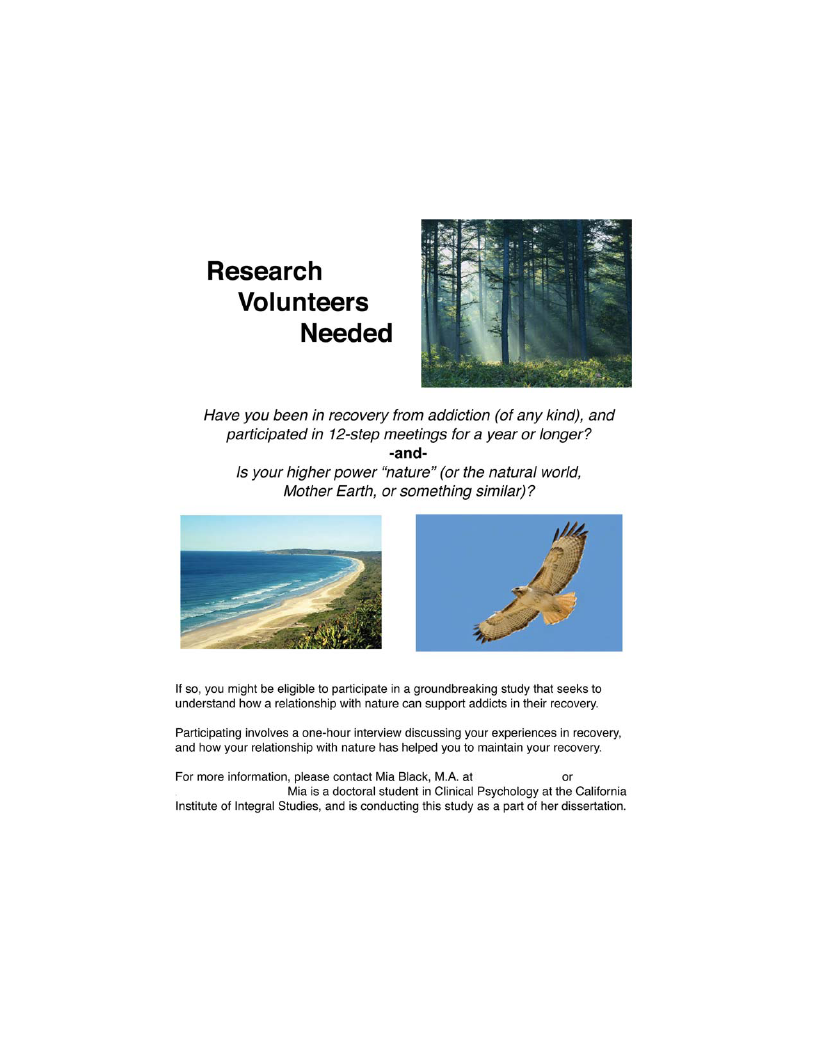
“THE TREES WERE OUR CATHEDRAL”—A NARRATIVE INQUIRY INTO
HEALING FROM ADDICTION THROUGH A RELATIONSHIP
WITH NATURE
by
Michelle Black
A Dissertation Submitted to the Faculty
of the California Institute of Integral Studies
in Partial Fulfillment of the Requirements for the Degree of
Doctor of Psychology in Clinical Psychology
California Institute of Integral Studies
San Francisco, CA
2015

ProQuest Number: 3743749
All rights reserved
INFORMATION TO ALL USERS
The quality of this reproduction is dependent upon the quality of the copy submitted.
In the unlikely event that the author did not send a complete manuscript
and there are missing pages, these will be noted. Also, if material had to be removed,
a note will indicate the deletion.
ProQuest 3743749
Published by ProQuest LLC (2015). Copyright of the Dissertation is held by the Author.
All rights reserved.
This work is protected against unauthorized copying under Title 17, United States Code
Microform Edition © ProQuest LLC.
ProQuest LLC.
789 East Eisenhower Parkway
P.O. Box 1346
Ann Arbor, MI 48106 - 1346

CERTIFICATE OF APPROVAL
I certify that I have read “THE TREES WERE OUR CATHEDRAL”—A
NARRATIVE INQUIRY INTO HEALING FROM ADDICTION THROUGH A
RELATIONSHIP WITH NATURE by Michelle Black and that in my opinion this
work meets the criteria for approving a dissertation submitted in partial
fulfillment of the requirements for the Doctor of Psychology in Clinical
Psychology at the California Institute of Integral Studies.
_____________________________________
Kaisa Puhakka, Ph.D., Chair
Core Faculty, Clinical Psychology
_____________________________________
Raymond Buscemi, Psy.D.
Licensed Psychologist PSY 22036

© 2015 Michelle Black

Michelle Black
California Institute of Integral Studies, 2015
Kaisa Puhakka, Ph.D., Committee Chair
“THE TREES WERE OUR CATHEDRAL”—A NARRATIVE INQUIRY
INTO HEALING FROM ADDICTION THROUGH A RELATIONSHIP
WITH NATURE
ABSTRACT
This qualitative study explored and analyzed the narrative experiences of
individuals whose spiritual relationships with nature have supported them in
overcoming addiction. This project sought to investigate the sparsely researched
intersection of ecopsychology and addiction recovery. Semi-structured interviews
were conducted among six participants to shed light on the question: How can
ecopsychological values and approaches help addicts to achieve and sustain
recovery?
I implemented a thematic analysis of the interview material, using a
multiphasic coding process to organize the common themes that surfaced across
participants’ narratives, as well as highlight distinct experiences. The results
yielded a total of 11 subthemes distributed among the following three master
themes: Evolving Relationship with Nature, Levels of Integration with Nature,
and Healing Effects of the Relationship.
Key findings from the study include the following: (a) all participants
reported feeling an innate connection with nature that began in childhood, which
in some cases, became less important as the years passed; (b) in seeking sobriety,
each of the participants connected with nature to serve as the higher power they
iv

needed in order to apply the 12-step approach in their lives; (c) this relationship
with nature has been central in helping participants to be successful in recovery;
over time, the relationship transcended the utilitarian purpose of “working the
program” and led to significant shifts in participants’ lifestyles and value systems;
(d) in sustaining this relationship, participants have woven nature into their lives
to varying degrees; many expressed that they generally yearn for more contact
with nature than their current lifestyle permits; and (e) participants found that
their relationships with nature resulted in deep healing that extended far beyond
addiction, and across physical, intellectual, emotional, and spiritual realms.
It is my hope that this initial study will lead to further research exploring
the value of incorporating nature into addiction treatment, as well as seeking
effective solutions to humankind’s increasingly addictive and exploitative
relationship with the natural world.
v

ACKNOWLEDGMENTS
I would like to express my gratitude to the many people who have
supported me during my journey on this long and winding road.
Most importantly, I would like to acknowledge the six participants of the
study, who made this research possible. Each participant offered a unique
perspective and shared memories of some very profound and moving experiences,
which greatly contributed to the richness of this project. To each of the
participants, I am deeply grateful for your willingness to openly and courageously
share your stories, and I hope to make this study available to a wider audience so
your experiences will inspire others.
From the beginning, it was my intention that this project would reflect my
highest values and best work. I was able to accomplish this thanks to a number of
tremendously supportive professional and personal relationships.
As my chair and advisor, Kaisa Puhakka guided me and helped me
connect with my own intuition throughout the dissertation process. Even before
the project began, I knew Kaisa as the professor who had enough faith in me to
hold me to unfathomably high standards, which caused me to push myself to my
limit and then take a few steps further. Kaisa, thank you for supporting me, and
above all thank you for challenging me in ways that have helped me grow
profoundly during grad school, and will continue to impact me for the rest of my
life.
As the external reviewer of this dissertation, Raymond Buscemi offered
valuable insights rooted in his many years of experience in addiction treatment.
vi

Raymond, thank you for contributing your dynamic thinking and sharp insights to
this project. Your deep appreciation for the subject matter truly enriched the final
result.
I would also like to express my heartfelt thanks to my family and friends.
To Ashley, my wonderful and loving partner, I’m profoundly grateful every day
to be walking beside you in this life, and learning and growing together. To my
sister and best friend Kathryn, thank you for being my partner in crime, making
me laugh when I’ve needed it most, and always being up for an adventure. I
would also like to thank my mother and father for supporting every wacky
endeavor I’ve ever taken on. I am grateful that from a young age you taught me
the value of education, and cheered me on at every milestone throughout grad
school. And to my dear friends Amy, Victoria, and Gus, I am so grateful for my
relationships with each of you. Thank you for walking with me on a spiritual path
and reminding me to stay connected with what’s most important.
vii

DEDICATION
I would like to dedicate this dissertation to all stewards of the Earth: Those
who are working to restore balance to the planet, those who live in reciprocal
relationship with the natural world, and those who practice the value of leaving
enough for the next several generations in order to ensure the survival of
humankind.
viii

TABLE OF CONTENTS
ABSTRACT……………………………………………………………………...iv
ACKNOWLEDGMENTS………………………………………………………..vi
DEDICATION…………………………………………………………………..viii
CHAPTER 1: INTRODUCTION…………………………………………………1
Research Topic and Purpose………………………………………………1
Definition of Terms……………………………………………………….3
CHAPTER 2: REVIEW OF THE LITERATURE………………………………..5
Part I: The Environmental Crisis and Ecopsychology…………………….5
The Emergence of Ecopsychology………………………………..5
The Contemporary Influence of Ancient Wisdom………………...8
Humans and Nature: Separation and Domination……………….12
Attachment Disorder with the Natural World……………………15
Psycho-Spiritual, Emotional, and Social Impacts………………..17
Research on The Human-Nature Relationship…………………..20
Applied Ecotherapy……………………………………………...22
Attachment Healing Through Contact…………………………...24
Culture-Wide Addiction & Its Environmental Impacts………….26
Part II: Addiction and Recovery…………………………………………28
The Cultural Context of Individual Addiction…………………...28
Scope, Diagnosis, and Progression of Addiction………………...29
Etiology of Addiction……………………………………………32
Recovery: More Than Abstinence……………………………….37
ix

The 12-Step Recovery Model……………………………………38
Healing Mechanisms & Outcomes of Recovery…………………39
Part III: Integrating Ecopsychology and Addiction Healing…………….42
Research on Ecotherapy and Addiction………………………….42
Addressing Root Causes of Addiction through Ecopsychology…43
Research Question……………………………………………….48
CHAPTER 3: METHODOLOGY…………………………………….…………50
Narrative Research……………………………………………………….50
Inclusion and Exclusion Criteria…………………………………………51
Procedure………………………………………………………………...53
Recruitment………………………………………………………53
Informed Consent & Participant Bill of Rights………………….54
Ethical Considerations…………………………………………...55
Data Collection…………………………………………………..55
Data Analysis & Interpretation…………………………………..56
Validity…………………………………………………………..58
Delimitations……………………………………………………..58
Limitations……………………………………………………….59
Assumptions……………………………………………………...60
CHAPTER 4: RESULTS……………………………………………………..….62
Participant Demographics………………………………………………..63
Theme I: Evolving Relationship with Nature…………………………....63
Initial Connection with Nature………………………………...…64
x

Separation from Nature…………………………………………..67
Reconnection Through Recovery………………………………..68
Transcending Recovery………………………………………….74
Theme II: Levels of Integration with Nature…………………………….77
Bringing Nature to Me…………………………………………...77
“Into the Wild”…………………………………………………...83
Reflections on the Relationship………………………………….85
Theme III: Healing Effects of the Relationship……………………...…..87
Physical…………………………………………………………..87
Intellectual and Philosophical………………………………...….93
Emotional and Psychological…………………………………...101
Spiritual……………………………………………………..…..107
Conclusion…………………………………………………………...…115
CHAPTER 5: DISCUSSION…………………………………………………...110
Summary of Findings…………………………………………………...118
Transcendence and Attachment Healing……………………….119
Ecotherapy, Ritual, and Wanting More……………………..….123
Deeper Healing……………………………………………...….126
Implications for Future Research…………………………………….....130
Concluding Narrative……………………………………………...……133
REFERENCES……………………………………………………………...….137
APPENDIX A: INFORMED CONSENT…………………………………...…151
APPENDIX B: PARTICIPANT BILL OF RIGHTS…………………………..154
xi

APPENDIX C: CONFIDENTIALITY STATEMENT…………………….…..155
APPENDIX D: FLYER……………………………………………………...…156
APPENDIX E: INTERVIEW PROTOCOL………………………………...….157
xii

CHAPTER 1: INTRODUCTION
There is a natural link between addiction recovery and ecopsychology,
though initially this connection may not seem apparent and has scarcely been
explored or researched. Ecopsychologists have cited population growth and our
addictive and exploitative relationship with the natural environment as the two
most impactful factors in the current ecological crisis (Erlich, 1995). Our culture
reinforces dissociation, and many of us remain “asleep at the wheel” in the face of
a dilemma that increasingly threatens the survival of our species (Glendinning,
1994).
As modernization has taken hold and swept us into the technological era,
feelings of dissatisfaction and meaninglessness along with mental illness and
addiction have become increasingly widespread (Hillman & Ventura, 1993).
Confusion abounds in Western culture, where certain addictive behaviors such as
consumerism and materialism are promoted (at the cost of decimating the natural
world), yet other types of addiction such as substance use are stigmatized. No
longer can we continue to address mental health and addiction issues solely as
problems of the individual, for we may in fact be helping individuals adjust to a
sick society (Fromm, 1990).
Research Topic and Purpose
Research in the newly emergent fields of ecopsychology, ecotherapy, and
ecospirituality have explored how these approaches can benefit individuals
struggling with anxiety, depression, PTSD, psychosis, dementia, and a slew of
other disorders, finding nature-based interventions to be highly effective
1

(Chalquist, 2009). Only a handful of studies have explored how ecopsychology
and similar nature-based approaches to healing might benefit individuals
struggling with substance and behavioral addictions, and this research tends to be
narrowly focused in terms of population and intervention (Annerstedt &
Wahrborg, 2011; Cornille et al., 1987; Haubenhofer et al, 2010; Selhub & Logan,
2012).
The interaction between ecopsychology and addiction recovery has yet to
be explored from a depth psychology–oriented, spiritual perspective. Sobriety-
based recovery groups such as Alcoholics Anonymous and Narcotics Anonymous
hold a spiritual component as central to their healing process, and whereas most
individuals in recovery believe in a traditional notion of God, many others create
their own unique conceptualizations of a “higher power” (Alcoholics Anonymous
[AA], 1939 / 2001). Among the more frequently identified alternative higher
powers are nature, music, the universe, and the recovery community at large
(Hazel & Mohatt, 2001).
The purpose of this narrative study is to explore the connection between
recovery and ecopsychological values and approaches, by collecting and
presenting personal stories from individuals in recovery who identify nature as
their higher power. This inquiry will offer a unique contribution to the field by
interviewing individuals in recovery who cite an emotional or spiritual
relationship with nature as a central facet of their healing process. The study seeks
to explore what we might learn from these individuals regarding overcoming
2

substance and behavioral addictions, as well as how, as a culture, we might
address our addictive, exploitative relationship with the natural world.
Definition of Terms
Ecopsychology: The study of the relationship between humans and the rest
of the natural world through both ecological and psychological principles for the
purpose of facilitating reconnection, thereby assisting individuals in developing
sustainable lifestyles and remedying alienation from nature (Roszak, 1992).
Ecotherapy: The applied practice of ecopsychological principles and
values for the sake of alleviating mental health issues; an umbrella term for
several types of nature-based therapy such as wilderness therapy, horticultural
therapy, and animal-assisted therapy (Clinebell, 2013).
Ecospirituality: Ecospirituality connects the science of ecology with
spirituality, bringing together spiritual practices and environmental activism.
Ecospirituality seeks to help people experience "the holy" in the natural world and
to recognize the relationship between human beings and all creation (Gore, 1993).
It shares much in common with indigenous beliefs, paganism, animism, and other
nature-based spiritual traditions.
Addiction: The continued repetition of a behavior despite adverse
consequences. The current edition of the Diagnostic and Statistical Manual (DSM-
5) recognizes substance addictions, such as drugs and alcohol, as well as
behavioral addictions, such as eating, gambling, sex, and shopping (American
Psychiatric Association, 2012; Jellinek, 1960).
3

Recovery: A process of community-supported transformation in which an
individual achieves abstinence from addictive behaviors, improved health,
increased well-being, newfound abilities, a different form of consciousness, and a
spiritual connection (White & Kurtz, 2006).
Higher Power: A term coined by Alcoholics Anonymous which refers to
an open-ended conceptualization of God, a spiritual force, or any tangible or
intangible entity greater than oneself (Anonymous, 1939 / 2001).
4

CHAPTER TWO: REVIEW OF THE LITERATURE
The following chapter provides a comprehensive review of the current
research on ecopsychology, addiction, and the intersection of these areas. The
literature review has been divided into three primary sections: The Environmental
Crisis and Ecopsychology, Addiction and Recovery, and Integrating
Ecopsychology and Addiction Healing.
Part I: The Environmental Crisis and Ecopsychology
Ecopsychology and ecospirituality have arisen relatively recently in
response to the contemporary emotional and ecological challenges with which we
are confronted. They hold that there is a “synergistic interplay between planetary
and personal well-being” (Roszak, 1992, p. 23). Mental health professionals have
been pivotal in creating psychologically informed solutions to the ecological
crisis, believing that reconnecting with the natural world is central to healing
ourselves and meaningfully addressing ever-intensifying environmental
challenges (Roszak, 2009).
The Emergence of Ecopsychology
Many years later, as he faced the firing squad, Colonel Aureliano
Buendia was to remember that distant afternoon when his father
took him to discover ice. At that time, Macondo was a village of
twenty adobe houses, built on the bank of a river of clear water that
ran along a bed of polished stones, which were white and
enormous, like prehistoric eggs. (Marquez, 2006, p. 1)
In the evocative first lines of Gabriel Garcia Marquez’s novel One
Hundred Years of Solitude, moments before his death a man reflects on a culture-
wide death experienced in his community when he was a child. The seemingly
harmless arrival of manufactured ice in his idyllic tropical village in fact marked
5

the onset of a dramatic shift. In a relatively short period of time, Macondo
transformed from a harmonious indigenous village to an industrialized, urbanized,
capitalist society—and in the process, their community, traditions, and
interrelatedness with nature unraveled.
Such a drastic turning point may sound personally unfamiliar to many of
us, yet nearly every culture across the globe has experienced a similar shift
relatively recently in human history. During the 10,000−15,000 years that Homo
sapiens have existed, we have evolved to live in direct relationship with nature
predominantly as hunter-gatherers and more recently as agriculturists (Frumkin,
2001; Herman, 2013). If a distance of 100 feet (approximately the length of a
basketball court) represents the entirety of human ancestry, only one-fifth of an
inch on this hundred-foot timeline marks the amount of time that we have lived in
industrial and technological civilizations (Glendinning, 1994). The assumptions
about life, reality, and the nature of man that today we accept as normal are in fact
severely misaligned with the ways in which we evolved during the past million
years (Glendinning, 1994; Herman, 2013).
“The astounding material success of the human endeavor hasn’t brought
happiness, wisdom, or enlightenment; instead, there’s a profound disturbance in
our collective human psyche. The best evidence of that disturbance is to be found
in our suicidal abuse of nature” (Anderson, 2009). The natural world is currently
being decimated at unprecedented rates, due to the increasingly global
consumerist value system demanding that we extract raw materials from nature
and transform them into saleable forms (Mander, 1992). We live dissociated from
6

the reality that what goes up must come down, believing in the capitalist promise
of indefinite growth rather than accepting the stark reality that our planet’s
resources are limited (Gray, 1995).
Some ecopsychologists have argued that engaging in therapy without
addressing the ecological crisis of our times and its impact on our wellness is, at
best, a harm reduction approach: “I felt as if I were a therapist on the Titanic. We
might be doing fine work in the therapy room, but nobody was mentioning the
sinking of the ship” (Rust, 2009, p. 39).
We are inseparable from the rest of nature, as a part of the greater
organism that is planet Earth (Buzzell & Chalquist, 2009; Hillman, 1995). “Salt
remnants of ancient oceans flow through our veins, ashes of expired stars rekindle
in our genetic chemistry” (Roszak, 1992, p. 319). Ecopsychology seeks to repair
the separation between humankind and the natural world, which requires an
“awakening to beauty, which often comes in the company of defeat and loss and
grief” (Robinson, 2009, p. 28), and would lead to a “fundamentally non-dual,
seamless unity in which both nature and psyche flow as expressions of the same
ground or source” (Harris, 2009, p. 87).
Seeking healing by living in direct relationship with plants and animals
has been encourages across eras and cultures (Dyer, 2002). Indigenous peoples
have used plant-based medicines for millennia, and Ayurvedic and traditional
Chinese medicine practices remain in use today. Even during the Victorian era, a
trip to the seaside was often prescribed as a factor in addressing physical and
emotional problems. Trees, plants, wild animals, and bodies of water have long
7

been considered to be filled with vital, healing energy that can be transferred to a
person (Selhub & Logan, 2012). “Everybody needs beauty as well as bread,
places to play in and pray in, where Nature may heal and cheer and give strength
to body and soul alike” (Muir, 1912, p. 256).
The Contemporary Influence of Ancient Wisdom
Time was not passing...it was turning in a circle. (Marquez, 2006, p. 272)
It is important to appreciate that while ecopsychology and ecospirituality
may be at the cutting edge of the mental health field, they are in fact a return to
the approaches and value systems of indigenous, nature-based peoples—cultures
who have lived in relationship with the forces and cycles of the natural world,
who have sustained themselves through a combination of hunting, fishing,
gathering, and scattering seeds, and who practice the value that the Earth is a
sacred place (Glendinning, 1994). In an attempt to legitimize itself as a science,
the nascent field of psychology cast out spirituality and traditional healing
methods. It is only during the past decade that there has been movement toward
reintegrating some of the nature-based approaches that were interwoven with
human culture for millennia (Abram, 1996; Roszak, 1992). Ecopsychology and
ecospirituality seek to integrate the deepest indigenous wisdom with the latest
scientific understandings of our universe (Buzzell & Chalquist, 2009).
Indigenous cultures existed across the planet for tens of thousands of years
(and in some remote corners, still exist today) without hierarchical classes or
slavery, and in relative comfort compared with many parts of the industrialized
world. Australian Aboriginal culture, for example, existed for at least 40,000
8

years unchanged prior to European colonization (Cowan, 1992). Indigenous
peoples live in solidarity with the lands they inhabit, and feel a reverence toward
the plants and animals with which they coexist (Abram, 1996). The first Neolithic
civilizations of Europe were peaceful, egalitarian, nature-worshipping and
goddess-worshiping societies (Herman, 2013). These cultures, which were much
smaller in scale and far less centralized than modern Western civilization,
maintained a relatively homeostatic relation with their local ecologies for vast
periods of time (Abram, 1996).
The practice of living in balance with the natural world and taking only
what one needs is fundamental to the indigenous way of life. Other central values
include respect for life in all forms, harmony with nature’s cycles, gratitude,
balance, and reciprocity (Gray, 1995). The Hopi believe that nature’s laws
mandate that land mustn’t be opened up for the sake of taking anything from
within in, and certainly must never be bought or sold (Mander, 1992). Alaska
Natives personify their surroundings, believing that the natural world feels, can be
offended, and must be treated with appropriate respect (Abram, 1996).
Perhaps most central to the indigenous way of life is the acute awareness
that nothing exists in isolation, and all is interconnected. The indigenous concept
of the self sees humans as inhabiting a larger living body (Rust, 2009). Australian
Aboriginals see land and self not as separate entities, but as a relationship in
which the more-than-human world is incorporated as part of an ecological self
(Ward & Styles, 2007). Similarly, Native American cosmology views the
9

individual as a part of all creation, living life as one system rather than in separate
units that are objectively relating with each other (Duran & Duran, 1995).
Relationships with the self, family, community, and the environment must
all be in balance in order to experience physical, mental, emotional, and spiritual
health (Gray, 1995). In !Kung society, if someone falls ill or a marriage unravels,
the responsibility does not fall on the individual; rather it’s an indication that
something is amiss between the community and the entire cosmos (Glendinning,
1994). Indigenous peoples make little distinction between levels of healing—
physical, spiritual, social, and cosmic. Health is achieved through the rebalancing
of what is imbalanced, and the reconnection of what has been separated. A
healthy mind requires a healthy body, which together depend on a healthy society
in harmonious relation to heaven and earth (Herman, 2013). Through this lens,
psychological dysfunction and the ecological crisis are one and the same
(Glendinning, 1994).
It is clear that this integrative, non-dual belief system lies in stark contrast
with Western, technological society. The Yurok people of Northern California
believe that nature’s balance was disrupted by people’s greed, which is the root
cause of most of the problems we face today (Glendinning, 1994). The idea of a
world existing for the purpose of human dominion and exploitation is a notion
that is absent in indigenous thinking (Duran & Duran, 1995). Natives traditionally
engaged in cooperative production, viewed nature as a living being, did not
practice private ownership of land, and had goals of subsistence. Technological
societies compete with one another, view nature as a resource to exploit,
10

commodify land, and seek to create a surplus for profit (Mander, 1992).
Colonization certainly played a role in this imbalance, forcing the value system of
“the conquering, displacing pioneer who moves around a lot but soaks up little
and tends even less” (Berry, 2003). Decolonization through the adoption of a
starkly different value system is essential to healing the planet as well as
ourselves (Glendinning, 2005b).
Today, human survival may depend on our ability to step lightly on the
planet, and observe its natural rules and modes of organization (Mander, 1992).
Ideally, we might integrate the wisdom of nature-based societies with the
achievement of the classical civilizations and the past 400 years of science and
industry (Herman, 2013). Michael Serres (1995) suggests creating a contract with
nature that acknowledges its rights as a living being with equal protection under
the law. Such an agreement would enforce a mutually beneficial, symbiotic
relationship between humankind and nature, putting an end to the parasitic
relationship that humanity currently holds with the natural world.
According to the Dalai Lama, only a spiritual revolution will enable us to
face the destruction of the planet without succumbing to cynicism, anger, burnout,
and despair (Thornton, 1996). For nature-based cultures, spirituality cannot be
separated from everyday life. Perhaps once we rediscover the spiritual
significance of nature, we will bring about a peaceful and harmonious relationship
with the natural world (Nasr, 1997).
11

Humans and Nature: Separation and Domination
The shift away from a nature-based way of life has had many
repercussions for humankind as well as the planet itself. The ecological
emergency we are faced with today is largely the result of our epidemic
dissociation from the impact of environmental issues—our implicit belief that we
somehow exist independently of nature rather than being immersed in and
interwoven with it (Clinebell, 2013). Ecopsychologists seek to understand the
origins of this separation from nature and ensuing superior attitude toward to the
rest of the natural world, for the purpose of learning how to repair this damaged
bond (Buzzell & Chalquist, 2009).
Some theorists suggest that the original separation between humans and
nature was marked by the transition from hunter-gatherer to agrarian societies.
Cultivating land and domesticating animals allowed people to remain in one
location rather than follow the migration of herds, which resulted in the creation
of more permanent shelters. A stark duality was established between “indoor” and
“outdoor.” Over time, the outdoors became associated with the wild, chaotic,
dangerous, soiled, and evil, whereas the indoors was perceived as tame, orderly,
safe, clean, and good (Glendinning, 1994; Shephard, 1992).
Dualities of this nature tend to be very tantalizing to humans, as we are a
self-conscious animal that lives “simultaneously as worms and Gods” (Becker,
1997, p. 51). Our animal bodies require nourishment and protection, yet our
higher consciousness is capable of transcending animal instincts, and is the point
of contact with God (Bunge, 2001). Our own death anxiety causes us to over-
12

identify with the God-like facets of ourselves, and to dissociate from decay, death,
and destruction not only within ourselves, but also in the natural world at large
(Becker, 1997; Matthews, 1994). Humans in permanent shelters were more
protected from the elements and wild animals, and it felt as if the threatening
facets of nature could finally be kept at bay. Land ownership and the development
of formal numbering and measurement systems resulted in the quantification of
land, which shifted our relationship with it and ultimately led to the
commodification of land and resources (Abram, 1996; Rousseau, 1992).
The rise of monotheistic religions replaced humankind’s belief in earthly
Gods—animal Gods, plant Gods, rock and water Gods, male and female Gods—
with a belief in one deity who resembles humans, and is perfect (Ehrenreich,
2014; Mander, 1992). The Book of Genesis in the Old Testament gives humans
dominion over the plants and animals on earth. Some have interpreted this
passage as a call to act as stewards of the earth, whereas others have used it to
justify anthropogenic abuses of the environment such as pollution and resource
exploitation: “We have dominion over the plants, the animals, the trees. God said,
‘Earth is yours. Take it. Rape it. It’s yours’” (Coulter, 2008, p. 104). One might
argue that such a detached and superior relationship with the natural world has all
the markings of narcissistic personality disorder (Robinson, 2009).
The Age of Enlightenment further complicated humankind’s relationship
with nature by favoring reason and skepticism over tradition, including
indigenous, nature-based practices (Kors, 2003). Touting the scientific method as
the only method came at a cost, for indigenous peoples had been using an
13

experimental trial-and-error approach for millennia. While some of their
approaches were superstitious, most were time-tested and highly effective (Gray,
1995). Indigenous people were painted as primitive, childlike, and savage
(Glendinning, 1994), and the dichotomy of civilized meaning “good” and “safe,”
and wild indicating “danger” and “evil” became more deeply carved in the
mainstream praxis. Today the pendulum has swung back to the center, and we see
that we are capable of rigorous thinking without forfeiting our sensory and
intuitive knowledge, our “animal kinship with the world around us” (Abram,
1996, p. 264).
After the Enlightenment, Darwin’s discoveries of natural selection and
evolution arose. While most scientists accepted these theories, the public was
“reluctant to relinquish the assumption of human specialness” (Abram, 1996, p.
78). Today we continue to cling to the belief that we are superior to all other
species on earth, in spite of ever-mounting evidence that certain animals possess
advanced cognitive, linguistic, and sensorial abilities, which in some cases
surpass those of humans (Chalquist, 2009).
The Industrial Revolution replaced farming with indoor work, causing
people to be more isolated from nature than ever before in human history. The
shift from local barter economies to consumerist, market economies resulted in
natural resources being exploited at unprecedented rates (Mander, 1992). “The
natural rhythms of our reactions gave way to industrial rhythms. We learned to
interact with mechanical speeds, as assembly line workers and most auto drivers
14

know. Now that machines move at electronic speeds, the wheel of activity turns
faster, with us on it” (p. 65).
Today in the age of corporate cyber globalism, “the system” permeates
everything but appears to be located nowhere, leaving individuals feeling
confused, unsettled, and helpless (Berman, 2001). Freud (1962) argued that
modern civilization is largely responsible for our misery, saying we would be
much happier if we returned to a primitive, land-based culture. He forewarned
that our greatest suffering would ironically be rooted in our attempts to avoid the
threats of nature.
Attachment Disorder with the Natural World
Original trauma is the disorientation we experience, however
consciously or unconsciously, because we do not live in the natural
world. It is the psychic displacement, the exile, that is inherent to
civilized life. It is our homelessness. (Glendinning, 2005b, p. 94)
Interwoven with this history of drastic cultural shifts is an extraordinarily
powerful psychological component. More than 99 percent of human evolution
occurred embedded in the natural world, in relationship with local plants, animals,
and terrain. Consequently, nature continues to have a fundamental role in our
cognitive, emotional, and spiritual development (Frumkin, 2001; Kellert &
Wilson, 1993). Similar to the bond between an infant and a primary caregiver, an
equally complex biological, psychological, and emotional attachment exists
between humans and the natural world (Louv, 2005; Shepard, 1992).
Psychologist Harold Searles argued that Freud’s writings (and those of his
successors) neglected to account for the influence of the environment on the
development of the human psyche (Searles, 1960). The relationship between
15

infant and caregiver is held within the even greater caregiving and holding force
of the natural world, which provides the sustenance that furthers life.
In the evolution of humankind this setting took the form of living plants,
wild birds, rain, wind, mud and the taste and texture of earth, and bark, the
sounds of animals and insects….These surroundings were swallowed,
internalized, incorporated as the self (Shepard, 1995, p. 27).
A secure attachment with the environment provides us with a sense of meaning
and of belonging (Louv, 2005).
Attachment theory indicates that one’s early attachment style strongly
shapes relationships later in life (Ainsworth, Blehar, Waters, & Wall, 1978). In
the ideal case of a secure attachment, consistent care and stimulation help an
infant learn to regulate feelings, and when ruptures in the bond occur they are
soon repaired (Bowlby, 1983). Unfortunately, the aforementioned ruptures in
humankind’s relationship with the environment resulted in the deterioration of
what once was a secure attachment with the natural world. Illuminating this inter-
generationally experienced disorganized attachment enables us to more deeply
understand our own “disregard for the very air we breathe,” (Abram, 1996, p.
260).
Avoidant and ambivalent attachment styles lead to trust issues, difficulty
relying on and feeling close with others, fears of abandonment, and a fundamental
belief that one’s basic needs will not be met (Klein, 1987). In the face of
helplessness, argues Klein, an infant will strive to feel almighty in order to gain a
sense of power and control in the midst of a terrifying situation. “The West is a
16

vast testimony to childhood botched to serve its own purposes, where history,
masquerading as myth, authorizes men of action to alter the world to match their
regressive moods of omnipotence and insecurity” (Shephard, 1992, p. 126).
Through an attachment lens, our attempts to dominate nature are an
enactment of our defenses. “If humankind is to flourish without destroying the
living world that sustains us, then we must grow out of our adolescent aspiration
to encompass and control all that is” (Abram, 1996, p. 272). Our deepest
vulnerabilities in the face of our dependence on nature and its indifference toward
us are reflected in our attempts to bring nature under our total control (Jordan,
2009). This deep wound prevents us from opening to our innate interdependence
with the natural world, as well as with one another.
Psycho-Spiritual, Emotional, and Social Impacts
This disturbance in our attachment with nature continues to be transmitted
inter-generationally throughout the world today, and is manifested broadly on a
cultural level as well as deeply on an individual basis. “Since 1600AD, and most
visibly since the Industrial Revolution, the West has been in a perpetual crisis, an
unstable society in a state of extreme alarm” (Berman, 1981, p. 297).
Ecopsychologist Paul Shepherd believes that Western industrialized humans
possess a flimsy identity structure that by Paleolithic standards would be
considered childish, and the consequence is a “readiness to strike back at a natural
world that we dimly perceive as having failed us” (Shephard, 1992, p.124).
Cultural and individual issues as diverse as crises of values, spiritual
confuse, social and economic inequities, racism and injustice, violence toward
17

one another and toward the environment, community and family dysfunction, and
mental illness and addiction can be traced back to our collective original trauma—
our division from the natural world (Clinebell, 2013; Glendinning, 1994). In
repressing nature’s destructive capacity and favoring light, reason, and
civilization, we attempt to suppress our own dark side. It seeps through the cracks
manifesting in human violence and destructiveness, often projected out onto the
environment (Matthews, 1994; Shepard, 1995). Our culture-wide denial enables
many of the global crises we face including famine, deforestation, pollution, and
extinction.
Without a secure attachment to nature, an inevitably resulting “ontogenetic
crippling,” or handicapping of our ability to reach our full developmental
potential freezes us in states of adolescent narcissism, oedipal fears, ambivalence,
and inconsistency (Louv, 2005; Shepard, 1995, p. 15). The absence of a feeling of
belonging and connection with our environment leads to profound
disembodiment, repression, loneliness, and disorientation (Glendinning, 2005b).
Feeling alienated from the self, community, and nature is dehumanizing and
breeds the insecurity, anxiety and guilt that inevitably arise “when human
separateness cannot be overcome” (Fromm, 1956, p. 80). These qualities are
witnessed in Sherry Turkle’s ongoing studies on children and teenagers who have
grown up in networked culture. Her research consistently finds that in spite of
technology’s promises to bring greater connection, an underlying fear of isolation
and abandonment pervades the lives of today’s youth (Turkle, 2011).
18

Dissociation seems to be the central defense mechanism that has enabled
us to move forward in spite of these deeply felt emotional and spiritual wounds.
Erich Fromm believes that a person who has remained sensitive and human rather
than become a cog in the great machinery of our capitalist, industrialist,
materialist culture will be unable to help but feel lonely, powerless, and isolated
in present-day society (Fromm, 1956). Ecopsychologist Larry Robinson asks,
“Why do these human machines keep breaking down, why do they develop
symptoms such as substance abuse, antisocial behavior, anxiety, phobias, and
depression?…Because human beings are not machines” (Robinson, 2009, p. 25).
There is a tendency in contemporary mental health to focus on symptom reduction
in individuals; however as clinicians we must be wary of the possibility that we
are helping clients adjust to a sick society rather than addressing the underlying
culture-wide illness that is at the root of individual distress. This shift might occur
one-on-one in therapy rooms, or could take shape as a greater socio-cultural
movement or even a revolution. A paradigm shift as such would seek to reshape
societal norms to support the qualities that are most fundamentally human, rather
than continuing to quash our humanness to become further enmeshed with
industry and technology.
Attachment disorder and dissociation also result in disembodiment. By
alienating ourselves from our natural state, “we have created a chasm between
ourselves and our own bodies. Like our relationship to the rest of the Earth, our
relationship to our bodies has become one of function and utility rather than one
of reverence and respect” (Morrison, 2009, p. 102). Sensation and perception are
19

gateways to our engagement with the “wild and animate earth,” and our fixation
with technology has led us to collapse the “sensorial reciprocity between our
breathing bodies and the bodily terrain” (Abram, 1996, p. 267). For example, each
time we cross a city street when the “walk” sign is displayed without looking to
see whether danger is approaching, we are relying on technology at the expense of
dulling our senses. Human awareness has folded in upon itself, as is witnessed in
our denial regarding our current ecological catastrophe which does not feel
personally impactful until it intensifies enough to be perceived by our senses.
Perhaps most painful of all are the oppressive dualities that have replaced
what was once a deep sense of interconnectedness, fluidity, and embeddedness in
the world: “matter and spirit, feelings and thoughts, yours and ours, us and them.
Walls around the heart parallel walls around the Other, barricading our experience
against what we fear and cannot tolerate” (Chalquist, 2009, p. 82). We are coming
to understand that “falling asleep” to our problems only exacerbates them, and our
only way out of this mess is to take an honest look at the heart of the matter.
Research on The Human-Nature Relationship & its Impact on Mental Health
In response to these struggles, ecopsychology and ecospirituality research
seeks to rigorously support the intuitive sense that spending time around plants
and animals brings feelings of balance and relief from everyday stressors,
alleviates a range of mental health symptoms, and rekindles a sense of belonging
in the natural world (Chalquist, 2009).
Research consistently finds that our environments have a tremendous
impact on our physical, emotional, and psychological state. The presence of trees
20

and plants, particularly in wilderness environments untouched by the humans, are
found to enhance mental health, while manicured environments have the opposite
effect (Kaplan & Kaplan, 1989; O’Brien, 2005). When urban children were asked
to make a drawing of their favorite place, nearly all the drawings were of outdoor
spaces such as lawns, playgrounds, trees, parks, and gardens (Moore, 1986).
Several studies have found that contact with nature is central to our ability to
maintain and restore positive psychological mood states (Kaplan, 1995; Shibata &
Suzuki, 2001, 2004; Van den Berg, Hartig, & Staats, 2007).
Incorporating facets of nature into human-made environments has shown
positive results. For example, adding plants to an office boosts creativity and
decreases the amount of sick leave employees take (Selhub & Logan, 2012). In
hospital settings, the presence of interior plants, or a window that looks out onto
natural scenery led patients to experience less anxiety, a shorter recovery time,
and declined painkiller use (Chalquist, 2009; Herman, 2013).
Many studies have focused specifically on depression, finding that outdoor
exercise proves as effective as taking anti-depressants, whereas walking through a
shopping mall has been shown to raise stress and lower self-esteem (Chalquist,
2009). Participants who took vacations in the wilderness demonstrated positive
affective states, improved cognitive performance, and calm physiological states,
as compared with people who took urban vacations or no vacation at all (Hartig,
Meng, & Evans, 1991).
Nature counters the emotional and physiological effects of stress. Simply
looking at a photograph of a nature scene as opposed to an urban scene for 20
21

minutes lowers heart rate (Selhub & Logan, 2012). Completing mental activities
in a garden results in significantly lower levels of cortisol being released than
doing mental activities in an indoor classroom (Selhub & Logan, 2012). Several
studies found that after taking a stressful exam, looking at photos of nature
decreased muscle tension and feelings of anger and aggression in students,
whereas looking at urban scenes had the opposite effect (Ulrich et al., 1991). One
study found that the presence of plants in a room enhanced recovery from
watching a stressful video, helping to bring EEG beta wave activity back to
normal (Selhub & Logan, 2012). Depression and stress accelerate the aging
process of the brain, and being exposed to nature reshapes our plastic brain and
can influence the production of neurotransmitters responsible for maintaining
cognitive health throughout the lifespan (Selhub & Logan, 2012).
Environmental psychology supports the harmonious design of buildings,
rooms and landscapes, but many theorists believe this type of band-aid approach
is more often the problem than the solution when it comes to our alienation from
nature (Roszak, 2009). Having potted plants in the office as opposed to immersing
oneself among wild plants and animals might be considered a harm reduction
intervention. Regardless, the research finds time and again that increasing the
presence of plants and animals in any environment facilitates healing and fosters
well-being.
Applied Ecotherapy
Ecotherapy is defined as the practical application of ecopsychological and
ecospiritual research and theory. It is an umbrella term for nature-based methods
22

of physical and psychological healing that are founded in healthy interaction with
the earth (Buzzell & Chalquist, 2009; Clinebell, 2013).
In wilderness therapy, a group expedition into the wilderness serves as a
mental health intervention. Meta-analyses indicate a high efficacy of wilderness
therapy, finding that it improves self-esteem and clinical functioning, increases
internal locus of control, and decreases problem behaviors (Cason & Gilis, 1994).
Specifically in studies with juvenile delinquents, wilderness therapy has proven
more effective than traditional therapeutic programs in promoting self-esteem,
positive behavior changes, and interpersonal skills (Chalquist, 2009).
The efficacy of horticultural therapy, which involves participating in
gardening projects to achieve specific therapeutic treatment goals, has been
supported by numerous studies (Chalquist, 2009). It has been found to curtail
stress and obesity, aid in treating alcoholism and substance abuse, foster
emotional restoration, enhance self-esteem in partially blind adults and children,
ease the shock of displacement and resettlement for refugees, support healthcare
providers struggling with burnout, and diminish social isolation and enhance
emotional expressiveness in the elderly (Annerstedt & Währborg, 2011; Gigliotti,
Jarrott, & Yorgason, 2004).
Animal-assisted therapy is stemmed in the biophilia theory. Biophilia
suggests that our attachment to animals is rooted in the history of human survival
as being partly dependent on signals from animals in the environment, who
helped us to determine whether an environment was safe or threatening (Kellert &
Wilson, 1993). After spending time with a dog, Alzheimer’s patients experienced
23

decreased loneliness, agitation, aggression, and lethargy, and better nutritional
habits, healthy weight gain, and greater alertness and social interaction (Chalquist,
2009). Equine therapy has proven effective in addressing symptoms of depression
and anxiety, helping children with autism to better communicate, and alleviating
PTSD symptoms (Burgon, 2014; DeMayo, 2009). Dolphin therapy, involving
playing and snorkeling with dolphins and relaxing on the beach, showed a
significant decrease in depression compared with a control group who relaxed on
the beach and snorkeled (Antonioli & Reveley, 2005). After working with farm
animals twice a week for 12 weeks, clients diagnosed with a range of disorders
including schizophrenia, anxiety, affective disorders, and personality disorders
showed improvement in coping ability, self-efficacy, symptom reduction, and
improved quality of life (Chalquist, 2009).
In sum, direct contact with plants and animals alleviates unpleasant
emotional and psychological symptoms, and enhances well being. Incorporating
plants and animals into the human-made world yields positive results; however
most effective are the approaches that foster a relationship between humans and
the wilderness, so that we may experience a sense of reconnection and more
deeply heal our severed bond with the natural world.
Attachment Healing Through Contact
I feel like I am spread out over the landscape and inside things, and
am myself living in every tree, in the splashing of the waves, in the
clouds and the animals that come and go, in the procession of the
seasons. (Jung, 1965, p. 252)
Attachment research has found that an insecure attachment can be healed
through intimate contact, by experiencing a secure attachment in a holding
24

environment (Solomon, 2003). It is only by repairing our disrupted attachment
with nature that we will be able to reestablish harmony with the natural world and
with our own deep selves (Hillman, 1995). A self rooted in healthy attachments to
human and nonhuman worlds leads to emotional wellness and stable adjustment,
and this positive contact with nature facilitates symbiotic healing (Clinebell,
2013; Spitzform, 2001).
Opening ourselves to a deeper relationship with the natural world comes
with significant psychological and emotional challenges. The Hindu goddess Kali
is a more appropriate archetypal image for the natural world than that of the
attuned caregiver, for nature does not privilege life over death and is equally
likely to destroy life as it is to sustain it (Puhakka, 2013). Similar to arriving at
Klein’s “depressive position,” (Klein, 2002) we must come to terms with the
destructive and dangerous facets of nature and integrate them with its creative,
life sustaining aspects. We must also accept our vulnerability, mortality, and
relative insignificance as individuals and even as a species.
Refining our senses and becoming re-embodied is one of the most simple
and straightforward ways we can open up the process of reconnection, as our
bodies are the most direct link to the natural world: “It takes an awakening of the
senses, which is only possible when we fully inhabit the body. An effective
ecotherapy must continually engage the body, because that is the basis of our life
and the source of our connection” (Robinson, 2009, p. 28).
Simply put, it is time that we stop behaving as if we are nature’s damaged
children, and take responsibility for our own healing and maturation processes.
25

We must develop what Martin Buber would call an “I-thou” relationship with the
natural world (Buber, 1970), in which we live in a realm of interacting
subjectivities rather than exploiting the environment as an inanimate object. “In
such a relationship, we and the world come alive and neurosis melts away”
(Robinson, 2009, p. 28).
Culture-Wide Addiction & Its Environmental Impacts
As ecopsychology and indigenous transitions indicate, in order to reach
our full potential as humans we must live embedded in a community, be in
relationship with plants and animals, and feel connected to a place. We can
survive without these bonds, but we often feel a sense of profound emptiness that
we attempt to fill in a variety of unhealthy ways (Buzzell, 2009). In the Western
modernized world (and other areas of the globe that are rapidly Westernizing), we
are bombarded with messages that teach us to fill this void by consuming: “Man’s
happiness today consists of having fun, and having fun lies in the satisfaction of
consuming and taking in....Spiritual as well as material objects become objects of
exchange and of consumption” (Fromm, 1956, p. 80). Americans are urged
through ubiquitous advertising to construct their identities and be positive
economic actors through consumerism (Acker, 1993). We are constantly
delivered messages that the feeling of something missing or lacking can be
remedied by acquiring products and experiences. When the fulfillment derived
from these acquisitions proves to be only temporary, feelings of emptiness return
and the cycle perpetuates (Robinson, 2009).
26

Anne Wilson Schaef first presented the radical idea that the society in
which we live is an “addictive system” (Schaef, 1987, p. 4). Indeed, our culture-
wide obsession with consumerism and materialism bears all the markings of an
addiction: insatiability, compulsivity, denial, omnipotence, and an implicit belief
in limitless supply (Campbell, 2010).
The overwhelming ‘need’ in the West for non-essential consumables, with
the ensuing loss of personal well being, increasing environmental
degradation, and the loss of native land-based lifestyles worldwide,
does…qualify as addiction, as much as the misuse or abuse of drugs or
alcohol (Fish, 2009, p. 47).
Similar to an alcoholic or drug user destroying his or her own body in the
throes of addiction, consumerism has wreaked havoc on our earth home. “The
disharmony in our relationship to the earth, which stems in part from our
addiction to a pattern of consuming ever-larger quantities of the resources of the
earth, is now manifest in successive crises” (Gore, 1993, p. 223). He goes on to
cite the loss of acres of rain forest every second, the acceleration of the natural
extinction rate, the thinning of the ozone layer, and the possible destruction of the
climate balance that makes our earth livable. Given this cultural and global
context, attempting to explain addiction as an isolated problem experienced by
certain individuals would be incomprehensive. To understand the ecological crisis
as well as individual addiction, we must take into account our culturally
sanctioned addictive behaviors and their dire impact on the natural world on
which we so intimately depend.
27

Part II: Addiction and Recovery
“It is better to conquer yourself than to win a thousand battles. Then the
victory is yours. It cannot be taken from you, not by angels or by demons, heaven
or hell” (Byrom, 2011, p. 8).
The Cultural Context of Individual Addiction
Our embeddedness in a culture that essentially encourages addiction to
consumption lays the groundwork, to a large degree, for addictions in individuals.
In a society that expects its members to be effective consumers, messages pushing
unregulated consumption and out-of-control behavior resonate powerfully (Acker,
1993, p. 203). Acknowledging that substance and behavioral addictions are more
extreme versions of modern-day consumerism illuminates the unconscious
dynamics underlying addiction (Zoja, 1989).
In addition to explicitly promoting addictive behavior, Western free-
market societies inevitably dislocate people from traditional sources of
psychological, social, and spiritual support. The resulting isolation is a central
precursor to addiction (Alexander, 2000). Similarly, Victor Frankl suggested that
drug and alcohol abuse are symptoms of a collective sense of meaninglessness
and purposelessness (Frankl, 1985). The existential crisis he depicts is ubiquitous
in industrial and technological societies.
Regardless of the tremendous cultural shifts experienced in recent
centuries, certain aspects of a nature-based way of life remain with us—one in
particular is the need for rituals. In most traditional societies including indigenous
Europe, the primary functions of consciousness-altering substances have been
28

positive, symbolic, and generally restricted for ceremonial use (Jellinek, 1977).
The symbolic or ritualistic quality of drinking and drug use practices are still
prevalent in Western society today, though without the structure and support
necessary to facilitate a spiritual experience (Adler, 1991). Our ancient need for
sacred rituals remains, yet there has been a loss of division between the sacred
and the profane (Zoja, 1989). We no longer uphold the communal systems that in
the past “provided context and ritual whereby life was given meaning and reason”
(Severns, 2004, p. 162), leading our relationship with substances to devolve into
one of abuse and imbalance.
Scope, Diagnosis, and Progression of Addiction
Addiction is running from reality…the reality you have that
something is stronger. Something that’s greater than you. Instead
of admitting it and saying that something scares me—this thing
scares me, or I don’t know how to do this, or I don’t know how to
live—instead of just saying that, you do drugs. So you coexist with
the people that are nonexistent. (Maté, 2010, p. 344)
Addiction is a disease that leads to a process of “nonliving” that is
progressively death-oriented (Schaef, 1987). The Narcotics Anonymous basic text
describes addiction as surrendering one’s life to a substance with the dedication of
a servant to a master (Anonymous, 1988). Put simply, addiction is an excessive,
unhealthy, dependency that disintegrates and destroys (Maté, 2010). Addiction
ultimately results in a life completely out of control—vacillating between feeling
worthless and feeling invincible; being unable to acknowledge and express
feelings appropriately; prioritizing addictive behaviors over family, job, and
health; and failing to take personal responsibility for one’s problems
(Glendinning, 1994).
29

Approximately 16.7%, or 22 million individuals in the United States
develop a drug or alcohol problem at some point in their lives (Regier et al.,1990;
Substance Abuse and Mental Health Services Administration [SAMHSA], 2011).
Over a third of these individuals are dually diagnosed, meaning they have a co-
occurring mental health disorder (Regier et al., 1990).
Alcoholics Anonymous defines addiction (to drugs or alcohol) as an
inability to control the amount an individual consumes, and a powerlessness to
maintain abstinence even with knowledge of loss of control (Anonymous, 1939 /
2001). The World Health Organization divides problematic and non-problematic
substance use into four categories: “Unsanctioned Use” is the use of a substance
that is not approved by one’s society. “Hazardous Use” is the use of a substance
that involves risky behavior and will probably lead to harmful consequences for
the user, such as smoking one pack of cigarettes a day. “Dysfunctional Use” is the
use of a substance that leads to impaired psychological or social functioning, such
as marital problems or being fired from a job. At the most extreme end of the
spectrum, “Harmful Use” is the use of a substance that is known to cause tissue
damage or mental illness (Kleber, 1990, p. 59).
The DSM-5 expanded the definition of addiction to include non-substance
related behavioral addictions such as shopping, gambling, and internet use.
Additionally, it replaced the prior categories of substance abuse and substance
dependence with a spectrum of measures of severity: mild (two to three
symptoms), moderate (four to five symptoms), and severe (six or more
symptoms) (American Psychological Association [APA], 2012).
30

The 11 substance use criteria are as follows: taking the substance in larger
amounts or for longer than the you meant to; wanting to cut down or stop using
the substance but being unable to; spending a lot of time getting, using, or
recovering from use of the substance; feeling cravings and urges to use the
substance; failing to take care of your work, home or school responsibilities due
to substance use; continuing to use when it causes problems in relationships;
giving up important social, occupational or recreational activities because of
substance use; repeatedly finding yourself in dangerous situations relating to
substance use; continued use with the awareness that you have a physical or
psychological problem that might have been caused or made worse by the
substance; needing more of the substance to get the effect you want (tolerance);
and development of withdrawal symptoms, which can be alleviated by taking
more of the substance (APA, 2012).
The expansion of the definition of addiction includes any drug associated
with compulsive use or dependence, as well as any kind of impulsive or
destructive behavior (Milkman & Sunderwirth 1987). Behavioral addictions are
similarly destructive to physical health, psychological well-being, and
interpersonal relationships (Maté, 2010). This more-encompassing definition also
helps to address the issue of transfer addictions, in which a person achieves
sobriety from one specific addiction but suddenly develops another type of
addiction. It also accounts for the fact that all addictions, whether to substances or
to behaviors, involve the same brain circuitry and chemicals (Maté, 2010).
31

Research clearly indicates that problematic substance consumption
inevitably results in progression of use (Jellinek, 1960). In relatively rare cases,
addicts have been able to control or lessen their substance use or addictive
behavior. However this phenomenon has occurred specifically among those who
have shown mild to moderate symptoms (previously referred to as substance
abuse), rather than severe symptoms (also known as substance dependence)
(Vaillant, 2003).
Research clearly indicates that symptoms worsen over time unless one
becomes completely abstinent. As use progresses, there is a symbolic line that,
once crossed, renders one incapable of using substances in moderation at any
point in the future (Vaillant, 2003). This is predominantly due to alterations in the
brain that occur as a direct result of addiction. Repeated drug use results in lasting
changes in the brain that undermine choice and control (Volkow & Li, 2004).
Recreational drug use may be volitional, but once a more deep-seated addiction
develops, control diminishes.
Etiology of Addiction
Neurological research has found that humans and animals have an
intoxication drive that is as fundamental to human functioning as is the sex drive
(Siegel, 1989). However whereas most people are able to moderate their
intoxication experiences, some are far more likely to develop an addiction. The
DSM-5 recognizes that people are not all equally vulnerable to developing
substance related disorders, and that some individuals have neurological
differences that predispose them to developing an addiction (APA, 2012).
32

Through the mid 1900s, it was believed that alcoholics were simply
morally depraved people who intentionally existed on the fringes of society in a
state of perpetually altered consciousness (Schaef, 1987). Dr. Benjamin Rush first
introduced the disease concept of alcoholism in the 1870s, asserting that chronic
drunkenness is a progressive medical condition (White, 1998). To some degree, it
served to depathologize addiction as a moral issue. However it wasn’t until 1960
that physician Jellinek’s research on addiction more thoroughly supported the
disease concept of alcoholism. For the next several decades, his findings informed
much of the research on and treatment of addiction (Jellinek, 1977). More
recently, neurobiologists have found addiction to be a dysfunction of the reward
circuitry of the brain, adding a new dimension to the disease model (Erickson,
2009; Nestler & Malenka, 2004).
A long-standing debate in the field of addiction studies has sought to
determine whether the biological basis of addiction is rooted in genetics, or in
brain differences shaped by one’s early childhood environment. Extensive
research (including twin studies) indicates that like most nature-nurture debates,
both genetics and environment play significant roles in brain development (Maté,
2010). In many cases these factors compound one another, for an individual
growing up with family members who struggle with addiction is more likely to
experience trauma such as abuse, or neglect (Hogan, 1998; Jaudes, Ekwo, & Van
Voorhis, 1995). Childhood trauma is highly correlated with diminished executive
functioning and impulse control, resulting in a susceptibility to addiction (Schore,
2001).
33

The environment undoubtedly plays a significant role in shaping brain
development and ability to self-regulate, particularly in early childhood (Siegel,
2007). A child’s newly forming capacity to handle psychological stress is
completely dependent upon its relationship with its caregivers, which in turn
depends upon the ability of the caregivers to self-regulate (Perry & Pollard, 1998).
A consistently misattuned caregiver will lead an infant to ultimately
possess a diminished capacity for self-regulation, which is a direct precursor to
addiction (Felitti, 2003; Rado, 1933). “The three dominant brain systems in
addiction—the opioid attachment-reward system, the dopamine-based incentive-
motivation apparatus, and the self-regulation areas of the prefrontal cortex—are
all exquisitely fine-tuned by the environment” (Maté, 2010, p. 197). In adulthood,
those who historically struggled to establish emotionally regulating attachments
are more inclined to turn to drugs and alcohol to experience relief from their
deficiency in intimacy (Flores, 2011).
Trauma experienced at any point in life can contribute to the development
of an addiction. Both animals and humans have been found to use drugs in order
to cope with inhuman conditions, regardless of their psychological inclination
toward addiction or the addictive properties of the substance (Alexander, Coambs,
& Hadaway, 1978; Alexander, Hadaway, & Coambs, 1980). In the aftermath of a
traumatic experience, if the psyche cannot find its way to healing it searches for
any way to self-medicate in order to numb PTSD symptoms and avoid emotional
pain (Glendinning, 2005a; Herman, 1992; Khantzian, 1985).
34

In the 1950s, the newly emergent school of behaviorism explained
addiction purely in terms of social learning and operant conditioning (Skinner,
1953). Whereas today we understand addiction through a wider lens, there are
undeniably many behavioral factors at play. Researchers have found that many of
the environmental cues surrounding ones addiction trigger dopamine release,
which leads users to feel a rush simply from obtaining and preparing the
substance (Maté, 2010). Indeed, many addicts report that they are equally afraid
of giving up the activities and relationships surrounding drug use as they are of
giving up the substances themselves. As previously mentioned, behavioral
addictions such as gambling, sex, or shopping alter brain chemicals even though
no substances are ingested (Maté, 2010).
Many sociologists have tended to favor a more socio-cultural explanation
for addiction rather the disease model (Szasz, 1985). These theorists have
highlighted our culture’s tendency to encourage certain addictive behaviors such
as consumerism, yet shun others such as substance use (Room, 1983). These
contributions led to the integration of several addiction theories, resulting in the
biopsychosocial model. This model, which is widely accepted and utilized in
addiction research and treatment today, sees addiction as a resulting from a
combination of genetic, environmental, and societal factors (Engel, 1977; Peele,
1986). Similar to the diathesis-stress model of mental illness, the biopsychosocial
model paints the “addiction syndrome” as a genetic vulnerability to addiction that
is activated by various psychological and social factors (Shaffer et al., 2004). The
35

biopsychosocial model is supported by the APA, and is applicable to behavioral
addictions as well as substance addictions.
From a phenomenological standpoint, addiction has long been explained
as a misguided attempt to fill a deep spiritual void within. This perspective sees
incompleteness as the basic state of the addict—a feeling of being ill-equipped to
face life’s demands (Maté, 2010). Carl Jung, who heavily influenced the
philosophy of AA through his letters with founder Bill Wilson, believed that
when Gods are banished, they return as symptoms (Addenbrooke, 2011). Other
theorists have described addiction as a hunger for ecstatic connectedness and
wholeness (Wilshire 1998); a spiritual emergency that contains within it the seeds
of transformation (Grof, 1994); and a quest similar to that of a mystic in his
search for enlightenment (Zoja, 1989). “Alcoholics want to know who they are,
what life is about, whether they have a divine origin, and whether there is a
system of cosmic justice and love” (Grof, 1994, p. 105).
Unfortunately due to the inevitable tendency of any addiction to spin out
of control, what might have begun as an impulse toward personal and spiritual
growth becomes obscured by “a growing self-destructive and misguided
obsession with a substitute” (Grof, 1994, p. 107). Whereas the object of the
addiction may have initially felt fulfilling, it can never provide the deeper
satisfaction and sense of wholeness the seeker initially longed for. This
disappointing reality combined with the self-perpetuating nature of addiction
leads many people to continue down the addiction spiral, still holding onto the
illusion that wholeness and spiritual connection will one day be delivered, yet
36

accelerating in the wrong direction. This tragic compulsion is shielded from
awareness by denial: pretending everything is normal, being unable to admit pain
or vulnerability, and holding up appearances at all costs (Glendinning, 1994).
Recovery: More Than Abstinence
Healing from a severe addiction involves engaging in a lifelong process
known as recovery, which entails far more than simply achieving abstinence from
substances or addictive behaviors. The harm reduction approach seeks to achieve
some semblance of safety for people who are active in their addiction (Denning &
Little, 2011), and the moderation management approach aids individuals with
mild to moderate addictions in decreasing their use (Humphreys, 2003). This
study will focus exclusively on the recovery approach, which is most appropriate
for individuals with severe cases of addiction hoping to achieve lifelong sobriety
(White & Kurtz, 2006).
An addict who stops using substances without achieving the deeper
transformations brought about by recovery is colloquially referred to as “dry,” and
is considered to be at a high risk of relapse because they have addressed the
underlying causes of the addiction (McLellan, McKay, Forman, Cacciola, &
Kemp, 2005; Metzger, 1988). Recovery is a process of community-supported
transformation in which an individual achieves abstinence, improved health,
increased well-being, newfound abilities, a different form of consciousness, and a
spiritual connection (Anonymous, 1939 / 2001; SAMHSA, 2007).
Researchers have explored different phases of recovery, finding that the
recovery process mirrors an individual’s prior decline into addiction in reverse,
37

with changes occurring across several dimensions (Bacon, 1973; Brown, 1985).
Some researchers have delineated phases such as early recovery and sustained
recovery (Bean, 1975), whereas others have created a series of specific stages,
specifically pretreatment, stabilization, early recovery, middle recovery, late
recovery, and maintenance (Gorski, 1986). Progression through the stages leads to
marked physical, behavioral, and psychological changes.
The 12-Step Recovery Model
Alcoholics Anonymous pioneered the recovery model and the 12-step
sobriety-based approach. Since its founding in 1935 it has grown into a loose-knit
worldwide organization, and has branched off into similarly structured groups
centered around addiction to narcotics, overeating, sex, gambling, and other
substance and behavioral addictions (Zweben, 1995). Whereas some of these
groups have modernized the original language, the 12 steps and focus on
spirituality remain the same. There are currently approximately 1.3 million
members participating in 12-step groups in the United States (Anonymous, 2012,
p. 1).
Whereas having a spiritual connection is central to the 12-step approach,
the concept of “higher power” may be loosely defined based on individual
preferences (Anonymous, 1939 / 2001). The membership includes followers of all
major world religions, as well as significant numbers of atheists and agnostics
(Kurtz, 1979; Zwebin, 1995). Some frequently used conceptualizations of “higher
power” include God, the universe, humanity, nature, music, and the 12-step
community. This open interpretation of higher power is a centrally held value of
38

AA, in addition to values of inclusivity and non-judgment as well as
encouragement of self-discovery and personal process.
Healing Mechanisms & Outcomes of Recovery
In his communications with Bill Wilson, the founder of AA, Carl Jung
wrote that treating a chronic alcoholic is hopeless. He believed that in rare cases,
recovery could be possible if the alcoholic underwent a spiritual transformation
(Jung, 2006). Jung’s words struck a chord with Wilson, along with the writings of
William James, and he ultimately underwent his own spiritual transformation and
overcame his alcoholism. In a letter, Wilson wrote:
It is the experience of many of us in early stages of drinking to feel
that we have had glimpses of the Absolute and a heightened
feeling of identification with the cosmos. While these glimpses and
feelings doubtless have a validity, they are deformed and finally
swept away in the chemical, spiritual, and emotional damage
wrought by alcohol itself (as cited in Grof, 2004, p. 105).
After experiencing his own transformation, Wilson created the 12-step approach
as a guide to recovery and spiritual reconnection (Finlay, 2000).
Dante Alighieri’s work The Divine Comedy, an epic journey to hell and
back, is an allegory for the devastating experience of addiction, the arduous
process of recovery and healing, and the experience of ultimately uniting with a
divine presence (Alghieri, 2003). Perhaps most central to the recovery process is
the addict’s ability to transcend his/her own ego as well as the addictive substance
by cultivating a personal relationship with a “higher power” which is greater than
both the individual and the addiction (Metzger, 1988). The 12-step program is
designed to address the “soul sickness” or “spiritual bankruptcy” of the addict by
39

facilitating a personally transformative spiritual experience (Grof, 1994; Haynes,
1988; Moran, 2003; Washton, 1995).
Indeed, having a spiritual life is a significant facet of what it means to be
human, as is evidenced across world cultures. “Throughout history, the
connection between the divine and the individual or the community has been
encouraged and celebrated in a multitude of ways, through various forms of
spiritual practice, rituals, and creative expression” (Grof, 1994, p. 15). Psychiatrist
and social critic Thomas Szasz (1985) has pointed out the commonalities between
addiction rituals and sacred or religious rituals, further supporting the theory that
addiction is an attempt to fill the spiritual void created by our modern way of life.
If addiction is a journey into spiritual death, recovery is a spiritual rebirth (Zoja,
1989).
Research on the process of achieving long-term sobriety has found AA’s
spiritual component to be most central to its success as the most effective
approach to facilitating sustained recovery (Kelly, Stout, Magill, Tonigan, &
Pagano, 2011). Hansen, Ganley, & Carlucci (2008) identified the interaction
between the factors of spirituality and community support to be at the core of the
12-step model’s transformative ability. Recovering addicts who participated in
12-step groups and reported higher levels of spiritual connectivity were found to
be more optimistic, experience less stress and anxiety, and have greater social
support (Pardini, Plante, Sherman, & Stump, 2000).
In addition to the spiritual facet, 12-step groups foster healing by
providing unwavering community support as well as encouragement to change
40

problematic behaviors. The 12-step program draws from oral traditions, featuring
storytelling as the main component of meetings (Humphreys, 2000). Sharing
personal stories aids individuals in integrating spiritual experiences, asking for
help and advice, experiencing non-judgment, and practicing inter-dependence
(Cheever, 2005; Kurtz & Ketcham, 1992).
Over time, the supportive interpersonal connections experienced in 12-
step groups serve to heal the attachment and self-regulation issues that addicts so
frequently suffer. An interpersonal landscape that was previously defined by
isolation or codependence can evolve into one of healthy attachment, inter-
dependence, and self-regulation (Flores, 2011).
The development of an increased capacity for self-regulation is greatly
aided by mindfulness, an approach that has been adopted by many 12-step groups
in recent years (Witkiewitz, Marlatt, & Walker, 2005). Recent neurological
research indicates that neuroplasticity continues throughout the lifespan and
though it declines with age, is never completely lost (Kempermann, Kuhn, &
Gage, 1998). Positive brain development can be induced through an enriched
external environment (Kolb & Whishaw, 1998), or by modifying the internal
landscape—specifically through mindful awareness. Mindfulness, or a meta-
cognitive ability to step outside of one’s thoughts and observe them, unlocks the
automatic patterns that encumber the addicted brain (Maté, 2010) and aids addicts
in developing the ability to self-soothe without the aid of substances.
In addition to regular 12-step meetings, many recovering addicts also
attend individual therapy. A therapeutic relationship provides a more
41

individualized space for healing, and can be fundamental in helping an addict to
resolve past trauma, address early childhood attachment disorders, develop the
ability to self-regulate, and expand capacity to tolerate a range of emotions.
The healing effects of reconnecting with the natural world, as described by
ecopsychology theorists and practitioners, mirror the most fundamental needs of
addicts: spiritual connectivity, healing from attachment disorder and trauma, and
experiencing re-embodiment through self-regulation. Given that addiction is one
of the many mental health issues that have emerged as a result of our disrupted
relationship with the natural world, incorporating ecopsychology into the recovery
process is an intuitive next step.
Part III: Integrating Ecopsychology and Addiction Healing
“Humankind’s relationship to wilderness is strained and ambiguous. I
think that addictions stem from breaking the participatory bond our species has
had with a regenerative source, with wild nature” (Wilshire, 1998, p. x).
Research on Ecotherapy and Addiction
Ecopsychological research has explored the beneficial effects of spending
time around plants and animals on a variety of mental health issues and emotional
states including anxiety, depression, schizophrenia, dementia, stress, and self-
esteem (Chalquist, 2009). However there is a dearth of research exploring the
intersection between ecopsychology or ecospirituality, and addiction.
The few existing studies on ecopsychology and addiction have typically
quantitatively assessed the efficacy of particular nature-based interventions
among specific populations. One study found that wilderness therapy was highly
42

effective in reducing problematic substance use and depression in adolescents
(Cohen, 1995). Several studies found that among adult alcoholics and addicts,
regularly engaging in horticultural therapy led to decreased cravings and a greater
likelihood of maintaining long-term sobriety (Annerstedt & Wahrborg, 2011;
Cornille et al., 1987; Haubenhofer et al., 2010). A neuropsychological study
found that viewing nature scenes (as opposed to urban scenes) activated the areas
of the brain governing addictions and rewards, confirming the existence of a
direct neurological link between nature and addiction recovery (Selhub & Logan,
2012).
These studies have illuminated the efficacy of nature-based interventions
in alleviating certain symptoms of addiction. However there is no existing
research on the deeper healing that occurs among individuals who sustain their
recovery through a self-created relationship with nature. Such a study has the
potential to shed light on the healing mechanisms that impact the underlying
causes of addiction, specifically trauma, disorganized attachment, disembodiment,
absence of culturally held rituals, and embeddedness in a culture that promotes
certain types of addiction. Because ecopsychology innately addresses so many of
these areas, it is an intuitive approach in addiction healing.
Addressing the Root Causes of Addiction through Ecopsychology
Chellis Glendinning (1994) has named humankind’s separation from the
natural world our “original trauma,” suggesting that the profound loss resulting
from this broken bond manifests in individuals in a multitude of ways,
particularly addiction. Lorraine Fish (2009) sees addiction as rooted in a culture-
43

wide dysfunctional relationship with self, community, and the natural world—the
aftereffects of massive social upheaval and geographical dislocation. It is
unsurprising that the culture-wide issues stemmed in our separation from the earth
parallel the symptoms underlying addiction. Through an intimate relationship
with the natural world, it is possible to experience healing from trauma and
attachment issues, increased ability to self-regulate, reembodiment, and
reestablishment of ritual
Perhaps this journey begins by acknowledging that our original trauma has
had a drastic impact. Glendinning (1994) suggests that the effects of this original
trauma are witnessed in our dissociation, emotional numbing, and tendency to
retraumatize ourselves through exposure to violence and destruction. Given that
addicts typically achieve long-term sobriety only after healing from their past
trauma (Maté, 2010), it seems prudent to give significant weight to the original
trauma of our separation from the natural world as a factor in addiction recovery.
As nature-based cultures have believed for millennia, it is impossible to heal an
individual without rebalancing the greater spheres within which that individual
exists, namely family, community, and the natural world (Duran & Duran, 1995).
Healing from the collective “original trauma" of having severed our emotional
and spiritual connection with the earth has the potential to impact the healing
journeys of individuals struggling with substance and behavioral addictions.
Attachment healing is experienced interpersonally, and can also occur in
relationship with the natural world—a greater source of holding and containment
on which we vitally depend. Speaking to attachment issues, Gabor Maté (2010)
44

understands substance and behavioral addiction as an attempt to address “the
problem of isolation from our true selves and from the rest of creation” (p. 396).
Seeking to heal our disorganized attachment with our greater “earth body”
provides an opportunity through which individuals can experience secure
attachment, which in turn fosters healthy self-regulation and interconnectivity. In
Kleinian terms, such a shift would require leaving behind our current paranoid-
schizoid position in which nature is experienced in black-and-white extremes such
as threatening and dangerous or healing and tranquil. This stance has led us to
sever our connection with nature and seek to control it, undermining our ability to
feel a deep sense of belonging and embeddedness in something greater.
A graduation to Klein’s depressive position would entail fully accepting
nature’s capacity to caretake as well as to destroy us, and being willing to heal
from hurt rather than lash out in anger or terminate the relationship (Klein, 2002).
Carving out one’s own relationship with nature allows a process of discovery and
growth to unfold that is in many ways similar to an infant exploring the world.
Direct contact is the straightest path to a secure attachment with nature, and leads
to the feeling perhaps most sought out by addicts—belonging as a tiny yet
significant part of the grand fabric of the universe.
Attachment healing brings about an increased ability to self-regulate
(Strong, Bean, & Feinauer, 2010). Self-regulation is a significant struggle of
addicts that typically results from adverse early childhood experiences or
adulthood trauma. On a physiological level, substances frequently serve to self-
medicate this condition (Maté, 2010). Like addiction, a central symptom of
45

ADD/ADHD is an affect-regulation problem (Wasserstein, 2005). Whereas
research has not yet examined the impact of ecopsychology on self-regulation
specifically in addicts, several recent ecopsychological studies on ADD/ADHD
have illuminated nature’s ability to aid in self-regulation (Burgon, 2014; Stein,
2003). Robert Louv renamed attention deficit disorder “nature deficit disorder”
after finding that children who do not have the opportunity to spend time in the
wilderness are more prone to anxiety, depression, and difficulty self-regulating
(Louv, 2005). Another groundbreaking study found that daily 20 minute walks in
nature (as compared with an urban setting or suburban neighborhood) help to self-
regulate and alleviate ADD/ADHD symptoms. These nature walks were found to
be more effective than typically prescribed medications (Taylor & Kuo, 2009).
The research to date supports the idea that that nature-based interventions would
have similarly positive self-regulating effects on addicts.
Among individuals who experience attachment disorder and difficulty
self-regulating, the experience of being present in one’s body can feel threatening
or even intolerable. In a roundabout way, many drugs provide a self-medicating
feeling of reembodiment and heightened senses, which provide temporary respite
from the dissociation and disembodiment experienced by addicts (Herman, 1992).
However, these self-medicating qualities quickly decline due to tolerance, and
what once enlivened the body and sharpened awareness ultimately dulls
perception. Cocaine, for example, can never provide the same quality of alertness
that hunter-gatherers experienced in the wild (Glendinning, 1994).
46

The body is the channel through which we can most directly reconnect
with the natural world (Berman, 1990). Reembodiment enables us to experience
mutuality with nature, by getting our own needs met and simultaneously
perceiving the needs of nature: “It is only at the scale of our direct, sensory
interactions with the land around us that we can appropriately notice and respond
to the immediate needs of the living world” (Abram, 1996, p. 268). Becoming
reembodied and awakening the senses also fosters mindfulness (Michalak, Burg,
& Heidenreich, 2012), which, according to neurological research, moderates the
intrusive urges and repetitive behaviors connected with addiction (Siegel, 2007).
Thomas Szasz (1985) chronicles the devolution of sacred communal
rituals (sometimes involving consciousness-altering substances) into rituals
surrounding addiction such as acquiring substances, using and maintaining
paraphernalia, and designating the time and place of use. We are descended from
thousands of generations who practiced rituals acknowledging our
interconnectedness with the earth (Seed, Macy, Fleming, & Naess, 2007), and it is
only relatively recently in human history that altered states have been pursued
outside of a culturally supported ritual container.
Historically and today, indigenous cultures have affirmed their intricate
bond with the environment through rituals and ceremonies (Jensen, 2004). “When
explored within a container of ceremonial rites, altered states have been crucial to
humanity for their contributions to individual development, collective survival,
and species evolution” (Glendinning, 2005a, p. 60). In addressing addiction in
individuals, replacing the rituals affiliated with addictive behaviors with nature-
47

based healing rituals is an intuitive fit. Ceremonies and rituals performed in
relationship with nature affirm our connectivity with the earth and with one
another, leading to an authentic experience of wholeness that substances may
have promised but never delivered (Grof, 1994; Seed et al., 2007).
Reconnecting with nature also has the potential to moderate our culture-
wide addiction to consumerism, as intentionally being in relationship with the
earth means holding our needs equal with nature’s needs. Psychologist Bruce
Alexander (2000) asserts that wherever free-market capitalism goes, addiction
follows in its wake. An attitude of mutuality, reciprocity, and balance in relation
to nature is the antidote to the current status quo in which resources are
overexploited and addictive consumerism is promoted.
An orientation toward sobriety in regards to our culture-wide addiction to
consumerism and materialism would acknowledge that nature’s precious
resources exist in limited supply. According to Native American tradition, in
taking from nature we must be mindful to leave enough for the next seven
generations (Duran & Duran, 1995). Adopting this value system would provide a
parallel process of culture-wide recovery for addicts seeking to heal from
substance or behavioral addictions.
Research Question
Glendinning (1994) calls attention to certain attributes present in nature-
based peoples, that “manifest the very qualities that contemporary psychotherapy,
the recovery movement, and spiritual practices continually aim for: a visible sense
of inner peace, unselfconscious humility, an urge to communal cooperation, and
48

heartfelt appreciation for the world around them” (p. 197). Could these qualities
be cultivated in contemporary addicts by restoring their lost connection with
nature? There is a need for research that seeks to understand the ways in which
reconnecting with nature has the potential to heal substance and behavioral
addictions in individuals, as well as moderate our culture-wide addictive and
exploitative tendencies. By utilizing a narrative approach to interview individuals
in recovery who identify nature as their “higher power,” the proposed study will
explore the following overarching question: How can ecopsychological values
and approaches help addicts to achieve and sustain recovery?
This question potentially covers a number of considerations: How does an
emotional or spiritual connection with the natural world facilitate recovery? Does
a self-created relationship with nature have a different impact than organized
ecotherapeutic approaches such as wilderness therapy or horticultural therapy?
What are the nature-based healing mechanisms that affect the root causes of
addiction, namely trauma, disorganized attachment, and difficulty self-regulating?
How can the natural world facilitate reembodiment, and what role does this play
in recovery? How does the practice of nature-based rituals aid in recovery? And
finally, how might the wisdom of addicts in recovery help to shift our culture-
wide exploitative relationship with the natural world?
49

CHAPTER THREE: METHODOLOGY
The intention of this study was to see what emerged in an expansive space
where participants’ stories could unfold organically, rather than to collect
measurable data. The research question sought to explore and conceptualize
theories about the quality of individuals’ relationships with nature, and how this
particular connection aids in addiction recovery.
Narrative Research
The narrative approach to qualitative research was utilized in this study.
Drawn from the field of humanities, the narrative approach focuses research on
lived human experience. This strategy of inquiry entails a process of collecting
personal stories about events, their causes, and effects, and is most useful when
the intention of the study is to investigate the ways in which people story their
experiences and the themes that arise (Creswell, 2007). A narrative inquiry
supports the researcher’s intention to collect and present personal stories about the
ways in which addicts have found that being in relationship with nature facilitates
their recovery.
This study was founded upon the researcher’s worldview, central to which
is an ontological assumption that there is no single objective truth or experience
of reality. In accordance with this perspective, the study used the epistemological
approaches of postpositivism and constructivism to support the stance that
“gender, race, class, culture, and economics are not merely lenses through which
we see reality, they are agents shaping how we construct our visions of what
constitutes our individual realities” (Campbell & Wasco, 2000, p. 780). The
50

narrative approach supported the goal of “gathering rich data from the
perspective of those who have traditionally been marginalized within the culture
and excluded from their own documented representation” (Hesse-Biber & Leavy,
2011, p. 159)—in this case, individuals struggling with addiction.
Narrative research is in alignment with both ecopsychological values and
recovery-based traditions. The narrative approach honors the oral traditions of
nature-based peoples, given that interpersonal communication occurred face-to-
face for the vast majority of human history (Abram, 1996). Additionally, a
storytelling component is central in 12-step literature and meetings (Jensen, 2000;
Kurtz, 1979). Meetings typically involve one individual sharing a personal story
of struggling with and overcoming addiction, followed by attendees commenting
and sharing experiences of their own (Humphreys, 2000).
Research has found that sharing one’s experiences directly with another
aid in integration and meaning-making, pointing to a healing component
embedded in the storytelling process itself (Mehl-Madrona, 2005). In a manner
that is familiar and comfortable to research participants who have regularly
attended 12-step meetings, this study’s narrative approach facilitated the
collection of rich data derived from experiences and perceptions not previously
explored or documented.
Inclusion and Exclusion Criteria
Criterion based sampling, in which participants are screened based on
select criteria designed to determine eligibility (Creswell, 2007), was utilized in
51

recruiting participants for this study. No exclusions based on age, ethnicity,
gender, sexuality, or socio-economic status were made.
Participants were chosen based on meeting the following three criteria: (a)
Self identify as being in continuous recovery (specifically including consistent
participation in sobriety-based 12-step groups) for a period of at least one year;
(b) Identify nature or a synonymous term (i.e. the natural world, Mother Earth,
planet Earth) as their “higher power” and be willing to discuss how this
connection has impacted their recovery and everyday life; (c) Consent to allow
the interview to be used and presented for this study, with all identifying
information deleted.
The first criterion was necessarily based on self-definition. “Being in
recovery” is a subjective experience that is difficult to define, but is generally
understood as completely abstaining from illicit and non-prescribed substances
and all addictive behaviors, in addition to engaging in an ongoing process of
personal growth and transformation (Laudet, 2008). The stipulation of one year of
continuous abstinence from substances and addictive behaviors was chosen
because within the recovery community, one year is considered to a be a
significant milestone and a marker of stable recovery (Berensen, 1987). This
parameter also serves to exclude individuals who have recently relapsed or are in
the earlier (and less stable) stages of recovery.
The second criterion was also based on self-definition, and sought to draw
individuals who identify nature or a synonymous term as their “higher power.”
This conceptualization of a higher power is in contrast with more conventional
52

notions of God stemmed in organized religion, or a different non-traditional
higher power such as music, humanity, or the 12-step community. Hearing from
addicts in recovery who identify nature as their higher power facilitated the
exploration of a unique approach to recovery that parallels and incorporates
ecopsychological and ecospiritual values and traditions.
To ensure that participants met the third criterion, they were read the
Informed Consent, Participant Bill of Rights, and Confidentiality Statement forms
during the initial phone contact, and were provided with written copies of these
documents at the time of meeting (Appendices A, B, and C). The initial phone
call also served to ensure that the participant fulfilled the first two inclusion
criteria.
The exclusion criteria of the study included serious mental illness and
suicidality. Potential participants who self-reported having been hospitalized for
serious mental illness or who had made a suicide attempt within the past two
years were excluded from the study. I utilized the initial phone contact as an
opportunity to screen for these exclusion criteria.
Procedure
The following section provides an in-depth look into the design of the
study. It illustrates how the participant interviews were carried out, as well as how
the results were subsequently analyzed and interpreted.
Recruitment
Recruitment was conducted within the San Francisco Bay Area through
two techniques: posting flyers, and “snowball” or “chain” sampling (Patton, 2001,
53

p. 182). Flyers seeking participants (Appendix D) were posted at several 12-step
meeting locations, as well as on Facebook. Additionally, through the snowball
sampling process, I approached personally known individuals in recovery, and
asked for the names of several other people who might be interested in
participating. These individuals were contacted to see if they met the eligibility
requirements, and if so, were invited to participate in the study (Atkinson & Flint,
2001).
At any point throughout the recruitment process, each potential participant
had the opportunity to inquire about the qualifications of the researcher, the nature
and intention of the study, and other relevant questions. Recruiting was complete
once interviews had been scheduled with six participants who appropriately
satisfied the inclusion and exclusion criteria.
Informed Consent & Participant Bill of Rights
Participants who met all eligibility requirements and agreed to participate
in the study were informed that the research is to be conducted via a 60- to 90-
minute in-person interview by this researcher. To address concerns about
participant confidentiality, all identifying information was changed and
participants’ shared personal experiences were used exclusively for research
purposes (Appendix A).
Before the interview began, each participant was read and given a copy of
the Informed Consent form, Participant Bill of Rights, and Confidentiality
Statement (Appendices A, B, and C). Any questions they had about the study, the
interview process, or confidentiality were addressed.
54

Ethical Considerations
As the researcher, it is my responsibility to anticipate any ethical issues
that might arise during the research process (Creswell, 2007). Researchers must
protect their research participants by establishing trust with them, promoting the
integrity of the research, guarding against misconduct, and coping with challenges
as they arise (Creswell, 2007). Qualitative research can touch on sensitive and
deep material, and I acknowledge an obligation to support the rights, needs, and
values, of the research participants. At the close of the interview, participants
were offered referrals to therapy, a crisis hotline, and local AA meetings. Therapy
referrals were directed to The Liberation Institute, a collective of therapists who
provide sliding scale therapy for as low as $1 (The Liberation Institute [withheld
for privacy]). The crisis hotline that was provided is the 24 hour San Francisco
crisis hotline, [withheld for privacy].
Data Collection
Within the framework of this study six participants were interviewed
about their relationship with nature and how it has impacted their recovery. The
in-person interview lasted between 60 and 90 minutes. Care was taken to create
an atmosphere that facilitated openness and trust, and ensure that interview
procedures were comfortable for each participant. I refrained from taking notes
and focused my attention completely on empathic listening. A digital recorder
was used to record the interviews.
The interview protocol (Appendix E) was designed in the tradition of a
semi-structured interview. A semi-structured interview enables the researcher to
55

plan the specific topics that will be covered in the interview, making data
collection both systematic and conversational (Patton, 2001). Structured questions
can be followed up with open-ended inquires as deemed appropriate by the
researcher (Creswell, 2007). I chose to keep these interventions at a minimum so
as to allow the narrative to flow organically.
I transcribed each interview within one week, then read the transcript
while listening to the interview in order to ensure accuracy. Any information that
could have potentially identified the participant was altered or deleted from the
written record, and the audio recording was securely stored and will be erased
after one year elapses. Audio files and transcribed interviews were labeled
according to participants’ initials, and were password protected on the
researcher’s personal computer. Once all interviews were conducted and
transcribed, data analysis and interpretation began.
Data Analysis & Interpretation
Consistent with the study’s narrative strategy, the analysis reports the
experiences of individuals, restorying them into a framework that accounts for
commonalities, and analyzes them for overlapping as well as distinct elements
(Creswell, 2007).
The main research question and sub-questions of the study informed the
data analysis and interpretation. Most central was the question, How can
ecopsychological values and approaches help addicts to achieve and sustain
recovery? This study was designed to let the narrative experiences of the
participants flow, and to see what elements emerge from that process that might
56

address the central question. More specific interview questions shed light on
multiple facets of the main question, seeking to explore areas such as emotional
and spiritual connectivity with nature, healing from trauma and attachment issues,
reembodiment, the role of ritual, and examining addiction through a culture-wide
lens.
A thematic analysis of narrative data allows elements to emerge naturally
(Creswell, 2007; Riessman, 2008). It facilitates the understanding of major events
in the narrative, and the effect those events have had on the individual
constructing the narrative (Labov, 1972). I used a multiphasic coding process to
organize the common themes that surfaced across participants’ narratives (Chase,
2003).
In Phase 1, I re-read the interviews several times and began to formulate
preliminary codes. Phase 2 entailed collapsing the data into labels in order to
create categories, and renaming or combining preliminary codes to more
accurately represent the data. In Phase 3, codes were interpreted and combined
into overarching themes that captured the data. Data that did not fit into the
themes was also noted. Phase 4 involved assessing to what degree the themes
supported the overall data and told an accurate story about the data. If the analysis
seemed incomplete, I returned to Phase 3 for a more thorough examination. In
Phase 5, I prepared each theme for presentation to the readers by labeling and
defining the themes, providing illustrative quotes for each theme, and explaining
the meaning and significance of the themes (Braun & Clarke, 2006).
57

After developing codes and themes, I collaborated with two colleagues
(internship-level doctoral students) who served as readers. They looked over the
data and corroborated the procedure and findings of the coding process. Once the
coding process was complete and the results and discussion of the research were
written up, the interview transcripts were deleted.
Validity
Validity determines whether the research truly measures that which it was
intended to measure, and how truthful the research results are (Creswell, 2007).
The application of the notion of rigor in qualitative research should differ from
that in quantitative research by reconceptualizing rigor to include exploring
subjectivity, reflexivity, and the social interaction of interviewing (Davies &
Dodd, 2002, p. 281). The intention of this study was to learn how a self-created
relationship with nature impacts recovery, and what ecopsychological principles
or practices might be extrapolated from these stories to inform a union of
ecopsychology and addiction treatment.
The co-researchers who analyzed the process of coding and developing
themes provided fresh perspectives and helped to illuminate “blind spots” in the
coding process, adding to the overall validity of the study.
Delimitations
In order to make this investigation as effective as possible, the research
was delimited in several ways. The project focused specifically on individuals in
recovery who adhere to a sobriety-based, 12-step approach. This study did not
include individuals that practice other approaches to recovery or sobriety such as
58

harm reduction methods. By recruiting participants who identify their higher
power as nature or some variation of it, the study sought to explore the healing
properties of a connection with nature, not taking into account other notions of
higher power or other types of emotional or spiritual connection that foster
recovery.
To facilitate a thorough and in-depth analysis of all findings, I chose to
gather and present data from a workable number of subjects (six participants). By
design this inquiry was very homogeneous, which set up a particular delimitation
to the study in that it is very narrow in its scope.
Because this study was designed as a qualitative inquiry seeking to
explore a specific topic in depth, there are limits to the replicability and
generalizability of the study. This research was not intended to result in
declarative and generalizable findings; rather it was meant to be an explorative
pilot study that would lead to several new questions that might be explored
through further research. To have a significant or widespread impact on addiction
treatment, extensive follow-up research would have to be conducted.
Limitations
There are several limitations to this research project. The study did not
seek to control for different demographics, characteristics, or degrees of addiction
in participants. This led to a wide variety in age, gender identity, culture,
ethnicity, sexual orientation, socio-economic status, and other demographics.
Participants self-identified as individuals who had experienced a significant
59

struggle with an addictive substance or behavior, and the study did not seek to
deeply explore the etiology, nature, or extent of participants’ addictions.
Participants also self-identified as individuals who have a meaningful
relationship with nature. No moderators explored whether participants live in
urban or rural areas, how much time they spend in nature, if they are alone or with
others when in nature, or if their interactions with nature are structured or free-
form.
These limitations did not detract from the study because the participants
were united by the central and most salient factors the research seeks to examine:
being in recovery for a significant period of time, and having an emotional or
spiritual relationship with nature that is central to maintaining recovery.
Assumptions
Assumptions serve as the basic foundation for any proposed research and
constitute what the researcher takes for granted (Leedy & Ormrod, 2005). The
researcher’s view and interpretation of the stories collected may have been
informed or biased by current understandings, previous experiences, and
expectations for the future of this topic. The central assumption of the study was
that a connection with nature can contribute to one’s recovery process. Several
additional assumptions were: (a) Participants will openly and honestly respond to
interview questions; (b) Narrative inquiry is an effective method of acquiring and
understanding the material which I sought to explore in this study; (c)
Ecopsychology and ecospirituality are appropriate lenses through which to
interpret and understand participants’ connections with nature.
60

My own perspective, informed by life experiences, is that the 12-step
approach facilitates healing from addiction, and that being in relationship with the
natural world facilitates psychological and spiritual healing as well as
interconnectedness. In interpreting the data, I was sure to remain aware of how
my subjective beliefs might influence the ways in which I coded and thematically
analyzed the data. I was vigilant to remain as objective as possible and, when
appropriate, acknowledge the role my subjectivity played in the analysis.
The aforementioned assumptions did not threaten the validity or detract
from the value of this research, because it was not the intent of this study to prove
or disprove a theory, provide results that are replicable or generalizable, or create
a new model for addiction treatment. Rather, the purpose was to explore the self-
reported experiences of individuals in recovery who identity nature as their higher
power, and to see what qualitative data emerged from their stories.
61

CHAPTER FOUR: RESULTS
The following research findings are the results of interviews conducted in
the winter and spring of 2015, with six selected participants of this study. Given
that all participants have been successful in maintaining their recovery through a
spiritual relationship with nature, their responses to the interview questions served
to shed light on the central research question, How can ecopsychological values
and approaches help addicts to achieve and sustain recovery?
Carrying out the qualitative data analysis described in the previous chapter
resulted in the emergence of a number of themes and subthemes derived from
participants’ narratives, organized into three primary sections. The first section,
Evolving Relationship with Nature, delves into participants’ stories regarding the
ways in their relationships with nature have shifted, grown, and transformed over
time. The second section, Levels of Integration with Nature, depicts the ways in
which participants have incorporated nature into their lives in a manner that
supports recovery and well-being. The third master theme, Healing Effects of the
Relationship, explores how participants’ relationships with nature helped them to
overcome many of the issues and root causes underpinning addiction, and
enhanced life in unexpected ways.
In addition to these three overarching themes, a total of 11 subthemes
arose from participants’ narratives. The themes and subthemes are described in
more detail below, re-storied into a framework that accounts for shared as well as
distinct experiences across participants.
62

Participant Demographics
In alignment with the recruitment strategies outlined in the Procedures
section of Chapter Three, all participants adhere to a sobriety-based, 12-step
approach to overcoming addiction, and identify nature as their higher power. All
participants have been in recovery for at least one year, and live in urban or
suburban areas. The participants include three women and three men, of mixed
backgrounds. Participants range in age from 30 to 76, and their time in recovery
ranges from two years to 33 years. Various excerpts from participants’ responses
are provided to demonstrate each theme and subtheme. In reporting the results
that follow, participants’ names have been excluded to protect their
confidentiality.
In conducting the interviews, it was the researcher’s intent to capture the
participants’ lived experiences of overcoming addiction through a spiritual
relationship with nature, exploring the ways in which this relationship has served
as a higher power and ultimately led to unanticipated healing and personal
growth. All of the participants were gracious and open in sharing their personal
narratives. Many expressed gratitude for the opportunity to reflect in-depth on
their healing journeys, and voiced a hope to make a positive contribution toward
addiction research and support.
Theme I: Evolving Relationship with Nature
In this section I explore the material that emerged pertaining to each
participant’s relationship with nature as it evolved over time. This theme delves
into the history and essence of participants’ relationships with nature across the
63

lifespan, from childhood to the present. Participants described several factors that
influenced their degree of connectivity with nature at various times, including
family values, geographic location, addiction, and recovery. One participant
captured the dynamism of his relationship with nature by saying, “I think I was
born into it, and I think my recovery’s been about trying to get back to it. Over
and over again” (Participant 6). Subthemes more deeply explore phases of this
evolution, specifically: Initial Connection With Nature, Separation from Nature,
Reconnection Through Recovery, and ultimately, Transcending Recovery.
Initial Connection with Nature
Participants were asked to describe their initial connection with nature,
and how it came about. All six participants referenced childhood, sharing stories
of spending time in the wilderness and how it made them feel. Participants
became animated and enlivened when sharing their memories of discovering a
connection with nature as children and adolescents.
Three out of six participants felt a special relationship with the woods,
often spending time alone among the trees. “The woods around my house were
very important to me…a place to get out of the house, a place to go and be alone,
a place to read, a place to play with my friends” (Participant 1). Another
participant said,
I found myself, as a child, wandering the woods near my house. It was
woods on three sides, and I’m an only child so I had a lot of time with the
dog….and my thing was about wandering as far as I could go, and seeing
64

what was out there, and finding things, and, you know, just kind of
exploring (Participant 6).
He went on to add, “I used to climb trees all the time as a kid. Cause I was by
myself in the woods. What do monkeys do? They climb into trees! It’s what they
do. So trees, trees, all about the trees.” Another participant discovered a
connection with the woods in early adolescence, after her family moved across
the country:
I grew up in the desert, and then when I was 12 I moved to the East Coast.
And I was really excited to be in a place that had so many trees, because
before that, there was only golf courses; that was the greenest thing
around. So I got really, really excited about nature…because I really
hadn't had any exposure to it before that (Participant 2).
She went on to explain that before her addiction got out of control, some of the
substances she was using enhanced her connection with nature:
I started smoking a lot of weed and taking a lot of hallucinogens, in my
early to mid to late teens…so it all just got wrapped up in a lot of ritual
and a lot of reverence…Ironically, my connection with nature came from
all the drugs I was doing that preceded me getting into recovery.
Another participant depicted summers with his family, traveling to seek
out novel geographical features:
I grew up in the Midwest, and we didn’t have a lot as far as mountains and
nature, so we would go traveling to the west to go skiing and to find
65

mountains. I really enjoyed going towards more elevated spaces, that had
more animals and more connections (Participant 5).
Two participants described feeling calm and at ease when in nature during
their childhood and adolescence. “From the time I was young, I just felt better
when I was in nature…Whenever I needed to get calm, which was pretty frequent,
I’d go on long drives. By myself, just in the middle of nowhere” (Participant 3).
Another participant said,
I’ve always had a connection with nature on the level of, feeling calmed
when I would go to the beach…in the beginnings of my life…or when I
would go traveling to different countries and go on a hike or a walk
through some kind of trail in the jungle. There was always something in
me that felt really called to that, and really at home in those places
(Participant 4).
One participant shared a memory of intentionally relating with nature
during his childhood:
I remember there was a huge willow tree near my house growing up, and I
would go out, and the branches—they hang straight down and they brush
along the ground. And I would gather them and I would braid them, and I
would braid the whole tree, as much as I could (Participant 6).
He went on to describe the sense of wonderment that the natural world instilled in
him as a child:
My earliest memory of nature, really, is laying on the grass and staring
down into the grass, down inside the blades of grass. And this is very
66

vivid, I always remember this—watching the insects and the ants down
inside, and the whole world that’s embedded just under your feet. There’s
an entire universe. And so that was amazing to me, it was captivating.
Separation from Nature
Though they weren’t asked directly, three participants mentioned that they
had experienced a period of feeling separated from nature, due to factors
including addiction, entering adulthood, and moving to an urban area.
As I got older that connection became a little less important. We were in
the same house so I was surrounded by the woods, which, looking back I
think is a wonderful thing, but I don’t think it really was important to me
at the time necessarily. And then I moved to a very urban place for
college, and then for my job after that, and was very disconnected from
nature. I never really went out into nature (Participant 1).
The same participant reflected on how her substance use led her to feel cut
off from nature, whereas presently in her life, she has cultivated a more
intentional connection:
Mother Earth is nurturing us, and all the food in my refrigerator came
from these farmers, and what am I doing to give back to that? That’s
what’s important. And I definitely wasn’t thinking about any of that when
I was drinking. None of it was important to me. Everything that was
important was immediate in my head.
One participant said that as an adult, he came to rely on substances in an
attempt to approximate the tranquility he felt in nature as a child:
67

I used to use drugs to get to those spaces. I used to use alcohol to calm me,
to soothe me, to make me happy. To relieve my stress enough so that I
could let it go. And feel free (Participant 6).
He continued,
I still value that experience of pleasure. And the thing about addicts—
seeking relief is sane. Seeking pleasure and seeking peace through a
substance—the impetus for that is a lovely thing. There’s nothing wrong
with it. It’s actually the right thing to do. The substance, the vehicle that
you’re using to get that is the problem. And it’s just not close enough to
the truth. It clouds and gets in the way. And it messes with your body
attunement.
Similarly, another participant recalled how difficult it was to connect with
nature when she was in the midst of her addiction: “When I was at the most ill, I
suppose, I would have to be out in the middle of the woods, and be there using all
my energy to kind of tap in to what was around me” (Participant 1).
Reconnection Through Recovery
All six participants described returning to their previously established
relationships with nature when seeking sobriety. They reconnected with nature for
the sake of fostering a spiritual relationship in which nature served as higher
power. All participants reported that sustaining and deepening this relationship
over the years has been central in maintaining recovery.
68

All six participants reported that they turned to nature when first seeking
sobriety, once they realized that their addiction was out of control and that they
needed help.
I was drinking and definitely knew there was a problem. And then there
was a time when I was like, ok, I need to get serious about not
drinking…that was kind of the turning point for me…I found such a big
connection then to nature, where I could find it (Participant 1).
She reflected on how she was able to return to her relationship with nature at that
time, saying: “Being in that park, and spending the time that I spent there when I
was 22, that really brought me back to something or led me to see something.”
Another participant worked through the struggles of early recovery by
creating a sanctuary garden:
My first year of recovery was putting all my frustration, all my pain, all
my anger that came up after I got sober—channeling it into the ground,
into the dirt, into making my environment a safe sanctuary. And that was
all about nature (Participant 6).
He said the garden was central to his recovery process, explaining, “That garden
gave me a productive outlet. It was an estimable act. Cleaning the dirt and
growing things, growing things. That’s my higher power, is that creative part of
me, that artist, that garden.”
Other participants elaborated on the ways in which using nature as a
higher power provided a doorway to recovery.
69

Coming into recovery, I had to get over a hurdle, because…I am not a
religious person in the sense of, say, I am not affiliated with a particular
religious group. That’s not part of me. I was, and maybe in a way still am,
a confirmed avoider. So I had a challenge with what in Alcoholics
Anonymous is called the higher power (Participant 3).
He explained that he initially shied away from Alcoholics Anonymous due to its
Protestant Christian roots. He went on to share an excerpt from the Alcoholics
Anonymous Big Book in which William James’ The Varieties of Religious
Experience is quoted, explaining that this passage validated for him that nature
was an acceptable higher power:
Apart from anything acutely religious, we all have moments when the
universal life seems to wrap us round with friendliness. In youth and
health, in summer in the woods or in the mountains, there come days when
the weather seems all whispering with peace, hours when the goodness
and beauty of existence enfold us like a dry warm climate, or chime
through us as if our inner ears were subtly ringing with the world’s
security.
Similarly, another participant spoke to her uncertainty regarding beliefs
stemmed in organized religion:
There’s a part of me still that really wants to believe there is an actual
heaven that is in the clouds. There’s so much I don’t know, and I’m kind
of at a place, religiously, where it’s like, I just don't know anything…I
70

don’t know that I can come to an actual belief and say, I definitely believe
this or disbelieve this (Participant 1).
She went on to explain that relating to nature as a higher power felt more concrete
for her: “One thing I do believe in is the world we live in, and the earth, and the
animals, and the wisdom of the earth, and the rhythms of things and the seasons
of things.”
Other participants used words such as power, beauty, trust, connecting,
and comfort when describing their relationships with nature as a higher power.
I took a trip up to Yosemite a couple years ago… it just felt like I was
grounding myself and taking myself out of the urban landscape, and really
finding an area and a space to connect with. I mean, that’s my higher
power. Is finding the power in turning something over to the beauty of
Yosemite (Participant 5).
Another participant explained,
In my daily life, as a part of my daily recovery…it’s that sense of
something larger than myself and that sense of trusting something bigger,
or trusting that I’m really not in charge. It carries through today. And I
think that’s something that continues to carry through, for the rest of my
life (Participant 4).
A third participant said,
That is exactly what I found a higher power in—nature, and the world, and
the earth. That greater thing that was bigger than me, that is just so much
more immense than me or my problems or my thoughts…And connecting
71

to that, connecting to something that was so much bigger—there’s so
much comfort in that, really (Participant 1).
Some participants shared stories of feeling supported by nature
specifically while working the 12-step program:
I told you earlier of the difficulty I had in doing the third step with my
sponsor. Prayer. Getting down on my knees. Little did I know, that one
year later, I would be doing that with a sponsee on a granite rock in the
pines up in the Sierra. And feeling very natural doing it (Participant 3).
In the same vein, two participants referred specifically to the soothing and
purifying effects of water in facilitating step work:
Reflecting on my step work, as I’ve gone through the 12 steps several
times in recovery, and am continuing to work the steps as needed or on an
as needed basis, that when I find reflection time and quiet time, it’s either
in the water or near it (Participant 5).
He went on to say,
With the fifth step we went out to Crissy Field, and just sat out there near
the water. And it’s so much more soothing even though it’s a bit of tense
process…I felt like I left a ball and chain on the beach that day. I really
felt the impact of that particular step, and felt much closer to nature. I was
grounded, I mean, I sat in the sand and did my work and so I felt like,
something’s protecting me, that day.
Another participant said,
72

That’s how I made it though my first year, basically. Was just, water. As a
ritual.” She explained, “The fourth step is the step where…you have to
write all the people that you’re resentful toward, and then you write the
resentments. So for me, I was finding that the action of writing my
resentments was really intolerable, because I was having to live each and
every resentment over again. And it was kind of unbearable, having to
write it out and live through all these memories, it just dredges up a lot in
the body and it became this really hard, visceral pain (Participant 2).
She created a purification ritual, alternating between doing the step work and
swimming to rinse away the pain:
I would write write write, as much as I possibly could, and then I would
swim swim swim swim swim, and it was almost like this, like I was
rinsing it off. And it was also sort of like, embryonic. I was in the water,
and then I would get out and I would do it again.
She found that the physical act of immersing herself in water tempered the intense
emotions of the step work.
One participant reflected on the choice she made in early recovery to leave
the East Coast city where she had been living, and to move to a rural area out west
where she had more access to nature:
At that point where I decided to move, I was actually well enough to say,
if I stay here, if I stay in the city at a job that I don't love, chasing some
kind of early 20-something city dream, if I’m dating guys who are all
downing beers on the first date—if I’m going to be doing those things, I
73

am not going to stay healthy. I am not going to continue to be sober, I am
not going to be living my true self, I’m not going to be happy (Participant
1).
She went on to say, “I think at a very unconscious level, the choice to leave and
the choice to find something else was kind of a part of recovery. Being true to
myself and finding what felt the best for me.” Her recovery deepened during the
initial journey out west, through exposure to nature during the long train ride:
Seeing Montana stretch out, and North Dakota stretch out, and just seeing
nature like that—it reinforced those feelings of like, there is just so much
out here that is so much bigger and so much more beautiful…I could drink
today or tomorrow, and it really wouldn’t matter to this field, or these
birds, or these rocks…I could drink myself to death and the world will still
be here.
It led her to ask herself,
Is that how I want to be spending my time here? Do I want to be spending
my time in a little apartment being angry and sad and anxious, or do I
want to go out and be in a huge plain, with the sky above, and appreciate
the immensity of, all this is so much bigger than me?
Transcending Recovery
For all participants, reconnecting with nature for the sake of being
successful in recovery was a somewhat utilitarian choice, at least initially.
Sobriety-based, 12-step programs demand that participants identify a higher
power, and for those who don’t resonate with a religious conceptualization of
74

God, nature can be a convenient alternative. Unprompted by the interview
questions, four participants shared that over time, their relationships with nature
came to transcend recovery, and shaped their lives in unanticipated ways.
These participants reported that as the years passed, they came to feel
increasingly integrated (or perhaps reintegrated) with the natural world: “When
I’m out in nature, knowing myself, it feels like I’m part of nature. That’s my
experience. I’m part of the interconnected whole” (Participant 3). Another
participant felt a lasting bond with the farm on which she lived and worked for
years: “Whenever we go back there, it’s amazing to me how connected I feel to
it…The smells, the geography of it. And I’d never really experienced that before”
(Participant 1). She found that even after moving away, her relationship with the
land was unchanged: “This place is still a part of me and I’m still a part of it, and I
know this place. I know this farm, I know this land. And it’s just a very incredible
feeling.” Another participant felt similarly during a long-term hiking trip:
I actually took the time to let go of the civilized world and be surrounded
by nature and really become a part of it. A part of its cycles and a part of
its rhythm. That’s when I feel like something in me really shifted
(Participant 4).
Another participant reflected, “We forgot that we are nature, and that it isn’t
something to be dominated. It’s something to be seen as self” (Participant 6).
Two participants found that their relationships with nature inspired them
to make dramatic shifts in their lifestyles and value systems. One participant
recalled his pre-recovery lifestyle:
75

The high point of my life, with the value system I had at the time, was in
1975. And I got sober in 1981. But in 1975, I was living in a house in the
Hollywood Hills with a view, and I had a job with a door with my name
on it, a title. I had a credit card, I could travel anywhere on the company,
stuff like that. I went to Europe a couple times a year (Participant 3).
He explained that initially his aim in recovery was to recreate this lifestyle, but his
recovery journey in relationship with nature overhauled these prior ambitions and
value system: “I thought, you know, if I could just get back to that, I’d call it
even. I’d say, we’re good. Recovery. I had no idea. And I could not have had an
idea of what has happened since then.”
A second participant said, “It’s just hard to even express how much nature
has become a higher power to me, and how much my connection to nature has not
only helped me get and stay sober, but become the person who I am” (Participant
1). She explained,
I can’t even think of the last time, or remember the last time that I actually
thought, I want to drink. It’s been so, so long. But my connection to nature
is still there, and that is helping me grow, and take better care of myself.
And if I didn’t have that, then it might be. It might be like, yep, wanna
drink today.
She elaborated on the ways in which her former lifestyle has been completely
overhauled thanks to this relationship, saying,
Because of nature and meditation and yoga and my spiritual practices,
drinking is hardly even there. It’s more like, I want to grow and I want to
76

be healthy and I want to give off positivity to the world so, it goes without
saying that I wouldn’t drink again. It goes without saying that I wouldn’t
walk out on my family. It goes without saying that whatever I'm doing I
want to be healthy, and take care of myself, and nurture others.
Theme II: Levels of Integration with Nature
This section explores the level and degree to which participants have been
able to bring nature into their lives in a way that helps sustain their recovery and
enhance their well-being. Given that all participants live in urban and suburban
areas, they have creatively found ways to integrate nature into their lives, as well
as periodically “leave civilization,” as one participant called it, to spend a day or
even months on end in the wilderness. Subthemes that emerged include Bringing
Nature to Me, “Into the Wild,” and Reflections on the Relationship. Participants
reported that regardless of their circumstances, it was always possible to integrate
nature into their lives to different degrees, and maintain a relationship with nature
that contributed to recovery and healing.
Bringing Nature to Me
All six participants shared about the ways in which they have been able to
incorporate nature into their urban and suburban lives. They told stories about
bringing nature into indoor spaces, “tuning in” to shift attention and notice the
existing nature in urban spaces, moving to a place with more access to nature,
engaging in nature-based rituals, and choosing a job that involves spending time
with animals.
77

Two participants reported that they moved to their current locations
specifically for greater access to nature:
I made a choice to leave New York, and a very big part of that was
because there was not enough nature for me. I moved to the West Coast
which I heard was more nature-based, and since I moved out here, which
was six years ago now, I’ve just found that my connection to nature has
really grown (Participant 1).
She explained,
Where I live, it’s not wooded, it’s not out in the middle of nature. But
there is enough nature where I can go for a walk right now and feel like
there are trees, and it’s not very very loud, and I do do that. That’s very
important to me, and it’s why I live where I do.
Another participant reported that it is important to him to have access to a
body of water:
I have found some beautiful places to live, always close to the water. I
really like the water. Being near a beach. So I’m near a beach now, and I
lived on the East Coast for years on the beach as well. So I think water is
one of the most soothing parts of nature, and there’s just something
magical about the waves (Participant 5).
He explained that the beach provides him with a sense of peace and vitality:
It just helps me to clear my mind. And to kind of turn things over and just
get out of my headspace for a little bit…Even if I didn’t live near the
78

beach I’d still find a way to go out there a lot because it just seems to be a
life source for me. Water and air.
Two participants shared the ways in which they have brought nature into
their living spaces, and the ways in which this has impacted their recovery and
well-being: “I’ve put a lot of wood, and a lot of rock, and a lot of stone into my
apartment, and that’s important to me. That’s one way I have done it, that makes
it part of my day-to-day” (Participant 1). Another participant said, “I’m making
art out of found material, garden art. Collecting stones, creating sculpture.
Weaving branches” (Participant 6). He continued, depicting the ways in which he
has transformed his living space over the years:
I have a fountain when you walk on the property. It’s right there. And then
you go in the house and I have another fountain right there. And that
sound of water, it’s very soothing to me. And then I have a fish aquarium
that I keep in my bathroom. And so there’s always water. And I have a
cat, and the cat is nature. And she is divine. I love her.
He went on to describe the symbolic meaning behind two plum trees he planted,
and the time he spends with these trees each morning:
I wake up every morning and I grab my coffee and I stand on the front
porch. And I just sit and I take in the weather…I look at my plum trees
that I planted. Right now they’re in flower, they’re covered in the little
pink flowers, and no leaves. So it’s this magic period when they burst into
bloom, and the tree’s gotten so big and so strong. There’s two of them. I
79

planted them side-by-side on the sidewalk for my boyfriend. So I’m the
purple tree and he’s the green tree.
One participant reported that working with dogs is one of the ways in
which she maintains contact with nature:
When I got sober, I got this job walking dogs, and I take them out to the
park every day. So I’ve been doing that for awhile in my sobriety, and I
always say that, I think I would be a miserable cunt if I didn’t go out with
the dogs, like every fucking day, and like, get out there. So that is
something I do five, six days a week (Participant 2).
Three out of six participants reported that they regularly engage in nature-
based rituals.
There’s this thing where you’re supposed to put a lot of energy you don’t
want into an egg, and then you put that egg into a creek that flows into a
body of water, and I think that’s an African tradition…So I try to make
time to do those kinds of things every couple of months. And that just
seems like a long-term thing that I’ll keep doing (Participant 2).
She acknowledged that this is not a typical practice of the 12-step approach to
recovery, but has found that it works for her and doesn’t seem to be incompatible
with recovery practices: “I think it supports my recovery in a way that—there’s
no part of recovery that says, go do these rituals in the woods, but I do. And it
seems to be ok.” She also shared that she aligns certain rituals with the lunar
calendar: “I gauge a lot with the moon, I try to notice where it’s at, where I’m at,
80

where my cycle is at with it, maybe even like, what house it’s in.” Referring to
supporting her sponsee in working the 12-step program, she said,
If we had to start something new, and set new intentions, I would try to do
it on the new moon. Or if we had to wrap something up or get rid of some
stuff I tried to do it on the full moon. If we were gonna burn something for
intentions I’d do it on a new moon…Just trying to look at where it’s at and
say, this is what the phase of the moon is, this is good for this kind of
work.
Another participant also aligned rituals with the moon, and incorporated
fire: “I use the elements. I have a cauldron. I burn things. I usually burn them
under the full moon. Usually when I want to let go, or on a major holiday”
(Participant 6). He went on to say, “There’s just something about fire. To me
that’s nature too, fire is…a lot of my rituals have been about staring into the fire,
releasing things to the fire, tending to the fire.”
Two participants reported incorporating the ocean into their rituals:
Since coming to California, the ocean is a big part. I’ve done a lot of
rituals where I put stuff in the ocean...I’ve done a lot of different kinds of
rituals in the ocean, since I’ve been sober. Whether it be at the ocean or in
the ocean (Participant 2).
A second participant said,
When I’ve done different things to release people from my life, or release
different things from my life, I’ve written down what I wanted to release,
81

and gone down to the ocean, and burned those things and kind of let them
go, and sort of let the ocean and the air take them (Participant 4).
Three participants spoke about mindfulness, namely shifting attention to
visualize nature or paying attention to the existing elements of nature around
them.
The reading that I do, the meditations that I do, the yoga poses that I do
relate to the natural world. I’m at a point in my personal healing, and my
recovery, and my yoga practice, and my meditation practice where I can
just kind of think about it, and bring it into my head, and it’s a calming
image or calming thought (Participant 1).
Another participant said, “I often will burn sage, or when I meditate I’ll hold my
gems cause I feel like they have a different energetic resonance” (Participant 4).
One participant described a mindful shift in attention as “tuning in”:
While I’m driving I will shift my awareness from the person in front of
me, from my timetable, and I will just suddenly look at any green thing,
any tree, and I will try to tune into the trees on the street instead of the cars
(Participant 6).
He further explained,
I don’t drive unsafely, but I literally will—Can I see the city for the trees?
Can I take in the trees? And I tune into the trees, and suddenly, the street
changes color…I look down the street and I can see all the trees as far as
the eye can see…And suddenly it’s a completely different city in that
moment, and I feel relief.
82

“Into the Wild”
All six participants told stories about leaving urban or suburban areas
behind to enter the wilderness, in some cases only for a day trip, and in other
cases for as long as several months at a time. In contrast with the prior subtheme,
here participants leave the “civilized world” behind to immerse themselves in the
wilderness, and in some cases even take on a nature-based lifestyle.
One participant shared,
I connect mostly when I’m around greenery, and the mountains, and the
hills, and lakes and stuff like that…I had decades in southern California,
and on a day like this it could be 75 degrees and I could go to the beach, or
I could get my skis and go out to the mountains, to the snow-capped
mountains and do that, all within an hour from where I was living
(Participant 3).
Another participant said, “Being in the woods…being out from the city is just a
grounding thing, and I feel like I can think more clearly and I can find more of my
true voice” (Participant 1). A third participant recalled, “I would…spend the day
with myself…being up in the trees. That’s a big part of my ritual” (Participant 6).
Another participant said her connection with nature continues to deepen
the more she aligns with nature and its cycles:
I’ve done a ton of long hiking trips since moving out to California. Before
then I had never had a really deep, deep connection to nature…I knew that
I was kind of supposed to connect with the woods, and get back with the
natural environment and the natural cycle of things (Participant 4).
83

As previously stated, one participant talked about feeling deeply
connected with nature in altered states of consciousness during her adolescence,
before her substance use grew out of control. During these times, she felt a sense
of clarity that could only be achieved when she was immersed in nature: “I used
to cut school a lot to just go smoke weed in the woods, like when I moved to the
country. There was always waterfalls, and caves, and trees, and woods and farms
and things like that” (Participant 2). She went on to say,
Over time, that used to be a way that I would solve problems…I was like,
I need to figure something out so I’m going to go to the river, and smoke a
bunch of weed, and figure it out in nature. So it became that kind of
ritual…it was like a combination of therapy and problem solving. And I
couldn’t do it anywhere else. It had to be in nature.
Similarly, another participant found that spiritual or intuitive wisdom
emerged when she left the city and immersed herself in nature during extended
hiking trips:
I’ve been alone and walking through nature…and sometimes thoughts
would just come to me. Whether it was intuition or whether it was voices
from people that I’ve known who have passed that would come to me
when I was very still (Participant 4).
She explained that nature provides a space for her and brings her to a state of
being in which she can receive these messages:
I almost have to be away from the distractions and be connected to myself
in a natural state to where I could let that intuition and guidance in. It’s
84

really hard for me to connect to spirituality when there’s so much going on
and I’m so busy, and I’m just going and going and going. But in a natural
setting, I can somehow unwind and be receptive enough to all of the things
that I need to hear.
Reflections on the Relationship
In this subtheme, participants reflect on their ability to weave nature into
their lives, with many expressing a wish to deepen their relationships with nature.
Three of the six participants expressed that they frequently yearn for more time to
experience nature, and for an increasingly integrated relationship with nature.
These excerpts also illuminate the significance of this relationship for these
participants, and the ways in which they intentionally nurture and deepen the
relationship.
“My connection to nature has really grown. It’s very important to me. It’s
something that I actively seek out” (Participant 1). She went on to say,
If it’s not there for whatever reason, because I’ve not gone out to nature as
much, or I haven’t been walking outside as much, especially during the
winter when I’m kind of just inside a lot, I find that I miss it, and that I
really need it.
Another participant felt pulled to move to a natural environment, but at the
same time, was reluctant to leave her city life:
That’s what I’m struggling with now…I’ve built up such a life here, and
this is the life that I’ve been happy with, and have led. And I know that
I’m being called for more silence and to get into a place where there’s
85

more space, and yet there’s something in me that’s still really scared to let
go. Even though I know that at this point, being in a natural environment
serves me so much more (Participant 4).
She also noticed that her relationship with nature drastically shifts when
she is the city, compared with in the wilderness:
If I’m in the city and I see a sunset and say it’s beautiful, I actually almost
can’t stand that all the buildings are in the way of it anymore. And it
almost makes me sad that nobody notices it. I actually think what I notice
is the loss of awareness.
She acknowledged that she recognizes a lack of awareness in herself, as well as in
others:
I see it in other people, like, nobody else is noticing this, and I also see it
in myself now that I’ve gotten busy. And I’m like, wow, before I would
have been looking at this for an hour. And now I can look at it for two
minutes before I have to go along my way…I notice my lack of ability to
be with it for as long as I’d like.
Another participant echoed this dilemma in saying, “I think I spend a lot
of my time longing for nature. That’s part of my experience of nature—is wanting
more, and not having enough of it. But kind of running by it” (Participant 6).
Lastly, one participant who had spent extended periods of time camping
and hiking reflected on the critical difference between leaving a city to spend a
few days in the wilderness, and adopting a long-term immersive nature-based
lifestyle:
86

I think there may be some subconscious reason why we all, why people
don’t connect to nature anymore. Because I think then there actually has to
be a choice between these two realities. And that it’s really hard to pull
away from the constant going. And so when one does experience a very
different way of being, it’s in such conflict with the way that we all have
to live that it’s hard (Participant 4).
She explained,
I think a lot of people don’t want to feel the contrast, because it’s too
painful. To a certain level. Not to be too dramatic. I mean, of course
people can go on a day hike and come back and live in the city, you
know? But to really be changed by it, I think is very scary.
Theme III: Healing Effects of the Relationship
All participants expressed that in addition to helping them be successful in
the 12-step approach to recovery, their relationships with nature also addressed
many of the issues underpinning addiction, and enhanced life in unforeseen ways.
They were pleasantly surprised to find that this relationship brought about deeper
healing across several areas. Subthemes delve into these specific areas, namely
Physical, Intellectual and Philosophical, Emotional and Psychological, and lastly,
Spiritual.
Physical
All six participants shared stories of physical healing and transformation
that came about as a bi-product of their relationships with nature. They talked
about adopting a healthier diet and lifestyle, feeling re-embodied and
87

experiencing heightened senses, working through physiological trauma responses,
developing an ability to calm and self-regulate, and being physically challenged
by nature.
One participant shared that her dietary preferences shifted once she
became more aligned with nature: “Growing up, and then even when I was living
in New York, I kind of ate what I liked, and I would microwave it and I didn’t
think much about it. But now, I eat totally seasonal” (Participant 1). She further
explained,
It’s gotten so ingrained in me that if someone offered me a bowl of
blueberries right now I’d be like, no, that’s weird, but how about some
oranges?...The way that I eat, composting, getting down to more of that
connection of where my food comes from, where it goes. And that’s been
an immense thing that I hadn’t thought about really until I had moved out
of the city.
Three participants said that their relationships with nature help them to
feel meditative, calm and at ease. One participant felt calmed by the moon and the
early morning sunlight:
I get up every morning with my head spinning…nowadays, it’s dark, so I
can see the moon. Or it’s sunny even, if it’s that time of year. I’m driving
down the street cause I go to a meeting at 7am every day, year round…I
can see the artist’s light on the hill. And I just cool out, there it goes. And I
just, I can feel the shift. I can feel it. So it’s very calming. It’s a daily
experience (Participant 3).
88

Another participant found calm in the water: “If I can’t find time to just sit
and mindfully meditate throughout the hectic day here in the city, the hustle
bustle, at least swimming in the water, it’s complete silence and just being in a
different element” (Participant 5). He also said, “Hiking through the woods, the
redwoods, it’s just very meditative.” A third participant echoed,
If I’m stressed out, I could go down and walk on the beach, and all of a
sudden feel like things are right-sized again. Like the sounds, the smells. I
feel like the experiential aspect of calming comes about in different
natural settings (Participant 4).
All six participants described feeling re-embodied and experiencing
heightened senses. One participant shared how her addiction impacted her senses
and connection with her body: “My senses had just been deadened for so long.
And I wasn’t really in my physical body, I was just so in my head all the time.
And I’d try to get out of my head by drinking” (Participant 1). She described the
experience of rediscovering her senses in early recovery:
There were these moments of being in the park, and looking at the trees,
and being like, wow, that is so green, and so vibrant, and the colors are so
alive. And how is it that I’m in my early 20s, and I’m just seeing this? And
that just was so striking to me.
She went on to say,
There was a time when I was just so dead, sensory wise, that I wasn’t even
seeing it. It was just grayish. And then to go through that transformation
89

and be like, that is green. That is yellow. That is a blue sky. It was
moments like those.
Another participant echoed,
Smell is most associated with memory, if I recall correctly. I saw
something about that recently. But it really does amplify when it’s quiet
and deep in the redwoods during a hike, and finding that—yeah it’s
amplification I guess. More of a connection, a grounding (Participant 5).
A third participant said,
Now when I ski, especially when I’m on the ski lift, I really notice the
trees, and I find myself caressing them almost, with my eyes. I mean,
really getting into the tree. So, it has sharpened my senses I guess. Or
directed them in a way that they hadn’t been before (Participant 3).
He reported feeling a deeper level of consciousness and embodiment, thanks to
his amplified senses:
I’d go and feel good sitting on the beach or being in the mountains or
something, but now I can more experience it on a being level. More of a
conscious type of thing. So I’ve been aware of a new way, a deeper way of
experiencing myself, my body, and my existence.
Similarly, another participant emphasized feeling re-embodied through the
sense of touch:
We all started laying down on the beach, and having our whole bodies on
the stones…I do these things now. I stop and I feel what my body feels
90

against the stones, or I touch the bark on the trees, and I never had been
doing that. Ten years ago, certainly not (Participant 1).
She continued, “That moment on the beach, it was a beautiful experience to
me…This is part of my life where I am more apt to touch the tree bark, or look at
the sky, or watch the sunset.”
Another participant explained that she experiences sensory overwhelm
living in the city:
I just feel like an antenna picking up a lot of signals. I want to cut off from
it, that’s why I took drugs. I mean, I would love that, if I was cut off from
that. I think I would be a much more functional person, you know? It’s
overwhelming (Participant 2).
She explained that nature provides a respite from the intensity: “It’s cleaner in
nature. I’m not getting bombarded with bullshit, and information, and emotions,
and other people’s, just, whatever people are emitting, it’s not there…it’s nice to
go to nature to actually decrease the sensation.”
Another participant reported that challenges in the wilderness helped her
to learn to soothe herself:
All the ways that I’ve reacted in the world show up when I’m hiking. Like
if the mountain has a false summit, and I get to the top and the turn the
corner and there’s so much more to go, I would get, at first, really
frustrated. And then, I’ve had to sort of work with self-regulation, and
regulating my own nervous system, and changing my thoughts, and
91

saying, ok, apparently this isn’t the top. Keep going, you can’t turn back
(Participant 4).
Lastly, another participant said,
When I tune into nature, my senses turn on. And I usually get really
emotional. It’s such a clean feeling. It’s such a—it’s a sensual state…Even
just thinking about returning to nature calms me down. It brings me to my
senses. That’s what it does for me. It actually reminds me that I am a
sensual beast (Participant 6).
One participant spoke in depth about the ways in which she has gained a
more nuanced understanding of the body’s trauma responses during extended
hiking trips in the wilderness:
There were times when I didn’t have water, and I thought, ok I’m going to
get it at this next place, I have to get there before sundown. Something
completely overtook, shut down my hunger, shut down everything, and I
moved faster than I ever thought my body could handle on the mountains,
with my bag, with everything, to survive (Participant 4).
She went on to say,
The whole system kind of convenes to use every single bit of energy to get
me to a place of safety. And at that point, everything does shut down—
hunger, having to pee—everything stops, and it’s only about that place,
and getting to safety. And so I think that also helped me see how the body
really does—dissociative states really do come in to serve survival.
92

She explained that much of the healing she’s experienced had to do with being
physically challenged, or even deprived, by nature.
Surrounded by nature, I’ve had to experience the cycle of life on a daily
basis. Like when things have been really difficult, when things got easy
again, when it was freezing, and then when it was easeful weather, when it
was beautiful and sunny, times I couldn’t find water, when I had plenty of
water…and so there became an experience of trust that became
physicalized for me.
Intellectual and Philosophical
This subtheme focuses on the intellectual growth experienced by
participants as a result of their relationships with nature. All six participants
shared stories about knowledge, wisdom, and clarity gained. They also expressed
philosophical stances and values that have grown out of this relationship,
specifically regarding environmentalism; technology; and modern, industrialized
life as compared with a nature-based, tribal lifestyle.
Participants talked about the personal impact of philosophical ideas or
revelations inspired by the natural world. One participant described how her
thinking began to shift in early recovery:
Is my day-to-day existence toxic and hurting others? Even if I don’t mean
to? Or is my day-to-day existence really helping others, especially because
I mean to? And of course for me at the time, it was, well, I’m pretty toxic
and I’m hurting others. Even when I’m trying to do my best. Because of
this addiction that’s going on (Participant 1).
93

The natural world inspired her to turn her focus away from her own problems:
At that time it was really easy to get really distracted by my career, and
boyfriends, and all these other distractions and things that I felt were really
important. But just kind of coming down to, what are animals in nature
doing? How is a bird living?…The forest and the trees, they’re going to be
there no matter whether you are or not. They’re going to be there.
She also discussed the freedom she felt in coming to terms with her own
insignificance in the universe:
Wow, I am such this little speck in everything else. And even though it
matters to me, it doesn’t matter to the mountains, or to the ocean, or to
generations ahead of me or generations before me…I think that was really
big, when I was really struggling…really stepping back and not looking at
the city, not looking at my hometown, but just looking at the world itself
and saying, there’s so much more here. And don’t I want to be a part of
that?
Another participant shared similar sentiments, saying he was relieved to
be reminded that everything didn’t revolve around him:
I noticed that my watch was no longer the center of the universe,
metaphorically. Everything didn’t revolve around me. And I had it inside,
deep inside, that everything is connected, part of. I’m part of an
interconnected whole. And I think that’s called ecology (laughs). And
from there, it’s grown…Nothing is wasted and everything is connected
(Participant 3).
94

One participant found inspiration to make a positive impact on the world,
acknowledging that her impact would be small yet still worthwhile:
I’m here, like it or not. And I have impact here. And I can make that a
really good impact, and I want to make that a good impact. And even as
big as my impact is, it’s so tiny in the scope of things. And that’s, I don’t
know, that’s not necessarily a scary thing (Participant 1).
Another participant said that challenging experiences in nature put her in
touch with an inner strength she wasn’t previously aware she had: “Because we
make our lives so easy, we actually really don’t know anymore, we can’t even
feel into how much strength we actually have. And we’re doing ourselves a
disservice” (Participant 4). She went on to say,
When you climb a mountain, or you deal with the rain, or you think you’re
lost and then figure it out, or just walk for 10 miles or something, there’s a
way that that’s an experience of like, wow, I can do so much more than I
ever thought I could. My body is so strong and able, and I do have more
intuition than I thought, and I can make a choice and figure it out.
These experiences deepened her awareness of how, in the developed world, we
have lost contact with our own strength:
I think that in our society, in our culture, we make things so easy that we
stop thinking we can really do anything. Everything we do has to be an
intellectual feat, or something computerized. Or we pay for it to be done
by someone else who knows. We don’t actually think we can figure it out
95

ourselves. So I think we do ourselves a great disservice by making life
way too easy.
Another participant discussed coming to terms with her own mortality:
If I know nothing else about what happens after we die…at the very least I
know that my body is going to go back to the earth. And it’s cyclic. And I
don’t believe that’s all there is, I just, I kind of can’t, I just don’t. But at
the very least I know that. That’s something that I can say, with at least,
scientific certainty (Participant 1).
Five participants expressed cultural critiques, comparing our society with
nature-based cultures:
There’s just so much that has come before the world the way it is now,
that’s come before America. That’s just so powerful and meaningful and
deep. Even when I talk to people who aren’t necessarily inclined to the
more spiritual or things like that, when talking about ancient things, or
how old the mountains are, or the way people used to live, and I don’t
mean the Paleo diet, I mean hunting and gathering—there’s just resonance
(Participant 1).
She recalled the rural area she lived in for a time, saying,
A lot of people there were transplants. People like me who found it and
were like, this place is magical, and who were rediscovering it at 20 or 25
or 30 or later. And it’s like, if so many people are rediscovering this and
finding resonance in this, that means that it’s lacking. That means that
there is importance here and it’s lacking otherwise.
96

She concluded, “I think there’s so much to be taken from how people used to live,
living more slowly, living more connected to nature. More connected to
themselves, to their own intuition.”
Similarly, another participant advocated for a “return to the earth,”
comparing indigenous cultures of the Americas with our capitalist society:
What they were able to do not only with nature but agriculture—to sustain
societies for decades and for centuries without any technology, observing
the sun up and sun down and following rituals…being able to connect
with weather patterns…They have more of a spiritual connection and
respect for the elders, and the people that have come before them, and
conventional wisdom (Participant 5).
He expressed concerns about the impact of capitalism on the environment:
Living in a capitalistic, materialistic society, we can’t even—unless we
step into nature and take ourselves out of the daily grind, there’s no way to
even connect with it. I think the Amazon—80 percent of the world’s
biodiversity is right there, and it’s still being—you know, the oil
companies are going in and taking what they want, and if we can’t find
better ways to sustain ourselves, we’re in big trouble.
He advocated for a realignment with nature: “There’s a lot of information there
that we should be paying attention to. A return to the earth, if you will.”
One participant saw environmentalism through the lens of reciprocity:
Having kids of my own…I want them to be able to live in a beautiful
world, and have access to the things that I had access to. And it boggles
97

my mind that everyone on the earth is not fighting tooth and nail to save
the environment, and ‘save the whales!’ and all that, cause even the idea
of the earth mother—Mother Earth. And nurturing what nurtures you
(Participant 1).
Another participant reflected on value judgments surrounding urban-
industrial culture as opposed to nature-based lifestyles:
People turn their noses up at people that live in rural environments, or
farmers, or things like that. There’s a lot of elitism connected to living in a
city, and go go go, and having a job. And if you’re drawn to more of a
natural state…I think that there can be judgment. Because we’re a
capitalist society (Participant 4).
She continued,
There’s so much brought up in us about needing to succeed, and do, and
be the masters of our universe, and making more money and being fast.
There’s so much that’s accepted about that, that the opposite is almost
lackadaisical, or unfocused, or unintellectual.
One participant said, “I think there’s going to be a revolt against
technology at one point or another” (Participant 5). Similarly, another contrasted
relating with technology and relating with nature:
I haven’t been able to align myself and enmesh with the trends of
technology, and sort of the way that the world is going, so it (nature) has
been a refuge…I know the ocean is there, and the ocean is always there,
and the ocean is bigger than a social network, and it feels really like I need
98

to have a lot of respect for it. Whereas I can’t seem to wrap my mind
around what data is (Participant 2).
She went on to say,
Everyone’s like, we have to save the earth, and I’m like, I don’t think the
earth is going to need to be saved. We are the ones that are going to be
destroyed. The earth is going to eat us, hopefully. The earth has been
around longer than we have, and we should be worried for us. The earth
will be fine.
Other participants shared similar views on the fate of mankind: “The
dominant part of our nature is really playing itself out. And there’s an end to it.
There’s actually a limit to how much it can go on, I think” (Participant 6).
Another participant said,
I think we’ve decided that we are in charge, and to a certain extent, we are.
I think the only lesson is, nature is probably gonna win. Cause it’s gonna,
at the very least, run out of, we’re gonna run out of the resources that
we’ve been—then where are we gonna be? (Participant 2).
A third participant said,
Don’t mess with Mother Nature. In the end, I mean, that water is rising out
there. The whole thing about global warming, whether it’s one of these
things that’s going to wipe out the earth or whether it’s just one of the
long-term cycle type things, it’s going to change. There’ll be a new ice age
or whatever it is…there are some things you cannot stop.
99

He summed up his thoughts on the matter saying, “The lesson is called humility”
(Participant 3).
A second participant referred to humility, in terms of allowing, rather than
fighting, the ups and downs of life:
As a society, we don’t know how to deal with unpredictability. And we
don’t know how to deal with the ebbs and flows of things like working
and not working, coming and going. Everything in our society we try to
have at status quo. And I mean, even the temperature within which we live
(Participant 4).
She illustrated her point by saying,
It could be 40 degrees outside and everything inside will be at 70, and then
it’ll be 85 outside and we’ll have the air on and everything will be at 70,
and if it’s not 70, something’s wrong. And then we complain about it.
She found growth in embracing the inconsistencies that a nature-based lifestyle
demands:
Something in our society has created this belief that everything needs to be
the same in order for it to be ok. And I just think that having to kind of be
in the natural rhythms of environment, and in nature, it forces us to deal on
a larger level with ourselves and with resilience, and with trust, and
humility.
Lastly, one participant expressed his belief that living in relationship with
nature is our hope for the future:
100

Books are great, but actually the one book that we’re longing to read is the
book of nature. And that’s what I believe. That’s what I think will be the
salvation of our species on the planet, if we have enough people who
understand that and can be there at the right moment. I hope I can be one
of those people (Participant 6).
Emotional and Psychological
This subtheme showcases participants’ stories of experiencing emotional
and psychological growth through their relationships with nature. All six
participants talked about experiencing personal growth through being challenged,
slowing down, healing from trauma, and feeling rooted or oriented. Participants
also spoke to the interpersonal growth they have experienced through healing
relationships.
One participant talked about feeling grounded in relationship with nature:
I often feel overwhelmed, and I can look at the moon like a map and be
like, well here’s how I can orient myself. It’s like a compass that I can say,
ok this is where I can be pointing myself…as long as there’s always
nature, I’m always rooted in something (Participant 2).
Another participant talked about letting go of anger and finding peace:
I felt very calm and very above the anger. That was all there, but right now
I am just here, and in this beautiful space, and calm. And I think that’s
where the attachments of anger started to just go, and dissipate (Participant
1).
101

Another participant reflected on the ways in which spending extended
amounts of time in nature has led her to want to move more slowly, and minimize
external stimulus:
I realized that I just really needed my space. And that, that’s not
necessarily a bad thing. It just means that being surrounded by nature and
being in that kind of environment for the amount of time I was, it’s
changed the craving that I have for different energies (Participant 4).
She elaborated, saying, “I just can’t make as many plans as I used to. And I
thought I would try to get back to normal, and part of me is like, well maybe this
is the new normal.”
Similarly, another participant found that a growing edge for her was to be
able to slow down without judging herself for being unproductive:
The guys were just strolling on the beach looking at rocks, and I was
antsy, like, what are we doing? Let’s go, let’s do something. The idea of
strolling and looking for rocks on a beach was so outside of my schema.
And I was really aware of it too, cause I was the one who was anxious. No
one else was anxious (Participant 1).
She said at the time, she thought to herself, “I have come really far, but obviously
I have a lot more to go if I can’t even walk on a beach and look at rocks without
feeling like I’m not being productive.” She explained that her relationship with
nature has helped her to let go of anxiety and appreciate the present moment:
I think just being in nature and being around people who appreciate
nature—that’s helped me so much…I don’t want to always be jumping on
102

the next thing. I don’t want to miss the stones. I don’t want to miss all
those things. I do want to stop and look and appreciate.
Another participant shared about the emotional healing she has
experienced in relationship with animals:
There’s a cat at my house and I spend a lot of time with him. He’s not my
cat but he’s my roommate’s cat, and we’re bonded. I don’t know, I try to
spend a lot of time with him just like, on my chest, because that feels like,
there’s something there that feels relevant (Participant 2).
She explained that the closeness she feels with animals helps to alleviate the
loneliness that often arises in recovery:
There’s a lot of feelings of isolation that come up with sobriety. And
loneliness. And you lose something, you lose that—whatever blanket you
were using to smash yourself with to feel ok…So it’s nice to have
something physically touching you that is a dog, which is so sweet.
One participant found that emotional growth emerged from physical
challenges experienced in nature:
There are times when something is difficult, and I have to be with it
anyway. Like walk through the rain, or there’s another mountain, or the
rocks are hard, or it’s slippery, or I lost my balance. And like, to come
back again is, I feel, is much more of the healing process than just the
relaxation of the sound of lapping water on a shore (Participant 4).
She explained,
103

The healing part for me has come in noticing like, wow, what are my
primal responses when I get scared, and I’m out here alone? So I get to see
where I go when I’m tired, frustrated, when the mountain just keeps going
on and all I want to do is stop. But somehow I get through, and there’s that
sense of accomplishment.
Another participant explained that her awareness of natural cycles has
helped her to weather the ups and downs in her own life:
One thing I do believe in is the world we live in, and the earth, and the
animals, and the wisdom of the earth, and the rhythms of things and the
seasons of things. And I just found such a connection with that to my
own…seasons and my own rhythms, and even ups and downs in my
relationship. That’s a season and I know it’s going to pass, just like I know
the winter’s going to pass. And finding so much comfort in that
(Participant 1).
One participant found that experiencing trauma responses in the wild,
serving the functions they are intended for, helped her to heal from relational
trauma:
Nothing that I experienced in those states of survival—even though I was
in the wild and I was in a totally different environment—was new. What I
realized was that they were all familiar, and they were all in their right
place here, and how they were all relational in my civilized life
(Participant 4).
104

This revelation helped her let go of the trauma responses that were no longer
serving her: “I got to see how they served a purpose when I connected them back
to their original functions. And how they no longer needed to serve a purpose
when I was in the civilized world.” She continued, “Those relationships that did
that to me didn’t really have that power anymore. And that all the sort of survival
responses were from a very young age, and that they could be released.”
One participant felt that technological culture has made authentic
interpersonal contact increasingly difficult:
Everything is transmitted in a code across some sort of a medium. It’s not
who you are, when you’re looking at a screen, when you’re talking in the
phone. You’re not talking to the other person, you’re talking to a piece of
machinery. And getting replications. And the human brain is capable of
making believe, as it were, that you’re really talking with someone else
(Participant 3).
He explained that it is preventing us from deeply connecting with one another, as
well as with ourselves:
If you’re not fully present with somebody like we are right now, you’re
only this much present through a medium, I think it makes it extremely
difficult if not impossible to know who you are yourself…the only way
that I really can know myself is in the presence of another. You know, like
the fish can’t see the water that it swims in.
One participant experienced interpersonal healing through his relationship
with his sponsor, a man who also had a spiritual connection with nature:
105

He took me through the steps, he got me on a regimen of prayer and
meditation, and took me into his home, and took me to his gardens—he
worked at a garden center—and we would go out into nature and talk. And
he had an uncanny connection. Very. He was a mystic…divinely inspired
(Participant 6).
He explained, “That was my first real demonstrative, this is how I pray, this is
what I want you to do, kind of sponsor. And it changed the course of my life.”
The same participant responded to the final interview question, “Before
we end, is there anything else you would like to say?” by honoring his mother, her
relationship with the nature, and the impact it has had on him:
I watched her in her nature. And she works with animal spirits…there’s
been periods when she worked very intensely with guides and animal
spirits. And hung skins, and waited for signs, and burned things, and did a
lot of rituals.
He explained that in early recovery, he didn’t want to pray the Catholic way so he
asked his mother to teach him how she prays. She taught him to locate the four
cardinal directions and sit in meditation with the animal spirit at each direction:
She said, the wisdom is the east, and it’s the eagle. And that was her thing.
And the mouse is the south and that’s for innocence and new eyes. And
the west was the great bear to endure the winter of hardship and strength.
And then the north was for truth, with a capital T.
He explained that he made some modifications to fit his own needs:
106

It became clear that I needed to have the—not so much the bear. She’s the
bear, my mom is a bear. That it needed to be the sea otter…the freedom,
the play, the delight in the liquid environment, the ability to float and
to…never forget how to play. That was my west. So, that’s kind of the
answer to the last question. Is that my mother has a hand in this.
Spiritual
All six participants shared that they have experienced spiritual healing in
connection with nature. In describing the quality of these experiences, they used
words like lifted, connected, trust, and faith. Some participants talked about
spiritual experiences with animals, and with elements such as water and fire.
Participants also talked about how their relationship with nature has opened them
up to other notions of higher power, such as energy and cosmos.
One participant reflected on his childhood spiritual connection with
nature: “I would literally just wander into the woods, and spend the day with
myself. And it was a spiritual experience. It was a sacred experience, and I didn’t
realize at that time that it was. It just was” (Participant 6). Another participant
said,
As my grand-sponsor told me, way back when, when I was wrestling with
this higher power business—he says, You don’t realize it, but as we’re
talking the universe is rearranging itself on your behalf…I couldn’t wrap
my head around it but something inside went, yep. This is all you gotta do,
is tune in. And the way I tuned in, initially, was through nature
(Participant 3).
107

Another participant recalled an ecstatic moment experienced during a
meditation:
I meditated once in this park in my hometown, and it was the first time I’d
done something like that, it was the first time I’d meditated out in a
public-ish place. And I think also maybe because I was early on in
meditation, but just feeling very lifted, very connected, very lifted…it was
kind of akin to being on mushrooms (Participant 1).
She explained how this moment resulted in a breakthrough:
At that time especially, I had a very angry lens at my hometown and
growing up. It was a familiar place and it was home, but it wasn’t
necessarily like, this is my spiritual place. So I was meditating in the park,
and my lens really changed at that moment.
Similarly, another participant found relief through peaceful reflection:
A spiritual relief, if you will. Just knowing that I can take if offline, and go
out to the beach and reflect on the work that I’ve done, and the
connections that I’ve made, and the experience I certainly hope that I’ve
shared with others, and that they’ve shared with me (Participant 5).
For a third participant, synchronicities have helped him to feel spiritually
connected: “This meditation, this connection with nature, this master gardener—
these things, they’re not mistakes. It’s right on time. And I’m so grateful for that.
Talking about it really brings it home, like, oh yeah—I’ve got this wonderful
connection” (Participant 6).
108

In the previous section, one participant shared that she has experienced
significant emotional growth when being challenged by the natural world. In
addition, she explained that her trust and faith in something greater than herself
also grew through these experiences: “In recovery we talk about, like, you’re
never given more than you can handle. It’s like, you’re brought to something
because you’re ready for it” (Participant 4). She painted a picture of some of the
challenges she has faced in nature:
It’s been freezing cold and the winds were gusting at 30 miles an hour or
something and I was on a ridge, and I somehow weathered the storm and I
somehow wasn’t panicking anymore. I know how to deal with it, and I just
deal with it.
She explained,
It’s a spiritual experience…I never thought I could handle something like
this, but something larger thinks I can handle something like this. Like I
mentioned, times I’ve been out of water and felt terrified, and then the
next day it’s like, this blessing—there’s water. And I somehow can trust in
everything again. I feel like trust and faith and spirituality are so
intertwined.
A second participant spoke about finding trust in relationship with nature,
saying he experienced
a definite change in psyche, due to recovery and connecting with nature,
and believing that this is a power greater than myself. And that I can trust
109

in it, and believe in it, and just kind of using the guiding, not ideology, but
the guiding light (Participant 5).
Three participants said that over time, their spiritual relationships with
nature helped them be more receptive to other forms of spirituality. For one
participant, that meant turning to ancient cultures:
I’ve just been really interested in the goddess archetypes. The more
ancient, the more intuitive, ancient things people have been doing for a
long time to find meaning and strength, and to keep going through the day
that has just been so forgotten (Participant 1).
Another participant expanded outward from nature, to find spirituality in the
cosmos at large:
Not just nature but what’s beyond—our universe. It’s absolutely mind
blowing…I believe in complete infinite worlds. If there’s a never-ending
universe there’s got to be something far greater than the human existence.
Something very spiritual and beyond our constraints of society or life
(Participant 5).
A third participant recalled a spiritual turning point, a moment in which he felt
metaphysical or supernatural energy:
You may have heard of Rumi?…I was in his mausoleum. And there’s the
old guy right there, with his father, and all the family. And it was as if, I
mean—it was palpable. You could feel it. You could really, really feel it,
you walk into that space, it felt heavy, the energy in there. And of course
110

now I do qi gong, and they talk about moving energy in the qi and all that
kind of stuff (Participant 3).
One participant experienced spiritual connectivity and healing through
elements such as fire and water:
Part of my ritual is to stare into the flame of a candle…I’m talking about
looking straight into the power of fire itself. It’s another universe into
itself, and it is a sacred power, and it is much more powerful than me. And
I don’t understand it, but it is so incredible (Participant 6).
He also spoke about a spiritual experience out on the open sea:
We were on the boat, and we had a really nice room with a balcony. The
ship was just so massive, and I remember going out there and beholding
the water. And it hit me so hard, the immensity of the Goddess, of Mother
Earth.
He contextualized this experience in light of his religious upbringing:
I’ve been born a Catholic. I mean, it’s all about male gods, and fire and
brimstone, and going to hell, so this—to have this goddess part, to have
this feminine power, the buoyancy, just being carried and lifted, this
massive boat, hundreds of tons, you know? A whole city. And yet, it was
nothing. All of it, just in the palm of this great entity.
This revelation led to an ecstatic moment:
To me, the water is one being on the planet. And it suddenly just
reverberated through me and I cried, and it was beautiful…that was a true
spiritual experience. The whole trip was about being on the ocean…I was
111

like, oh, the planet’s three-fourths water. Oh that’s right, we’re three-
fourths water. Oh! You know, and it kind of just kept hitting me—this is
who we are, this is where we, this is where I come from. This is where we
all come from. And I just kind of—woohoo!!! Aaaaaahhhh! Let’s dance!
It was really, it was a spiritual experience. Even just telling you now, I feel
it.
Another participant talked about several animal encounters that have
affirmed her spiritual connection and facilitated healing and growth:
It’s always like, you’ll see some animal at the right time. I like to look up,
if I see some hummingbirds. Cause I do pray also. And if I go somewhere
and I pray and then there’s a bunch of hummingbirds, then I like to think
about, what do hummingbirds—what’s their medicine? What do they
bring? (Participant 2).
She also shared a near-death experience in the wilderness that was quite
spiritually significant to her:
I was out on the trail, and I was camping. And we did everything right. We
put the stuff—we took off our clothes and put them over here, and put the
bear bag over here, and put the tent over here, and everything was perfect.
She explained,
I was a big bear aficionado, that was my spirit animal for a long time. And
this was during that time. And then we got flanked, the tent got flanked by
these bears. And there was one right next to my head, and I could feel the
112

size of its head based on its breath, it was right next to me. And the only
thing separating us was a tent wall.
She explained that she came to terms with her own mortality in this moment:
It was sniffing at my head, and I had to resign myself that I was going to
die that way. I was like, well this is the way I’m gonna die, but I’m ok
with it being a bear…They didn’t eat us, which was awesome…that was
kind of a spiritual thing, because I made peace with it, and I was like, what
a way to go. It’s not the worst.
The same participant said that her bond with the dogs she works with
often feels like a spiritual experience:
I think I would be a much more miserable person if I didn’t work with
dogs and animals every day…the ones that sit up front in my truck have to
be on my lap, or put their head on my arm, like somehow be leaning on
me. It feels really special. That’s kind of a spiritual experience, I feel, like
when something needs you.
Lastly, one participant talked about guiding visions he received while
praying in his garden:
I would sit in the dirt with my roses. And I would talk to the goddess. And
I would say, I’m just in a lot of pain. Really really scared to be alone,
really just struggling with love, and how to be in a relationship, and the
failure of relationship, and just all of these big losses that I was trying to
come to terms with (Participant 6).
He continued, sharing his prayer to the goddess:
113

Will you please take the reins? I need some help here. I trust you. I need
you. I really want to hear you. I believe in you…will you gently enter my
thought system and guide me home? Because my ideas are part of my
problem. I’m willing that you should have all of me, good and bad. I don’t
know what your will is for me, but will you please tell me who I am?
Really. Because, there’s something more going on here and I really really
want to get on board.
He talked about a specific vision that came to him during one of these moments:
I’d go in the garden and I’d sit, and I’d say, who is my sponsor? And of
course, I clearly saw one person. And I was like, oh hell no. Really? No.
Oh no no no no no. No no no, oh my God. Ok whatever. Fine. I don’t
know if I can do that.
He continued,
It was this man in recovery, this older man who was a very famous
horticulturist and landscaper, whose gardens had been in magazines, and
he was this loving guy. Totally loving. And touchy feely, and empathic,
and warm, and that scared the crap out of me. It’s just that, I needed that.
And I didn’t understand my own resistance at the time, but his face came
to my mind and I thought, ok. Now all I need is the courage to ask him.
But I didn’t know if I could really trust the vision. And I thought, well
she’s clearly telling me. That’s the image. That’s what I got in the garden.
114

Conclusion
Each of the participants in this study shared the unique story of their
relationship with nature. Their stories recalled the evolution of this relationship
over time, the ways in which they weave nature into their lives at present, and the
unexpected gifts of deeper healing. It was found that in cultivating a meaningful
relationship with nature, participants unknowingly implemented ecopsycological
values and approaches that supported their recovery in multi-faceted ways.
Overall, a total of three master themes and 11 subthemes were identified.
The four subthemes of the first section, Evolving Relationship With Nature, are as
follows: Initial Connection, Separation from Nature, Reconnection Through
Recovery, and Transcending Recovery. The four subthemes of the second master
theme, Levels of Integration With Nature, are: Bringing Nature to Me, “Into the
Wild,” and Reflections on the Relationship. Lastly, the third section, Healing
Effects of the Relationship, encompassed the following four subthemes: Physical,
Intellectual and Philosophical, Emotional and Psychological, and Spiritual.
Based upon the core themes and subthemes identified in this study, several
key summations can be made:
(1) All participants reported feeling a connection with nature that began in
childhood. At times this relationships has felt close and intimate, and in
some cases, at other life chapters there was significant separation.
(2) In seeking sobriety, each of the participants drew on their connection
with nature to support their recovery. The 12-step approach to recovery
demands that participants acknowledge some sort of higher power. For
115

these participants, it was convenient to use nature as a higher power due to
the existing connection, and in some cases, having issues with a
conventional, religious notion of God.
3) This relationship with nature has been central in helping participants to
be successful in recovery. Participants reported that over time, the
relationship transcended the utilitarian purpose of “working the program,”
and led to significant shifts in participants’ lifestyles and value systems.
4) In sustaining this relationship, participants have woven nature into their
lives to varying degrees. Some make an intentional effort to connect with
nature in the urban or suburban environments in which they live. Others
have gone into the wilderness for extended periods of time. Many
expressed that they generally yearn for more contact with nature than their
current lifestyle permits.
5) Aside from helping them to abstain from addictive behaviors,
participants found that their relationships with nature resulted in deeper
healing. Physical healing included shifts in diet, amplified senses, and
feelings of reembodiment. Intellectual and philosophical healing led
participants to become more involved in environmentalism and cultural
critique, seek meaning and purpose, and contemplate their own mortality.
Emotional and psychological healing involved individual as well as
interpersonal growth, and healing from trauma. Spiritual healing included
openness to broader spiritual conceptualizations such as the goddess,
116

energy, and cosmos; visions and ecstatic experiences; and near-death
experiences.
These findings are discussed further in the following chapter, where they
are integrated with this study’s theoretical framework.
117

CHAPTER FIVE: DISCUSSION
This final chapter begins with a Summary of Findings, in which the
thematic results derived from participant interviews are meaningfully integrated
with the literature review. The results are analyzed and interpreted through the
lenses of both ecopsychology and addiction research, to allow the essential
findings to emerge. In Implications for Future Research, I provide
recommendations for follow-up studies based on the limitations of this research
project that were outlined in the Methodology section. Additional
recommendations include addressing the sub-areas of the research questions that
remained unaddressed by these interviews, and exploring additional unanticipated
questions that arose through the research process. Finally, in the Concluding
Narrative section, the results of the study are integrated with the analysis and
findings, which will summarize the entirety of the research results.
Summary of Findings
This study sought to draw from the wisdom of individuals who have been
successful in healing from addiction through a relationship with nature. The
central research question was, How can ecopsychological values and approaches
help addicts to achieve and sustain recovery? The research method involved
interviewing individuals who participate in 12-step programs and identify their
higher power as nature, to explore how this relationship has contributed to their
success in recovery. Specifically, the researcher’s hope was to better understand
how a relationship with nature has helped participants to overcome addiction, to
hear stories about the specific practices they engage in that contribute to their
118

success in recovery, and to learn about the ways in which they have grown and
changed during their journeys.
The main research question covered several more nuanced considerations.
I wondered if these interviews would illuminate some differences between an
individually cultivated relationship with nature as opposed to organized
ecotherapeutic programs such as wilderness or horticultural therapy. Another sub-
question sought to explore how a relationship with nature can support individuals
not only in refraining from addictive behaviors, but in more deeply addressing
what research has found to be some of the root causes of addiction: unresolved
trauma, insecure attachment, and difficulty self-regulating. Another consideration
was the possibility of nature-based rituals replacing the rituals associated with
addiction. Lastly, I imagined that these participants might offer some insights
regarding culture-wide addictive behaviors that impact the natural world, such as
consumerism and materialism. Many of these considerations were addressed in
participants’ interview responses, and others remain to be explored through
further research.
Transcendence and Attachment Healing
The first theme, Evolving Relationship With Nature, sought to explore the
connection participants have felt with nature, and how this relationship has
changed over time. Participants reported feeling connected with nature during
childhood, (in some cases) having a period of separation, returning to the
relationship, and over time, experiencing some sort of personally transformative
shift. These various chapters of the relationship mirrored the phases of lifespan
119

development, which was unsurprising given that this comparison was drawn in
the literature review. Similar to being raised by a parent, the natural world can be
conceptualized as a greater body that nurtures humans but at times can feel
neglectful and certainly even harmful.
All participants reported that as children, they felt an easy and innate
connection with the natural world. Memories of these times seemed to be
wrapped up in a lot of emotion and reverie. Similar to an infant with an attuned
caregiver, participants found that many of their needs were met through this
relationship in childhood. In nature they felt at ease, playful, and free.
During adolescence and early adulthood, some participants found that this
relationship became less important to them for various reasons, including moving
to an urban area, going away to college, and becoming wrapped up in an
addiction. Some participants simply seemed to have graduated from this
relationship to move onto other adventures and take on new challenges. They had
developed needs and desires that were no longer being met by their relationship
with nature. It was a time of transitioning away from this connection. This section
had overtones of loss. Some participants found that they couldn’t find the sense of
peace and calm they had previously experienced in nature, and used drugs and
alcohol to approximate it. One participant found that using plant medicines such
as marijuana and hallucinogens initially enhanced her relationship with nature,
but ultimately her substance use grew out of control.
All participants reported that they returned to nature when seeking
recovery through the 12-step approach. This seemed to be a very sobering life
120

chapter for these participants, both literally and metaphorically. This section had
an industrial feel to it, as it seemed that participants weren’t necessarily yearning
to reconnect with nature so much as they were desperate to step out from under
the weight of addiction. Using nature as a higher power felt resonant to
participants, due to recalling the connection that came so naturally during
childhood and in some cases, having difficulty with a typically religious
interpretation of God. At this time, participants were more intentionally engaged
in the relationship, in a way that felt more adult. As previously discussed, being in
recovery means much more than simply abstaining from addictive behaviors—
recovery entails addressing deep wounds, growing as a person, and seeking
meaning and fulfillment in life. Participants became more invested in their
relationships with nature than ever before, because their ability to thrive in
recovery depended on it.
It seems that the last subtheme of this section, Transcending Recovery,
yielded the most surprising and heartening results. I did not anticipate that
participants would report that their relationships with nature far surpassed the
utilitarian relationship that recovery demanded. When participants reconnected
with nature for the sake of being successful in recovery, they seemed to have a
level of close contact with nature that was unprecedented in their lives.
Ecopsychologist Paul Shephard theorizes that individually and societally, we
exploit the natural world because we have felt failed by it at moments, and are
vengefully striking back (Shephard, 1992). For these individuals, their well-being
depended on the success of this relationship, and leaving would have had serious
121

repercussions. From an attachment perspective, such intimate contact through
both ups and downs led to a significant deepening of the relationship, which some
participants referred to as “transcendent.”
Perhaps the transcendence that participants described was an arrival at
what Martin Buber referred to as an “I-thou” relationship with the natural world,
in which humans relate to the natural world as another living being rather than an
object for one’s own use (Buber, 1970). Participants’ comments such as “I am a
part of nature” are indicative of a more mature and advanced manner of being in
relationship with nature. Rather than asking only, “What can I get from this
relationship?” as they did in early recovery, during the transcendence phase
participants considered mutuality, asking themselves, “What can I do for the
natural world that has been so generous with me?” They also tapped into a deep
sense of belonging, feeling that they exist as a small and humble part of nature but
can choose to have a positive or negative impact on the world.
This level of growth indicates attachment healing from what
ecopsychologist Chellis Glendinning refers to as our “original trauma”—
humankind’s separation from the natural world (Glendinning, 1994). These
participants have managed to directly face this trauma through deep contact with
nature, and in healing from addiction, also heal from this original trauma to some
degree. This also paved the way for deeper levels of individual and interpersonal
healing, which is explored further in the analysis of Theme 3.
This transformation has significant implications, especially in terms of
personal and cultural values. As participants overcame addiction in relationship
122

with nature, they experienced a shift in value systems from one of indulgence to
one of moderation. It seemed to go without saying that all participants identified
as staunch environmentalists, and were acutely aware and critical of our culture’s
exploitative relationship with the natural world. In recovery, and in transcending
recovery when this relationship came to mean so much more, participants
widened their scope from focusing on the self to looking outward at the
community, society, and the planet.
Ecotherapy, Ritual, and Wanting More
The second theme, Levels of Integration With Nature, explores in practical
terms how an emotional or spiritual connection with nature can facilitate the
recovery process. Potentially useful to individuals who are newly seeking
recovery and feel that nature could be their higher power, this section focuses on
the “how-to,” and illuminates the ways in which these participants have
incorporated a healing relationship with nature into their urban/suburban
lifestyles. Some participants adopted ecotherapeutic approaches, some created
nature-based rituals, and two people discussed leaving “civilization” to spend
extended periods of time in nature.
Only a few participants were familiar with ecopsychology, ecotherapy, or
ecospirituality before participating in this study, and even in these cases,
marginally so. In intuitively building a meaningful relationship with nature for the
sake of being successful in recovery, several participants unknowingly
implemented ecotherapeutic approaches such as horticultural therapy, wilderness
therapy, and animal-assisted therapy. One participant talked about laboring over
123

his garden in early recovery, turning a scrap yard into a natural sanctuary in a
process that mirrored his own inner transformation. Similar to wilderness therapy,
two participants strove to test the limits of their physical and emotional strength in
nature during hiking and camping trips. One participant reported that she has
found healing and spiritual connectivity in her job working with dogs, a practice
that approximated animal-assisted therapy.
The fact that participants unknowingly created these “interventions” by
following their intuition lends more credibility to ecotherapeutic approaches. It’s
unsurprising that these approaches seem to be effective in addressing a wide array
of mental health issues, given that connecting with the natural world through
these channels seems to be intuitive, and deeply humanizing.
Several participants talked about bringing nature into their daily lives by
engaging in nature-based rituals, even while living in an urban area. Some rituals
were self-created, such as holding stones and crystals while meditating, or
burning things in a fire to symbolically “let go.” Other rituals were adopted from
cultural traditions or historical practices, such as focusing negative energy on an
egg and releasing it in a moving body of water, or aligning life events with the
movement of celestial bodies.
In the literature review, I discussed the lack of ritual in Western culture
and the possibility of individuals in recovery replacing rituals associated with
addiction with nature-based healing rituals. It is only recently in human history
that we have ceased to engage in community-wide, nature-based rituals for
purification, healing, mourning, and celebrations (Szasz, 1985). Participants did
124

not explicitly discuss rituals associated with their addictions, or compare them
with the nature-based rituals they currently engage in. However, the participants
that do regularly engage in nature-based rituals reported that these practices
support their recovery and well-being, and are an essential part of their day-to-day
engagement with the natural world.
Lastly, in this section some participants discussed the critical difference
between “just visiting” nature for short periods of time, as opposed to leaving
“civilization” to immerse oneself in the wilderness and take on a nature-based
lifestyle. Several participants expressed that they never quite seem to be able to
get enough of nature, and are perpetually yearning for more. They are satisfied by
the contact that they have with nature where and how they can get it, but
simultaneously feel that more is always better. The participant who had spent the
most time in nature on extended backpacking trips felt that these experiences have
been profoundly transformative, and were the catalyst for the vast majority of the
healing she experienced in relationship with the natural world. She also reflected
on how challenging and scary it can be to experience a nature-based lifestyle, then
have to reconcile that with the pace and values of urban life upon returning to
“civilization.” Similarly, several other participants found that the more time they
spent in nature and out of developed areas, the more able they were to problem-
solve, get in touch with their intuition and inner voice, and contact feelings of
deep trust.
125

Deeper Healing
The final section, Healing Effects of the Relationship, explores the deeper
healing experienced by participants in relationship with nature. Research has
shown ecopsychology to be effective in improving mood and self-esteem, and
addressing a variety of mental health issues (Barton & Pretty, 2010); therefore it
is unsurprising that this study found that the healing effects of this relationship
extend far beyond the cessation of addictive behaviors. Participants’ stories
indicated that a relationship with nature addresses some of the root causes of
addiction such as trauma, disembodiment, and difficulty self-regulating, as
predicted by the researcher. Other healing experiences that were unanticipated
included transforming dietary practices, feeling a connection with ancient
cultures, and experiencing ecstatic states and spiritual visions.
One participant explicitly said she has found that it’s nice to feel a sense of
peace and calm in nature, but the more transformative healing experiences she’s
had have come from being challenged by nature, when things haven’t necessarily
felt tranquil or easy. Other participants shared similar sentiments, expressing that
the dark times and struggles in their relationships with nature have pushed the
limits of their comfort, resulting in healing and growth.
These stories indicate that participants have in fact arrived at Klein’s
depressive position in relationship with nature, in which they have accepted that
the natural world is simultaneously destructive and live-sustaining (Klein, 2002).
Rather than lashing out at the natural world or abandoning the relationship in
difficult moments, participants displayed a more mature way of relating with
126

nature. They seemed to have a broader view of the relationship, enabling them to
weather the ups and downs and stay faithful throughout.
In the first subsection exploring physical healing, participants said that
being in nature is relaxing and centering, and provides a respite from
urban/suburban life, which can feel sensorially overwhelming. Some were
inspired to make lifestyle changes that included eating fresh foods, exercising,
and meditating, all of which contributed to the healing process. More dramatic
healing effects of nature were experienced when participants felt their senses turn
on again, and were more able to be present in their bodies. They described sensual
feelings such as seeing things in Technicolor for the first time, smelling the forest,
and feeling the texture of stones and bark. Being physically challenged and even
deprived by nature, yet surviving, gave participants a concrete experience of trust.
In the subsection on intellectual and philosophical healing, several
participants mentioned working through existential issues central to the human
experience such as coming to terms with impermanence and mortality, and
contemplating our smallness and vulnerability on the planet and in the universe.
They described feeling humble in early recovery after realizing that they did not
exist at the center of the universe. They talked about completely shifting away
from the addict mentality, to adopt a value system of moderation in all things
rather than excess. In this vein, participants spoke out as passionate
environmentalists, and were critical of the ways in which the developed world
exploits nature as if resources are limitless. Some felt that we should draw from
the wisdom of ancient civilizations and indigenous cultures in addressing the
127

environmental crisis, and others were pessimistic about the fate of humankind,
believing that our society at large is unwilling to be receptive to the lessons nature
has to offer.
The subsection on emotional and psychological healing was truly an
intersection between the healing participants have experienced in relationship
with nature, and within12-step recovery groups. Several aspects of the 12-step
tradition and format align with the values of nature-based cultures: the
membership within a community, the framework for building healthy
relationships through sponsorship, and the tradition of oral storytelling.
Participants drew comparisons between the cycles of the natural world and
the ups and downs in their own lives, reminding themselves during difficult times
that nothing lasts forever, seasons come and go, and cosmic bodies are perpetually
in motion. Several people reported that they were able to overcome anxiety by
seeking out experiences in nature that they knew to be calming and soothing. One
person talked about experiencing appropriate fight-or-flight responses at scary
moments in the wilderness, and realizing that these were familiar feelings that she
had previously experienced interpersonally. This awakening helped her to heal
from past trauma by releasing these automatic survival responses at moments
when they weren’t serving her. Lastly, one participant reflected on the ways in
which he feels modern technological culture limits our ability to authentically
connect with one another, and as a result, prevents us from knowing our deep
selves.
128

In the final subsection, participants shared stories about the spiritual
healing they have felt in relationship with nature. As previously discussed in the
literature review, many theorists understand addiction as a spiritual crisis: a
hunger for ecstasy, a yearning for an experience of wholeness, and a journey
similar to the quest of a mystic (Grof, 1994; Wilshire, 1998; Zoja, 1989). Through
a relationship with nature, these participants seemed to finally experience the
spiritual healing and wholeness they had been craving all along.
Participants used words such as trust, faith, and connection when
describing their spiritual relationship with the natural world. It seems that this
relationship has provided them with a sense of peace, gratitude, and completeness,
all of which were painfully absent during times of addiction. One participant said
that the contact she’s had with both domesticated and wild animals has felt deeply
spiritual, including a near-death experience during which she found a sense of
inner peace while nearly being attacked by a bear. Several people mentioned that
whereas in early recovery they felt agnostic or balked at the typically religious
conceptualization of God, their spiritual relationships with nature have led them to
be more open. They talked about having expanded their notions of higher power
over time to include the cosmos, energy, and the goddess. Multiple participants
talked about moments of unique spiritual connectivity, including mystical
experiences: feeling tuned in and connected with spirit, being lifted or held,
experiencing states of ecstasy, and having visions and supernatural experiences.
To summarize, this section integrated the literature review and theoretical
framework of this study with the thematic results of participants’ stories to deeply
129

explore the question, How can ecopsychological values and approaches help
addicts to achieve and sustain recovery? Some of the study’s sub-questions were
addressed by participants’ responses, whereas others remain to be explored
through further research. In sum, participants forged close relationships with
nature through various practices that enabled them to have meaningful and
consistent contact with nature. Ultimately they seemed to arrive at a secure
attachment with the natural world, which led to profound healing and
transformation in lifestyle, value systems, and spiritual connectivity.
Implications for Future Research
Considering the limitations of the study’s design as well as the
implications of the results, in this section I offer several suggestions for future
research. This study is a qualitative inquiry that was conducted in the narrative
research tradition. It was designed as a pilot study to explore the sparsely
researched intersection of ecopsychology and addiction recovery. The objective of
this research was to interview individuals who have been successful in recovery
by engaging with the natural world and attending 12-step groups, in hopes that the
results would provide a preliminary understanding of how ecotherapeutic
approaches might support individuals yearning to overcome addiction. It was
expected that the findings would lead to many new questions to be explored
through further research.
The sample size of this study (six participants) was relatively small. Given
the researcher’s intention to engage in an in-depth exploration of the relationship
between ecopsychology and recovery, a small sample size was appropriate for this
130

study’s design. However, there are limits to the generalizability of this study, and
the results are not intended for implementation in addiction treatment until
extensive follow-up research is conducted. Future studies might consider using a
quantitative approach with a larger sample size to further explore a specific aspect
of the results of this study, which would potentially lead to generalizable results.
A second limitation of this study was the participant demographics. The
inclusion criteria delineated that participants must identify nature as their higher
power, and must have been in recovery for at least one year. Demographics such
as age, ethnicity, religion, gender, sexual orientation, and amount of time in
recovery were not factored into the screening criteria of the study. It would be
interesting to conduct further research that narrows in on certain demographics, to
provide results that are generalizable to a specific population. Though it wasn’t
one of the demographic questions, 4 out of 6 participants mentioned during the
interviews that they have a same-sex partner or identify as LGBTQ. This is also
an area that warrants further exploration—is this simply due to the fact that the
research was conducted in the San Francisco Bay Area? Might it be attributable to
the phenomenon of LGBTQ individuals being cast out from conservative
religions, and seeking spiritual connection elsewhere? Further research could shed
light on these questions.
The overarching research question contained within it the sub-question of
whether a self-created relationship with nature would have a different impact than
organized ecotherapeutic approaches such as wilderness therapy or horticultural
therapy. None of the participants reported having participated in any sort of
131

organized ecotherapy program. However, several participants had devised their
own methods of connecting with the natural world that strongly resembled
ecotherapeutic approaches. Further research could isolate and compare organized
ecotherapy programs with a self-created relationship with nature, to more deeply
explore the efficacy of each.
A second sub-question that could be investigated through further research
is how the wisdom of individuals who have overcome addiction through a
relationship with nature can help to shift our culture-wide addictive behaviors,
namely the materialism and consumerism that result in the over extraction of
natural resources. Participants’ responses addressed this question to some degree
– they were critical of modern technological culture, yearned for a cultural shift
that would incorporate the values of nature-based cultures, and voiced concern for
the environment and the survival of humankind. However, because this question
was not a central focus of the study, participants did not make explicit
connections between our culture-wide issues, and the lessons garnered from their
personal journeys overcoming addiction. Instead of looking at individual
addiction as an isolated problem, further research could more deeply explore the
relationship between individual addiction and culture-wide addictive values and
practices.
Some unanticipated areas for further exploration arose from the results of
this study. Participants reported that they had the opportunity to spend time in
nature during their childhoods, and experienced an innate connection with the
natural world. In spite of certain moments of separation, they recalled this
132

connection when seeking recovery, and returned to the relationship permanently.
Further research might explore whether a relationship with nature can support
individuals seeking recovery even for those who have not felt an inherent
connection with the natural world, or have not had the opportunity or ability to
spend much time in nature.
Lastly, this study explored and showcased the experiences of individuals
whose relationships with nature have supported their recovery. Participants’
amounts of time in recovery ranged from two to 33 years, and the stories they
shared regarding the struggles they faced and the successes they’ve had span the
entirety of their time in recovery. Further research might narrow in on what was
most helpful in early recovery, to execute a study that would be applicable
specifically to individuals who are currently struggling with addiction and want to
seek recovery through a relationship with nature as higher power.
Concluding Narrative
The motivation of this study was rooted in a desire to learn how the values
of ecopsychology and the applied methods of ecotherapy might contribute to
overcoming addiction. I strove to explore how a relationship with nature supports
recovery, and what ecopsychological principles or practices might be extrapolated
from participants’ stories to inform a preliminary union of ecopsychology and
addiction treatment. Based upon the findings of this narrative inquiry, several key
conclusions can be made: (a) All participants reported feeling an innate
connection with nature that began in childhood, which in some cases, became less
important as the years passed; (b) In seeking sobriety, each of the participants
133

sought to connect with nature to serve as the higher power they needed in order to
apply the 12-step approach to their lives; (c) This relationship with nature has
been central in helping participants to be successful in recovery. Over time, the
relationship transcended the utilitarian purpose of “working the program,” and led
to significant shifts in participants’ lifestyles and value systems; (d) In sustaining
this relationship, participants have woven nature into their lives to varying
degrees. Many expressed that they generally yearn for more contact with nature
than their current lifestyle permits; (e) Participants found that their relationships
with nature resulted in deeper healing that extended far beyond addiction, and
across physical, intellectual, emotional, and spiritual realms.
There seemed to be a perfect storm of elements coming together to bring
about these positive results. Participants turned to nature for help in their darkest
hours, presumably when they had “hit rock bottom” and were desperate to be
freed from the bondage of addiction. 12-step programs require that participants
connect with some sort of higher power, and for these participants, relating to
nature as a higher power felt most appropriate. They have all been successful in
their mid to long-term recoveries, having maintained sobriety for years and, in
some cases, decades on end.
Within the general population, many people report feeling a connection
with nature, and engage with the natural world as they please. Perhaps they
choose to regularly weave nature into their lives, or they might go for extended
periods when they don’t have much contact with nature. They might find that they
feel better in nature, but intentionally connecting with nature isn’t necessarily a
134

priority much of the time. In the case of these participants however, because
nature was their higher power, their well-being depended on the degree to which
they nurtured this relationship. Being in recovery is an ongoing process without a
finish line that involves incorporating a higher power to actively “work the steps,”
remain involved in the community, and seek growth and fulfillment in life.
In choosing this path, participants found themselves in a position where
their success in recovery would be highly correlated with their ability to create
and sustain a healing relationship with nature. If this relationship became
inconvenient or frustrating, abandoning it had the potential to result in serious
costs, namely relapsing. All six participants reported that since initially embarking
upon the journey of recovery, they have intentionally maintained and deepened
their relationships with nature. Over time these relationships, for many of the
participants, have transcended recovery. Particularly for participants who have
been in recovery for more than 10 years, they reported that they haven’t felt at
risk of relapsing for years, but their relationships with nature continue to grow and
impact their lives in ways that in the beginning, they never could have imagined.
In engaging with the natural world, participants have creatively found
ways to bring nature into their urban lives through ritual and intuitive
ecotherapeutic approaches, such as gardening and spending time with animals.
They have also prioritized putting their busy lives on pause to spend time in the
natural world, going into the wilderness for days or even months on end.
Participants yearned for more frequent opportunities to connect with nature, often
feeling that life obligations get in the way, and finding it difficult to reconcile the
135

pace and responsibilities of modern, urban life with the desire to adopt a nature-
based lifestyle and its accompanying values.
Through their relationships with nature, participants experienced
attachment healing that resolved, to some degree, their own prior experiences of
“original trauma,” humankind’s shift away from a nature-based lifestyle to a
modern technological culture. In spite of the innate ups and downs in their
relationships with nature, they stayed with the relationship perhaps because they
didn’t have much of a choice. They were grateful to find, however, that through
this relationship with nature and through recovery, they experienced significant
healing across many realms of their lives. Interestingly, the most profound healing
did not come from the calming and nurturing feelings nature can provide; rather it
was the result of being deprived, abandoned, and hurt by nature, and reconciling
these facets of nature with its life-sustaining side. Participants saw the cycles of
nature reflected in the ups and downs of their own lives, and by surviving the
challenges nature posed, they connected with the depth of their own strength,
found a sense of purpose and belonging, and accessed profound spiritual wisdom.
136

REFERENCES
Abram, D. (1996). The spell of the sensuous. New York, NY: Vintage Books.
Acker, C. (1993). Stigma or legitimation? A historical examination of the social
potentials of addiction disease models. Journal of Psychoactive Drugs,
25(3), 193–205.
Addenbrooke, M. (2011). Jung and the labyrinth of addiction. New York, NY:
Routledge.
Adler, M. (1991). From symbolic exchange to commodity consumption:
Anthropological notes on drinking as a symbolic practice. In S. Barrows &
R. Room (Eds.), Drinking: Behavior and Belief in Modern History, (pp.
376–398). Berkeley, CA: University of California Press.
Ainsworth, M. D. S., Blehar, M. C., Waters, E., & Wall, S. (1978). Patterns of
attachment: A psychological study of the strange situation. New York,
NY: Lawrence Erlbaum Associates.
Alcoholics Anonymous. (2012). Estimates of A.A. groups and members, as of
January 1, 2012. Retrieved from: http://www.aa.org/en_pdfs/smf-
53_en.pdf
Alexander, B.K. (2000). The globalization of addiction. Addiction Research, 8(6),
501–526.
Alexander, B. K., Coambs, R. B., & Hadaway, P. F. (1978). The effects of
housing and gender on morphine self-administration in rats.
Psychopharmacology, 58(2), 175–179.
Alexander, B. K., Hadaway, P., & Coambs, R. (1980). Rat park chronicle. British
Columbia Medical Journal, 22(2), 54–56.
Alighieri, D. (2003). The divine comedy: The inferno, the purgatorio, and the
paradiso. New York, NY: New American Library.
American Psychiatric Association. (2012). DSM-5 Development. Washington,
D.C.: APA Press. Retrieved from:
http://www.dsm5.org/Pages/Default.aspx
Anderson, R. B. (2009). Resisting the juggernaut: The wild frontier of
ecopsychology. In L. Buzzell & C. Chalquist (Eds.), Ecotherapy: Healing
with nature in mind (pp. 55–59). San Francisco, CA: Sierra Club Books.
137

Annerstedt, M. & Wahrborg, P. (2011). Nature-assisted therapy: Systematic
review of controlled and observational studies. Scandinavian Journal of
Public Health, 39(4): 371–388.
Anonymous. (1988). Narcotics anonymous basic text. Van Nuys, CA: World
Service Office.
Anonymous. (2001). Alcoholics anonymous, the story of how many thousands of
men and women have recovered from alcoholism (4th ed.). New York,
NY: Alcoholics Anonymous World Services. (Original work published
1939).
Antonioli, C. & Reveley, M. A. (2005). Randomized controlled trial of animal
facilitated therapy with dolphins in the treatment of depression. British
Medical Journal, 331(7527), 1231–1234.
Atkinson, R., & Flint, J. (2001). Accessing hidden and hard-to-reach populations:
Snowball research strategies. University of Surrey Social Research
Update, 33. Retrieved from: http://sru.soc.surrey.ac.uk/SRU33.html
Bacon, S. D. (1973). The process of addiction to alcohol: Social aspects.
Quarterly Journal of Studies on Alcohol, 34(1), 1–27.
Barton, J. & Pretty, J. N. (2010). What is the best dose of nature and green
exercise for improving mental health? A multi-study analysis.
Environmental Science and Technology, 44(10), 3947–3955.
Bean, M. (1975). Alcoholics anonymous. Psychiatric Annals, 5(2), 45–72.
Becker, E. (1997). The denial of death. New York, NY: Free Press Paperbacks.
Berenson, D. (1987). Alcoholics Anonymous: From surrender to transformation.
Family Therapy Newsletter, 11, 24–31.
Berman, M. (1981). The reenchantment of the world. Ithaca, NY: Cornell
University Press.
Berman, M. (1990). Coming to our senses. New York, NY: Bantam.
Berman, M. (2001). The twilight of American culture. New York, NY: W. W.
Norton & Company.
Berry, W. (2003). The art of commonplace: The agrarian essays of Wendell
Berry. Berkeley, CA: Shoemaker and Hoard.
Bowlby, (1983). Attachment and loss volume one. New York, NY: Basic Books.
138

Braun, V. & Clarke, V. (2006). Using thematic analysis in psychology.
Qualitative Research in Psychology, (3)2, 77–101.
Brown, S. (1985). Treating the alcoholic: A developmental model of recovery.
New York, NY: John Wiley & Sons.
Buber, M. (1970). I and thou. New York, NY: Touchstone.
Bunge, M. J. (2001). The child in Christian thought. Grand Rapids, MI: Wm. B.
Eerdmans.
Burgon, H. (2014). Equine-assisted therapy and learning with at-risk young
people. New York, NY: Palgrave Macmillan.
Buzzell, L. (2009). Asking different questions: Therapy for the human animal. In
L. Buzzell & C. Chalquist (Eds.), Ecotherapy: Healing with nature in
mind (pp. 46–54). San Francisco, CA: Sierra Club Books.
Buzzell L., & Chalquist, C. (2009). Psyche and nature in a circle of healing. In L.
Buzzell & C. Chalquist (Eds.), Ecotherapy: Healing with nature in mind
(pp. 17–22). San Francisco, CA: Sierra Club Books.
Byrom, T. (2011). The dhammapada: The sayings of the Buddha. New York, NY:
Vintage Books.
Campbell, C. (2010). What is wrong with consumerism: An assessment of some
common criticisms. Anuario Filosofico, 43(2), 279–296.
Campbell, R., & Wasco, S. (2000). Feminist approaches to social science and
epistemological and methodological tenets. American Journal of
Community Psychology, 28(6), 773–791.
Cason, D. & Gilis, H. (1994). A meta-analysis of outdoor adventure programming
with adolescents. Journal of Experiential Education, 17(1), 40–47.
Chalquist, C. (2009). Ecotherapy research and a psychology of homecoming. In
L. Buzzell & C. Chalquist (Eds.), Ecotherapy: Healing with nature in
mind (pp. 69–82). San Francisco, CA: Sierra Club Books.
Chase, S. (2003). Taking narrative seriously: Consequences for method and
theory in interview studies. In Y. Lincoln & N. Denzin (Eds.), Turning
points in qualitative research: Tying knots in a handkerchief (pp. 273–
292). Walnut Creek, CA: Alta Mira Press.
139

Cheever, S. (2005). My name is Bill: Bill Wilson—His life and the creation of
Alcoholics Anonymous. New York, NY: Washington Square Press.
Clinebell, H. (2013). Ecotherapy: Healing ourselves, healing the earth. New
York, NY: Routledge.
Cohen, M. (1995). Reconnecting with nature. Apple Valley, MN: Ecopress.
Cornille, T., Rohrer, G., Phillips, S., & Mosier, J. (1987). Horticultural therapy in
substance abuse treatment. Journal of Therapeutic Horticulture, 2(1), 3–8.
Coulter, A. (2008). If Democrats had any brains, they’d be Republicans. New
York, NY: Crown Publishing Group.
Cowan, J. (1992). Mysteries of dreamtime: The spiritual life of Australian
aborigines. Bloomington, IN: Prism Press.
Creswell, J. (2007). Qualitative inquiry and research design: Choosing among
five traditions. Thousand Oaks, CA: Sage Publications.
Davies, D., & Dodd, J. (2002). Qualitative research and the question of rigor.
Qualitative health research, 12(2), 279–289.
DeMayo, N. (2009). Horses, humans, and healing. In L. Buzzell & C. Chalquist
(Eds.), Ecotherapy: Healing with nature in mind (pp. 149–156). San
Francisco, CA: Sierra Club Books.
Denning, P. & Little, J. (2011). Practicing harm reduction psychotherapy: An
alternative approach to addictions. New York, NY: The Guilford Press.
Duran, E., and Duran, B (1995). Native American postcolonial psychology.
Albany, NY: State University of New York Press.
Dyer, K. A. (2002). Nature awareness as a therapeutic modality: The healing
qualities of nature. Retrieved from:
http://journeyofhearts.org/healing/nature.html
Ehrenreich B. (2014). Living with a wild god: A nonbeliever’s search for the truth
about everything. New York, NY: Twelve, Hachette Book Group.
Engel, G.L. (1977). The need for a new medical model: A challenge for
biomedicine. Science 196(4286), 129–136.
Erickson, C. K. (2009). The neurobiology of addiction: A new perspective. Center
City, MN: Hazelden.
140

Erlich, P. (1995). The population bomb. Cutchogue, NY: Buccaneer Books.
Felitti, V. J. (2003). The origins of addiction: Evidence from the adverse
childhood experiences study. Praxis der Kinderpsychologie und
Kinderpsychiatrie, 52(8), 547–559.
Finlay, S. (2000). Influence of Carl Jung and William James in the origin of
Alcoholics Anonymous. Review of General Psychology, 4(1), 3–12.
Fish, L. (2009). Nature, culture, and abnormal appetites: An ecopsychological
analysis of addiction. Saarbrücken, Germany: VDM Publishing.
Flores, P. J. (2011). Addiction as an attachment disorder. Oxford, UK: Jason
Aronson.
Frankl, V. (1985). Man’s search for meaning. New York, NY: Washington
Square Press.
Freud, S. (1962). Civilization and its discontents. London, England: Penguin
Books.
Fromm, E. (1956). The art of loving. New York, NY: HarperCollins Publishers.
Fromm, E. (1990). The sane society. New York, NY: Henry Holt and Company.
Frumkin, H. (2001). Beyond toxicity: Human health and the natural environment.
American Journal of Preventive Medicine, 20(3), 234–240.
Gigliotti, C., Jarrott, S., & Yorgason, J. (2004). Harvesting health: Effects of three
types of horticultural therapy activities for persons with dementia.
Dementia, 3(2), 161–180.
Glendinning, C. (1994). My name is Chellis and I’m in recovery from Western
civilization. Boston, MA: Shambhala Publications.
Glendinning, C. (2005a). Chiva: A village takes on the global heroin trade.
Gabriola Island, BC: New Society Publishers.
Glendinning, C. (2005b). My name is Chellis and I’m in recovery from western
civilization. In J. Zerzen & K. Tucker (Eds.), Against civilization:
Readings and reflections (pp. 91–94). Los Angeles, CA: Feral House.
Gray, L. (1995). Shamanic counseling and ecopsychology. In T. Roszak, M.
Gomes, & A. Kanner (Eds.), Ecopsychology: Restoring the earth and
healing the mind (pp. 172–182). London, England: Sierra Club Books.
141

Gore, A. (1993). Earth in the balance: Ecology and the human spirit. New York,
NY: Plume.
Gorski, T. T., & Miller, M. (1986). Staying sober: A guide for relapse prevention.
Independence, MO: Herald House/Independence Press.
Grof, C. (1994) The thirst for wholeness: Attachment, addiction, and the spiritual
path. New York, NY: HarperCollins Publishers.
Hansen, M., Ganley, B., & Carlucci, C. (2008). Journeys from addiction to
recovery. Research and Theory for Nursing Practice: An International
Journal, 22(4), 256–272.
Harris, S. (2009). Beyond the “big lie”: How one therapist began to wake up. In
L. Buzzell & C. Chalquist (Eds.), Ecotherapy: Healing with nature in
mind (pp. 84–91). San Francisco, CA: Sierra Club Books.
Hartig, T., Meng, M., & Evans, G. (1991). Restorative effects of natural
environment experiences. Environment and Behavior, 23(1), 13–26.
Haubenhofer, D. K., Elings, M., Hassink, J. & Hine, E. R. (2010). The
development of green care in Western European countries. EXPLORE,
6(2), 106–111.
Haynes, T. (1988, October). The changing role of the physician in the treatment
of chemical dependence. Paper presented at American Medical
Association conference, Minneapolis, MN. Retrieved from:
http://www.wemac.com
Hazel, K. L., & Mohatt, G. V. (2001). Cultural and spiritual coping in sobriety:
Informing substance abuse prevention for Alaska Native communities.
Journal of Community Psychology, 29(5), 541–562.
Herman, J. (1992). Trauma and recovery: The aftermath of violence—from
domestic abuse to political terror. New York, NY: Basic Books.
Herman, L. G. (2013). Future primal: How our wilderness origins show us the
way forward. Novato, CA: New World Library.
Hesse-Biber, S. N., & Leavy, P. (2011). The practice of qualitative research.
Thousand Oaks, CA: Sage Publications.
Hillman, J. (1995). A psyche the size of the earth: A psychological forward. In T.
Roszak, M. Gomes, & A. Kanner (Eds.), Ecopsychology: Restoring the
earth and healing the mind (pp. xvii–xxiii). London, England: Sierra Club
Books.
142

Hillman, J & Ventura, M. (1993). We've had a hundred years of psychotherapy—
And the world’s getting worse. San Francisco, CA: Harper San Francisco.
Hogan, D. (1998). The psychological development and welfare of children of
opiate and cocaine users: Review and research needs. Journal of Child
Psychology and Psychiatry, 39(5), 609–620.
Humphreys, K. (2000). Community narratives and personal stories in Alcoholics
Anonymous. Journal of Community Psychology, 28(5), 495–506.
Humphreys, K. (2003). Alcohol & drug abuse: A research-based analysis of the
moderation management controversy. Psychiatric Services, 54(5), 595–
621.
Jaudes, P., Ekwo, E., & Van Voorhis, J. (1995). Association of drug abuse and
child abuse. Child Abuse & Neglect, 19(9), 1065–1075.
Jellinek, E. M. (1960). The disease concept of alcoholism. New Haven, CT:
Hillhouse Press.
Jellinek, E. M. (1977). The symbolism of drinking: A culture-historical approach.
Journal of Studies on Alcohol, 38(5), 849–866.
Jensen, D. (2004). A language older than words. White River Junction, VT:
Chelsea Green.
Jensen, G. (2000). Storytelling in Alcoholics Anonymous: A rhetorical analysis.
Carbondale, IL: Southern Illinois University Press.
Jordan, M. (2009). Nature and self—An ambivalent attachment? Ecopsychology,
1(1), 26–31.
Jung, C. (1957 / 2006). The undiscovered self. New York, NY: Penguin. (Original
work published 1957).
Jung, C. G. (1965). Memories, dreams, reflections. New York, NY: Vintage
Books.
Kaplan, S. (1995). The restorative benefits of nature: Towards an integrative
framework. Journal of Environmental Psychology, 15(3), 169–182.
Kaplan, R., & Kaplan, S. (1989). The experience of nature: A psychological
perspective. Cambridge, England: Cambridge University Press.
143

Kelly, J. F., Stout, R. L., Magill, M., Tonigan, J. S., & Pagano, M. E. (2011).
Spirituality in recovery: A lagged mediational analysis of Alcoholics
Anonymous’ principal theoretical mechanism of behavior change.
Alcoholism: Clinical and Experimental Research. 35(3), 454–463.
Kellert, S. R., & Wilson, E. O. (1993). The biophilia hypothesis. Washington,
D.C.: Island Press.
Kempermann, G., Kuhn, H. G., & Gage, F. H. (1998). New nerve cells for the
adult brain: Adult neurogenesis and stem cell concepts in neurologic
research. Nervenarzt, 69(10), 851–857.
Khantzian, E. J. (1985). The self-medication hypothesis of addiction disorders:
Focus on heroin and cocaine dependence. The American Journal of
Psychiatry, 142(11), 1259–1264.
Kleber, H. (1990). The nosology of abuse and dependence. Journal of Psychiatry,
24(2), 57–64.
Klein, M. (1987). Mourning and its relation to manic-depressive states, 1940. In J.
Mitchell (Ed.), The Selected Melanie Klein, (pp. 146–174) New York, NY:
The Free Press.
Klein, M. (2002). Envy and gratitude and other works, 1946–1963. New York,
NY: The Free Press.
Kolb, B. & Whishaw, I. Q. (1998). Brain plasticity and behavior. Annual Review
of Psychology, 49, 43–64.
Kors, A. C. (2003). Encyclopedia of the enlightenment. Oxford, England: Oxford
University Press.
Kurtz, E. (1979). Not God: A history of Alcoholics Anonymous. Center City, MN:
Hazelden.
Kurtz, E. & Ketcham, K. (1992). The spirituality of imperfection: Storytelling and
the search for meaning. New York, NY: Bantam Books.
Labov, W. (1972). Some principles of linguistic methodology. Language in
Society, 1, 97–120.
Laudet, A. B. (2008). The Road to Recovery: Where are we going and how do we
get there? Empirically-driven conclusions and future directions for service
development and research. Substance Use & Misuse, 43(12-13), 2001–
2020. Retrieved from: http://doi.org/10.1080/10826080802293459
144

Leedy, P. D., & Ormrod, J. E. (2005). Practical research planning and design.
Upper Saddle River, NJ: Pearson Merrill Prentice Hall.
Louv, R. (2005). Last child in the woods. Chapel Hill, NC: Algonquin Books.
Mander, J. (1992). In the absence of the sacred: The failure of technology and the
survival of the Indian nations. San Francisco, CA: Sierra Club Books.
Marquez, G. G. (2006). One hundred years of solitude. New York, NY:
HarperCollins.
Maté, G. (2010). In the realm of hungry ghosts: Close encounters with addiction.
Berkeley, CA: North Atlantic Books.
Matthews, F. (1994). Relating to nature: Deep ecology or eco-feminism? The
Trumpeter, 11(4), 159–166.
McLellan, A. T., McKay, J. R., Forman, R., Cacciola, J., & Kemp, J. (2005).
Reconsidering the evaluation of addiction treatment: From retrospective
follow-up to concurrent recovery monitoring. Addiction, 100(4), 447–458.
Mehl-Madrona, L. (2005). Coyote wisdom: The power of story in healing.
Rochester, VT: Bear & Company.
Metzger, L. (1988). From denial to recovery: Counseling problem drinkers,
alcoholics, and their families. San Francisco, CA: Jossey Bass.
Michalak, J., Burg, J., & Heidenreich, T. (2012). Don't forget your body:
Mindfulness, embodiment, and the treatment of depression. Mindfulness,
3(3), 190–199.
Milkman, H. B., & Sunderwirth, S. G. (1987). Craving for ecstasy and natural
highs: A positive approach to mood alteration. Thousand Oaks, CA:
SAGE Publications.
Moore, R. (1986). Childhood’s domain: Play and place in childhood
development. London, England: Croom Helm.
Moran, M. (2003). AA or other regimen essential for sobriety. Psychiatric News,
38(23), 40–52.
Morrison, A. L. (2009). Embodying sentience. In L. Buzzell & C. Chalquist
(Eds.), Ecotherapy: Healing with nature in mind (pp. 104–110). San
Francisco, CA: Sierra Club Books.
Muir, J. (1912). The Yosemite. New York, NY: The Century.
145

Nasr, S. H. (1997). Man and nature. Chicago, IL: KAZI Publications.
Nestler, E. J. & Malenka, R. C. (2004). The addicted brain. Scientific American,
290, 78–83.
O’Brien, L. (2005). Trees and woodland natures health service. Farnham: Forest
Research.
Pardini, D., Plante, T., Sherman, A., Stump, J. (2000). Religious faith and
spirituality in substance abuse recovery: Determining the mental health
benefits. Journal of Substance Abuse Treatment, 19(4), 347–354.
Patton, M. (2001). Qualitative research & evaluation methods. Thousand Oaks,
CA: Sage Publications.
Peele, S. (1986). The implications and limitations of genetic models of alcoholism
and other addictions. Journal of Studies on Addiction, 47(1), 63–73.
Perry, B. & Pollard, R. (1998). Homeostasis, stress, trauma, and adaptation: A
neurodevelopmental view of childhood trauma. Child and Adolescent
Clinics of North America, 7(1), 33–51.
Puhakka, K. (2013). Intimacy, otherness, and alienation: The intertwining of
nature and consciousness. In D. Vakoch and F. Castrillon (Eds.), Ecology,
phenomenology, and the environment: The experience of nature (pp. 11–
27). New York, NY: Springer.
Rado, S. (1933). The psychoanalysis of pharmacothymia (drug addiction). The
Psychoanalytic Quarterly, 2(1), 1–23.
Regier, D. A., Farmer, M. E., Rae, D. S., Locke, B. Z., Keith, S. J., Judd, L. L., &
Goodwin, F. K. (1990). Comorbidity of mental disorders with alcohol and
other drug abuse results from the epidemiologic catchment area (eca)
study. Journal of the American Medical Association, 264(19), 2511–2518.
Riessman, C. (1992). Narrative analysis. Newbury Park, CA: Sage.
Riessman, C. (2008). Narrative methods for the human sciences. Thousand Oaks,
CA: Sage.
Robinson, L. (2009). Psychotherapy as if the world mattered. In L. Buzzell & C.
Chalquist (Eds.), Ecotherapy: Healing with nature in mind (pp. 24–29).
San Francisco, CA: Sierra Club Books.
Room, R. (1983). Sociological aspects of the disease concept of addiction.
Research Advances in Alcohol and Drug Problems, 7, 47–91.
146

Roszak, T. (1992). The voice of the earth. New York, NY: Touchstone.
Roszak, T. (2009). A psyche a big as the earth. In L. Buzzell & C. Chalquist
(Eds.), Ecotherapy: Healing with nature in mind (pp. 30–36). San
Francisco, CA: Sierra Club Books.
Rousseau, J. J. (1992). A discourse on the origin of inequality. New York, NY:
Classic Books America.
Rust, M. (2009). Why and how do therapists become ecotherapists? In L. Buzzell
& C. Chalquist (Eds.), Ecotherapy: Healing with nature in mind (pp. 37–
45). San Francisco, CA: Sierra Club Books.
Schaef, A. W. (1987). When society becomes an addict. San Francisco, CA:
Harper Collins.
Schore, A. (2001). The effects of early relational trauma on right brain
development, affect regulation, and infant mental health. Infant Mental
Health Journal, 22(1–2), 201–269.
Searles, H. (1960). The nonhuman environment in normal development and in
schizophrenia. New York, NY: International Universities Press.
Seed, J., Macy, J., Fleming, P., Naess, A. (2007). Thinking like a mountain:
Towards a council for all beings. Gabriola Island, BC: New Catalyst
Books.
Selhub, E., & Logan, A. (2012). Your brain on nature: The science of nature’s
influence on your health, happiness, and vitality. Mississauga, Ontario:
John Wiley & Sons Canada.
Serres, M. (1995). The natural contract. Ann Arbor, MI: University of Michigan
Press.
Severns, J. R. (2004). A sociohistorical view of addiction and alcoholism. Janus
Head 7(1), 149-166.
Shaffer, H. J., LaPlante, D. A., LaBrie, R. A., Kidman, R. C., Donato, A. N., &
Stanton, M. V. (2004). Toward a syndrome model of addiction: Multiple
expressions, common etiology. Harvard Review of Psychiatry, 12(6), 367–
374.
Shephard, P. (1992). Nature and madness. Athens, GA: University of Georgia
Press.
147

Shepard, P. (1995). Nature and madness. In T. Roszak, M. Gomes, & A. Kanner
(Eds.), Ecopsychology: Restoring the earth and healing the mind (pp. 21–
40). London, England: Sierra Club Books.
Shibata, S., & Suzuki, N. (2001). Effects of indoor foliage plants on subjects’
recovery from mental fatigue. North American Journal of Psychology,
3(3), 385–396.
Shibata, S., & Suzuki, N. (2004). Effects of an indoor plant on creative task
performance and mood. Scandinavian Journal of Psychology, 45(5), 373–
381.
Siegel, D. (2007). The mindful brain: Reflection and attunement in the cultivation
of well-being. New York, NY: W. W. Norton.
Skinner, B. F. (1953). Science and human behavior. Oxford, England: Macmillan.
Solomon, M. F. (2003). Connection, disruption, repair: Treating the effects of
attachment trauma on intimate relationships. In M. F. Solomon & D. J.
Siegel (Eds.), Healing trauma: Attachment, mind, body, and brain (pp.
322–346). New York, NY: W. W. Norton & Company.
Siegel, R. K. (1989). Intoxication: Life in pursuit of artificial paradise. New
York, NY: E.P. Dutton.
Spitzform, M. (2001). The ecological self: Metaphor and developmental
experience? Journal of Applied Psychoanalytic Studies, 2, 265–285.
Stein, A. (2003). Fragments: Coping with attention deficit disorder. Binghamton,
NY: Haworth Press.
Strong, D., Bean, R., & Feinauer, L. (2010). Trauma, attachment, and family
therapy with grandfamilies: A model for treatment. Children and Youth
Services Review, 32(1), 44–50.
Substance Abuse and Mental Health Services Administration. (2007). National
summit on recovery: 2005 conference report. Rockville, MD: U.S.
Department of Health and Human Services. Retrieved from:
http://partnersforrecovery.samhsa.gov/docs/Summit_Rpt_1.pdf
Substance Abuse and Mental Health Services Administration. (2011). Results
from the 2010 national survey on drug use and health: Summary of
national findings. Rockville, MD: U.S. Department of Health and Human
Services. Retrieved from:
http://www.samhsa.gov/data/NSDUH/2k10NSDUH/2k10Results.htm
148

Szasz, T. (1985). Ceremonial chemistry: The ritual persecution of drugs, addicts,
and pushers. Holmes Beach, FL: Learning Publications.
Taylor, A. F. and Kuo, F. E. (2009). Children with attention deficits concentrate
better after walk in the park. Journal of Attention Disorders, 12, 402–409.
Thornton, J. (1996). Radical confidence: Opening the heart to the living earth.
EarthLight Magazine, 7(3), 14.
Turkle, S. (2011). Alone together: Why we expect more from technology and less
from each other. New York, NY: Basic Books
Ulrich, R. S., Simons, R. F., Losito, B. D., Fiorito, E., Miles, M. A., & Zelson, M.
(1991). Stress recovery during exposure to natural and urban
environments. Journal of Environmental Psychology 11(3), 201–230.
Vaillant, G.E. (2003). A 60-year follow-up of alcoholic men. Addiction, 98(8),
1043–105.
Van den Berg, A. E., Hartig, T., & Staats, H. (2007). Preference for nature in
urbanized societies: Stress, restoration, and the pursuit of sustainability.
Journal of Social Issues, 63(1), 79–96.
Volkow, N.D. & Li, T. K. (2004). Drug addiction: The neurobiology of behavior
gone awry. Neuroscience, 5(12), 963–970.
Ward, C., & Styles, I. (2007). Evidence for the ecological self: English-speaking
migrants’ residual links to their homeland. International Journal of
Applied Psychoanalytic Studies, 4(4), 319–332.
Washton, A. (1995). Psychotherapy and substance abuse: A practitioner’s
handbook. New York, NY: Guilford Press.
Wasserstein, J. (2005). Diagnostic issues for adolescents and adults with ADHD.
Journal of Clinical Psychology, 61(5), 535–547.
White, W. (1998). Slaying the dragon: A history of addiction treatment and
recovery in America. Bloomington, IL: Chestnut Health Systems.
White, W. L., & Kurtz, E. (2006). The varieties of recovery experience.
International Journal of Self Help and Self Care, 3(1–2), 21–61.
Wilshire, B. W. (1998). Wild hunger: The primal roots of modern addiction. New
York, NY: Rowman & Littlefield.
149

Witkiewitz, K., Marlatt, G. A., & Walker, D. (2005). Mindfulness-based relapse
prevention for alcohol and substance use disorders. Journal of Cognitive
Psychotherapy, 19(3), 211–228.
Zoja, L. (1989). Drugs, addiction, and initiation: The modern search for ritual.
Boston, MA: Sigo Press.
Zweben, J. (1995). Integrating therapy and 12-step approaches. In A. Washton
(Ed.), Psychotherapy and substance abuse: A practitioner’s handbook (pp.
76–94). New York, NY: Guilford Press.
150

APPENDIX A: INFORMED CONSENT
Michelle (Mia) Black, M.A., a doctoral candidate in clinical psychology at the
California Institute of Integral Studies in San Francisco, California, is conducting
a study on the experiences of individuals in recovery who identify nature as their
higher power. The study seeks to better understand how a connection with nature
can help addicts to achieve and sustain recovery.
As a person identified as having such an experience, you are invited to participate
in the research. It will involve the audio-recording of a semi-structured interview
at a location and time convenient to you and the interviewer. The interview has
been designed to last one hour and no longer than one-and-a-half hours. During
that time, you will be invited to talk in a manner you find safe and comfortable
concerning experiences of how your relationship with nature has impacted your
recovery. No preparation on your part is required for any part of the process.
For the protection of your privacy, all information will be kept strictly
confidential and your identity will be protected within the limits of the law. The
research procedure has been designed to not collect unnecessary identifiers, and
personal information will be kept separate from the interview data. The
interviewer will ask you to refrain from giving names and when necessary to use
pseudonyms when referring to any other persons in the interview. The audio
recordings will be securely stored, and erased after one year. Additionally, any
identifying information will be removed from the data.
Only the principal investigator, Michelle Black, M.A., and the academic advisor,
Kaisa Puhakka, Ph.D., will have access to the data associated with this study;
electronic data will be password protected and hardcopy data will be stored in a
locked area and destroyed within five years of completion of the research project.
To further ensure your privacy, the investigator will use numeric identifiers of all
electronic data and any material used by any third-party transcribers. In the
publication of presentation of the findings, no information that could personally
identify any of the participants will be used.
For your participation, no direct benefit, including any monetary recompense or
treatment, is offered or guaranteed. If you choose to take part, your contribution
will help increase understanding about the potential of nature to aid in the
recovery process, an area of knowledge that has rarely been discussed in the
professional literature. In addition, participation in the study may benefit others
seeking to enter recovery, those already in recovery, or you directly. That is,
based on the experiences of participants in similar research studies, I expect that
you may find the interview affords an enjoyable opportunity for reflection and
self-expression.
Before you agree to participate, it is important to understand that while this study
is designed to minimize potential risks, this inquiry may touch sensitive areas. In
151

other words, depending on your unique history with the topic, it is possible to
experience discomfort when discussing situations that were challenging for you.
If you have any concerns or questions before, during, or after your interview, the
principal investigator will make every effort to discuss them and inform you of
options for resolving your concerns, including providing crisis numbers, referral
to a therapist, and information on local 12-step meeting times and locations.
Sliding scale therapy is available through The Liberation Institute; phone
[withheld for privacy].
In addition, should you at any time wish to discuss issues related to your
contribution to this study, including questions regarding your rights as a
participant, suggestions for how to minimize potential risk, or concerns that you
have been put at risk, you may contact the Human Research Review Committee at
the California Institute of Integral Studies, by telephone at [withheld for privacy],
or by email at [withheld for privacy]. For questions directed to the researcher,
please contact Mia Black by phone at [withheld for privacy] or email at [withheld
for privacy].
Participation in this study is considered completely voluntary. If you decide to
participate, you may refuse to answer any question(s), withdraw your consent, or
discontinue your participation at any time and for any reason without penalty or
prejudice. You may also request a summary of the research findings by providing
a mailing address along with your signature.
Finally, your privacy with respect to the information you disclose during
participation in this study will be protected within the limits of the law. However,
there are circumstances where a psychologist is required by law to reveal
information to others, usually for the protection of the patient, research
participant, or others. In the following cases, this could occur as a report to a
police department or to an appropriate protective agency:
1. In the judgment of the psychologist, a patient or research participant becomes
dangerous to him/herself or to others (or their property), and revealing that
information is necessary to prevent harm;
2. In the judgment of the psychologist, there is suspected child abuse; in other
words, if a child under 16 has potentially been a victim of a crime or neglect;
3. In the judgment of the psychologist, there is suspected elder abuse; in other
words, if a woman or man age 60 or older has potentially been a victim of a crime
or neglect.
If a report is required, the psychologist should discuss its contents and possible
consequences with the patient or research participant.
152

By signing below, I ___________________________________(print name) attest
that:
- I have read, understood, and received a copy of this consent form;
- I have had any questions about this research answered to my satisfaction;
- I understand that my confidentiality will be protected within the limits of the
law;
- I consent to participate in this study on the experiences of individuals in
recovery who identify nature as their higher power; and
- I am willingly and voluntarily participating in this research.
_________________________________________
Participant’s signature
_______________
Date
Yes, I would like to receive a copy of the research findings. My mailing address
is:
_________________________________________
_________________________________________
_________________________________________
_________________________________________
Michelle Black, M.A., Researcher
_______________
Date
153

APPENDIX B: PARTICIPANT BILL OF RIGHTS
Participants in psychological research have the right to:
1. Be treated with dignity and respect;
2. Be given a clear description of the purpose of the study and what is expected of
you as a participant;
3. Be told of any benefits or risks to you that can be expected from participating
in the study;
4. Know the research psychologist’s training and experience;
5. Ask any questions you may have about the study;
6. Decide to participate or not without any pressure from the researcher or his or
her assistants;
7. Have your privacy protected within the limits of the law;
8. Refuse to answer any research question, refuse to participate in any part of the
study, or withdraw from the study at any time without any negative effects to you;
9. Be given a description of the overall results of the study upon request;
10. Discuss any concerns or file a complaint about the study with the Human
Research Review Committee, California Institute of Integral Studies, [withheld
for privacy].
154

APPENDIX C: CONFIDENTIALITY STATEMENT
Your privacy with respect to the information you disclose during participation in
this study will be protected within the limits of the law. However, there are
circumstances where a psychologist is required by law to reveal information,
usually for the protection of a patient, research participant, or others. A report to
the police department or to the appropriate protective agency is required in the
following cases:
1. If, in the judgment of the psychologist, a patient or research participant
becomes dangerous to himself or herself or others (or their property), and
revealing the information is necessary to prevent the danger;
2. If there is suspected child abuse, in other words if a child under 16 has been a
victim of a crime or neglect;
3. If there is suspected elder abuse, in other words if a woman or man age 60 or
older has been victim of a crime or neglect.
If a report is required, the researcher will discuss its contents and possible
consequences with the research participant.
155

APPENDIX D: FLYER
156

APPENDIX E: INTERVIEW PROTOCOL
Introduction
Reintroduce myself. Thank the individual for agreeing to participate in the
research, and invite them to talk in a manner they find safe and comfortable
regarding their experiences in recovery and their connection with nature.
In an effort to ensure confidentiality, ask the participant to refrain from giving
names and if necessary to use pseudonyms when referring to any other persons.
Have the participant read the Participant Bill of Rights, and read and sign the
Informed Consent form.
Interview Questions
Now I am going to ask you some questions that will give me a better sense of how
your connection with nature has supported your recovery. Remember, your
answers to these questions are completely voluntary and may touch upon sensitive
areas. Therefore, you can refuse to answer, or discontinue our conversation at
any time.
Demographics
Age:
Ethnicity:
Gender:
Amount of time in recovery:
1. Describe your connection with nature and how it came about.
2. How does your connection with nature support your recovery day-to-day, and
also in the long term?
3. Has nature played a role in your personal healing process?
4. Would you like to talk about any spiritual experiences you’ve had involving
nature?
5. Does your relationship with nature involve any rituals?
6. Has your relationship with nature led to any changes in how you experience
your senses and your body?
7. Do you think there are some lessons that our greater culture or society could
learn from nature?
8. Before we end, is there anything else you would like to say?
Closing
Thank them for their participation in this study. In addition, make available
information on crisis numbers, referrals to a therapist, or finding a local 12-step
meeting as requested.
157
